Journal of the Association for Petroleum and Explosives Administration

.. . ·-.". ..., '• ' t .,,. . '-$>. •· ":1·:· ,, , 1 •. -.The •
VOLUME 37
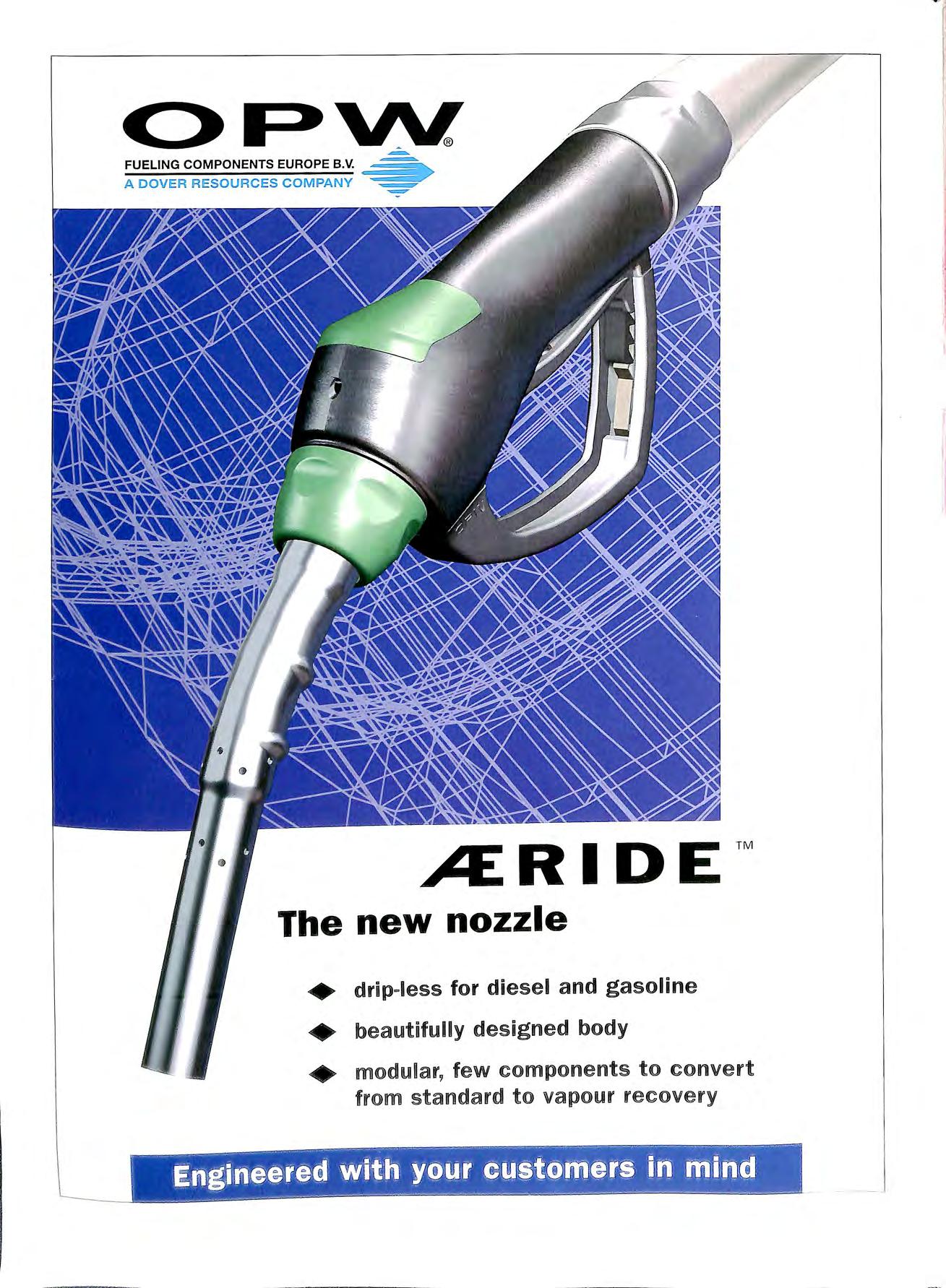
nozzle
new . • for d g asoline diesel an ·gned body beautifully des1 to convert +
+ modular? few vapour recovery from standar---·- ----· ' Ii id
The
ponents
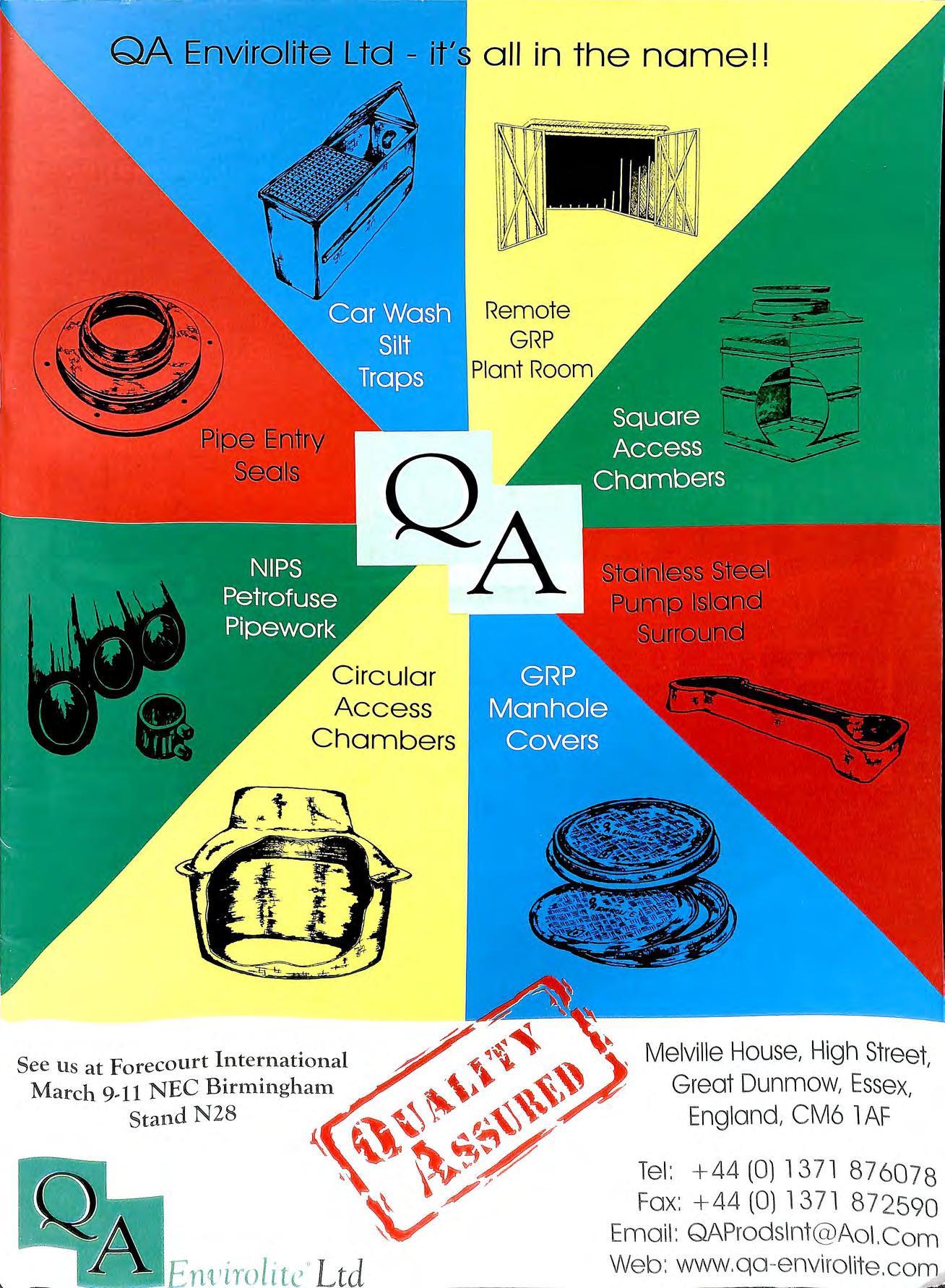
all in the name!! Circular Access Chambers Remote GRP \ See u s at Forecourt International 'ii ""1' , March 9-11 NEC Birmingham Stand N28 Melvill e House, High Street Great Dunmow, Essex, Eng land, CM6 l AF I "' , \.,.,,,.... '/ Tel: +44 (0) 1371 8760 78 Fax: +44 (0) 137 1 8 72 590 Ent 'irolitc "Lt d Emai l: QAPro d slnt@ Aol .C om Web: www .q a -e nvi ro lite.c om
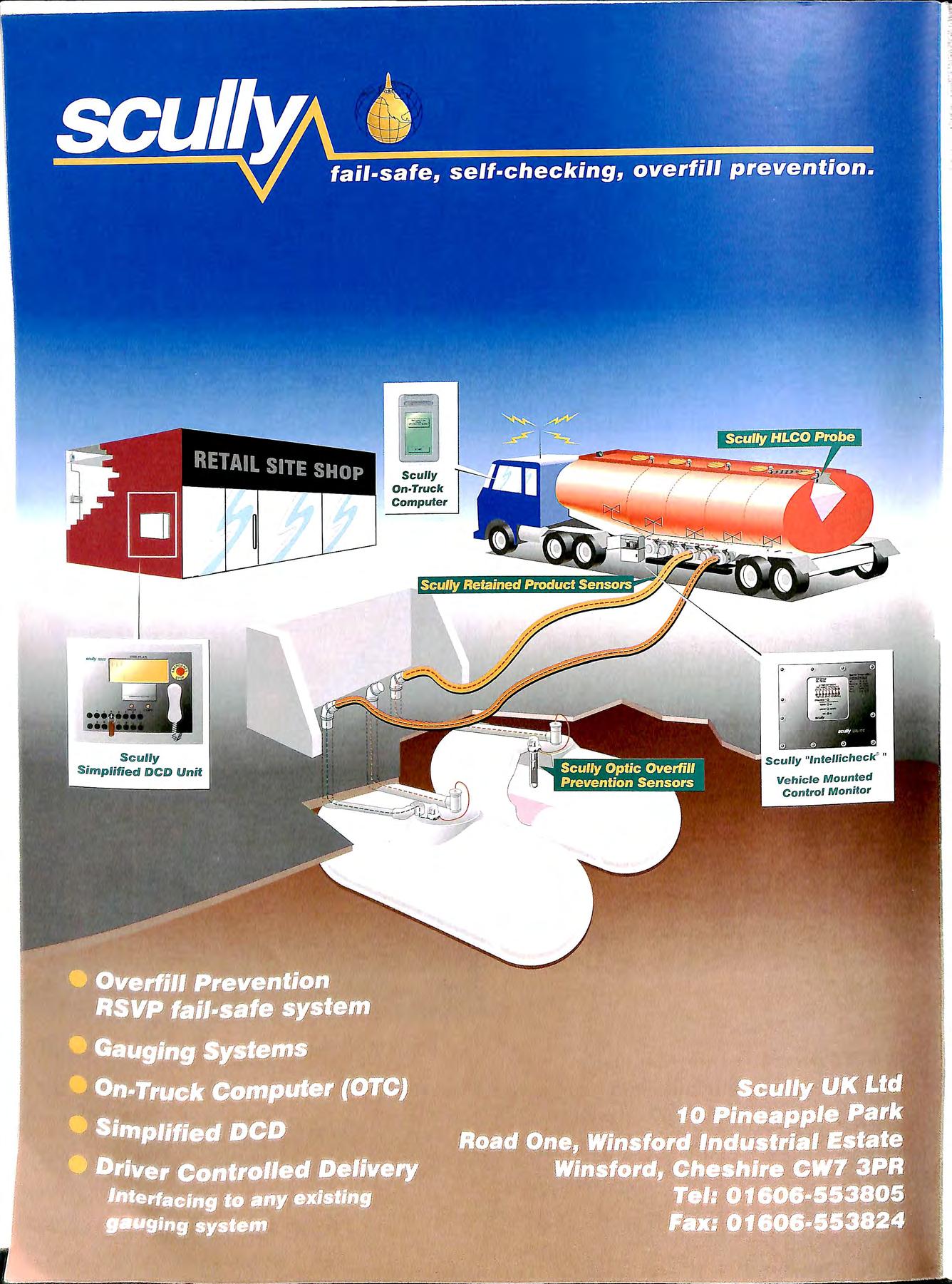
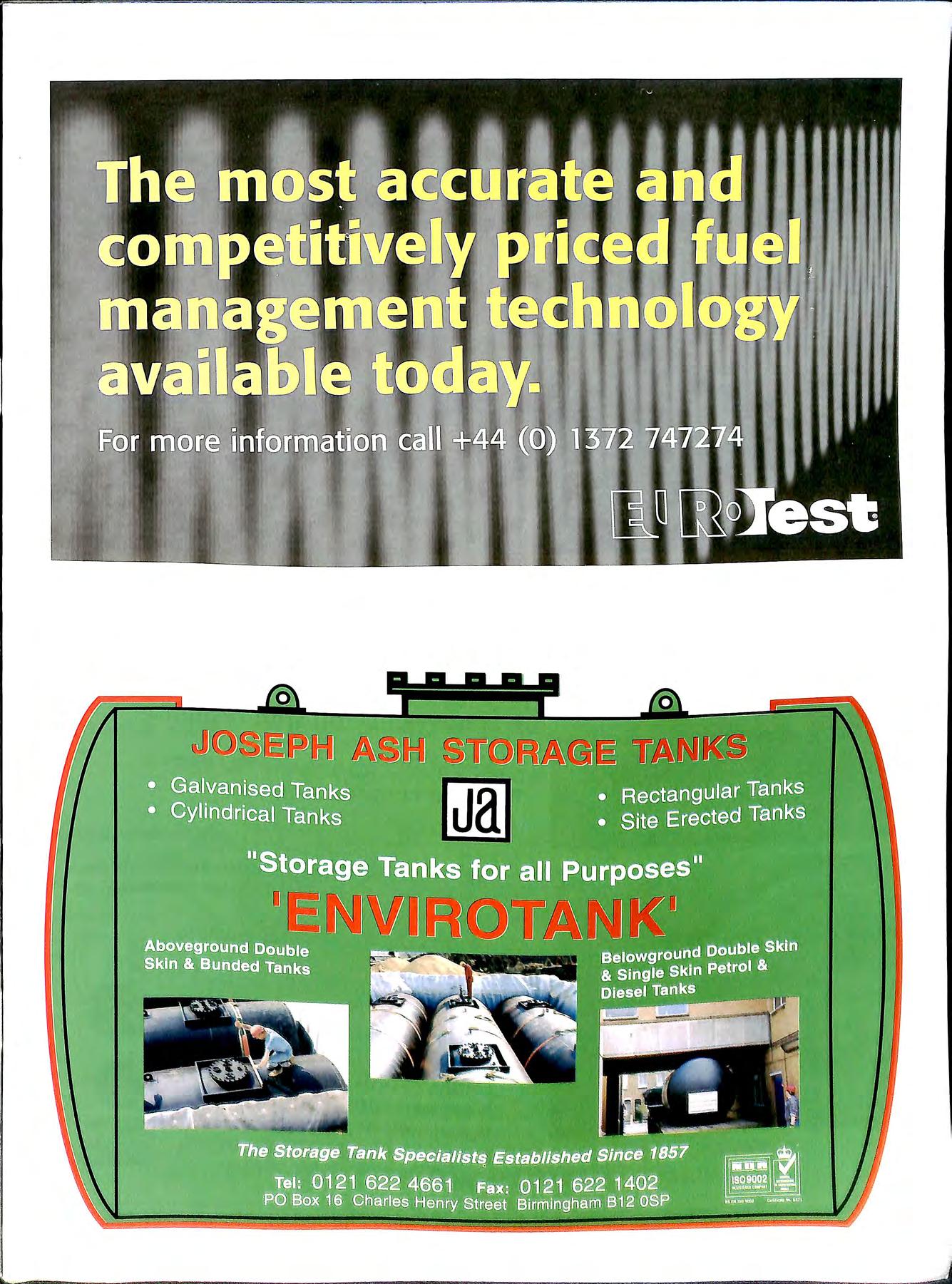
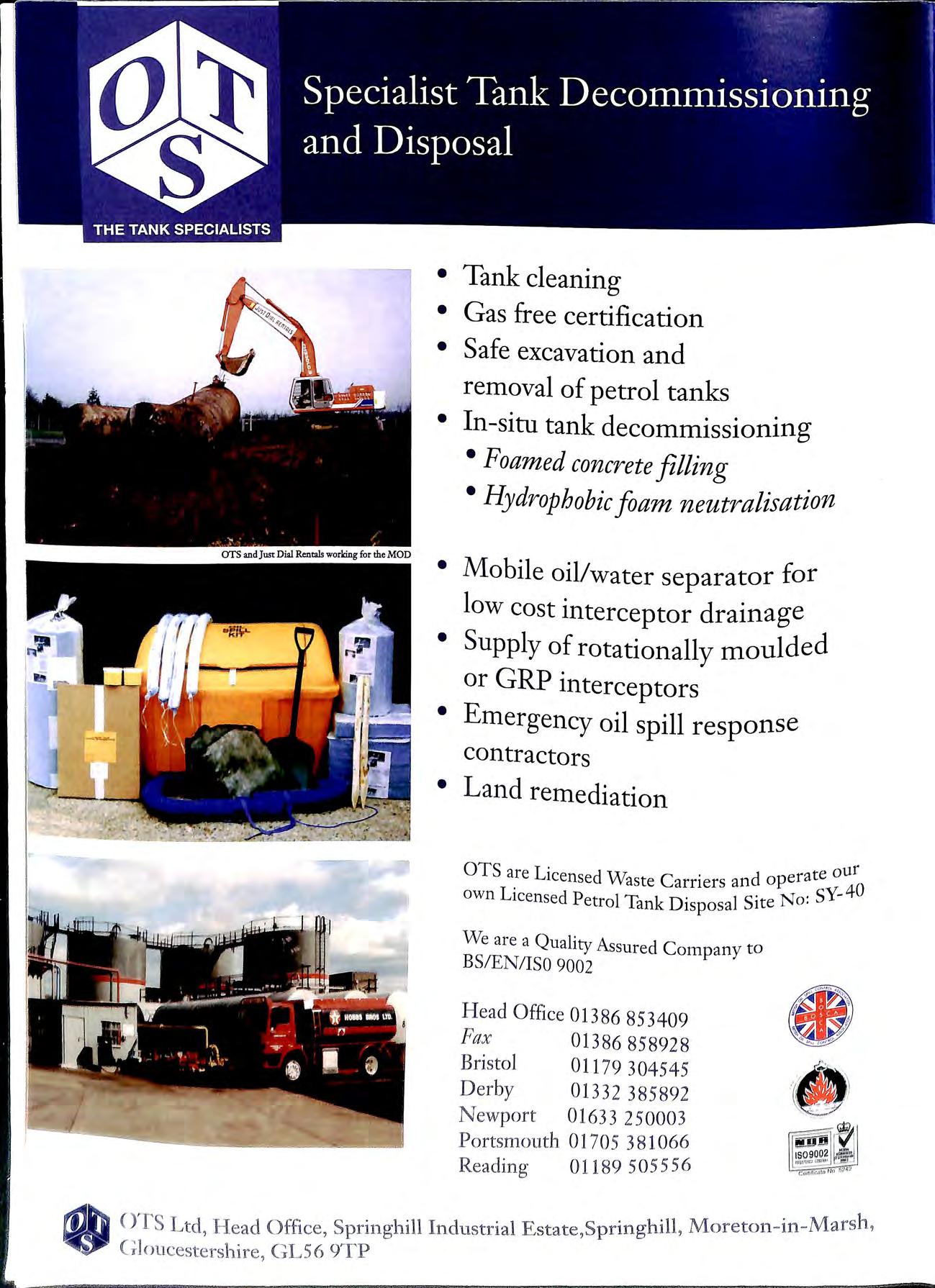
• Tank cleaning • Gas free certification • Safe excavation and removal of petrol tanks • In-situ tank decommissioning •Foamed concrete filling • Hydrophobic foam neutralisation • Mobile oil/water separator for low cost interceptor drainage • Supply of rotationally moulded or GRP interceptors • Emergency oil spill response contractors • Land remedia tion OTS L' d rate our are icensed Waste Carriers an ope 40 own Licensed Petrol Tank Disposal Site No: SY W e are a Quality Assured Company to E S/E N /ISO 9002 He ad O ffi ce 0 138 6 85 3409 Fax 013 86 858 928 Bris t ol 011 79 304 54 5 Derby 0 1332 385892 New port 01633 25 0 003 Portsmouth 0170 5 381066 Reading 01189 50 5 5 56 fi'lh L td, Offi ce , Springhill Industrial Estate,Springhill , Moreton in Ma rs h? • (Tloucestersh 1re , G L S6 9 f P

Hig h integrity pipework systems for fo recourt installations Distributed by • No 1 UK manufacturer of polyethylene pipes • Superior electrofusion jointing system • High flow rates • Available in four sizes for suction and pressure systems " Competitive prices • Nationwide delivery PURFLEET FORECOURT SERVICES LTD PURFLEET FORECOURT SERVICES 520 Lond on Road , West Thurrock, Grays, Essex RM20 38E Tel: 01708 863931 Ext. 219 Fax: 01708 864140 e-mail: purfleet forecourt services@harris-group.co uk LEDBURV WELDING & ENGINEERING LTD. lw -. NETHERWOOD ROAD, __ _ ROTHERWAS INDUSTRIAL ESTATE, (TEI..: 01432-275566) HEREFORD HR2 6JU (FAX : 0 1432-358493) A COMPLETE RANGE OF ABOVE & BELOW GROUND STORAGE VESSELS QUAUTY UNDERGROUND TANIKS QUAUlY UNDIERGROUNID TANIKS SPEC iA U ST D OU B L E A ND SINGL E SKIN L EAK DET ECTION OVER FILL PR EVENTIO N DEVICES MANWAY ACCESS FRAMES M U LTIPLE COMPARTMENTS AB GR UN · 5 FU 1 DERV PACKS 9 600 G ·

FROM SOME OF THE WORLD'S LEADING MANUFACTURERS Refurbishment & Retrofit Services Vapour Recovery Systems Petroleum Pipe Systems Drainage Products & Interceptors Paving Jet Wash & Air Systems Petrol Hose & Fixings Access & Inspection Chambers Tanks GRP Lightweight Covers Galvanized Steel Covers Double Skin Tanklining Signage Silt Traps GRP Multi Purpose Plant Rooms Pipe Entry Seals Pump Island Surrounds Forecourt Furniture .................................................... And even more el: 44 71876078 Fax: +44 (0) 125 Po Box 4153, Melville House, High Street, Great Dunmow, Essex, CM6 1WE E-Mail: QAProdslnt@Aol.com Web: www.qa-envirolite.com Som e supp li ers bes t enginee rin g fo r a Seco nd aryCont ained Tee Our engineering. We run the R&Dgivin g yo u: Cos t saving Ti me savi11 g Yo ur cho ice f) I ' I I I ' ! \ I " II\\ \ ll I 1 II I · IJllMW'IM ': 'i',1' ''',I' PETROL PIPE SYSTEM Pho1H:' Hh I W l)() 1·a, + 1h l llh .;o
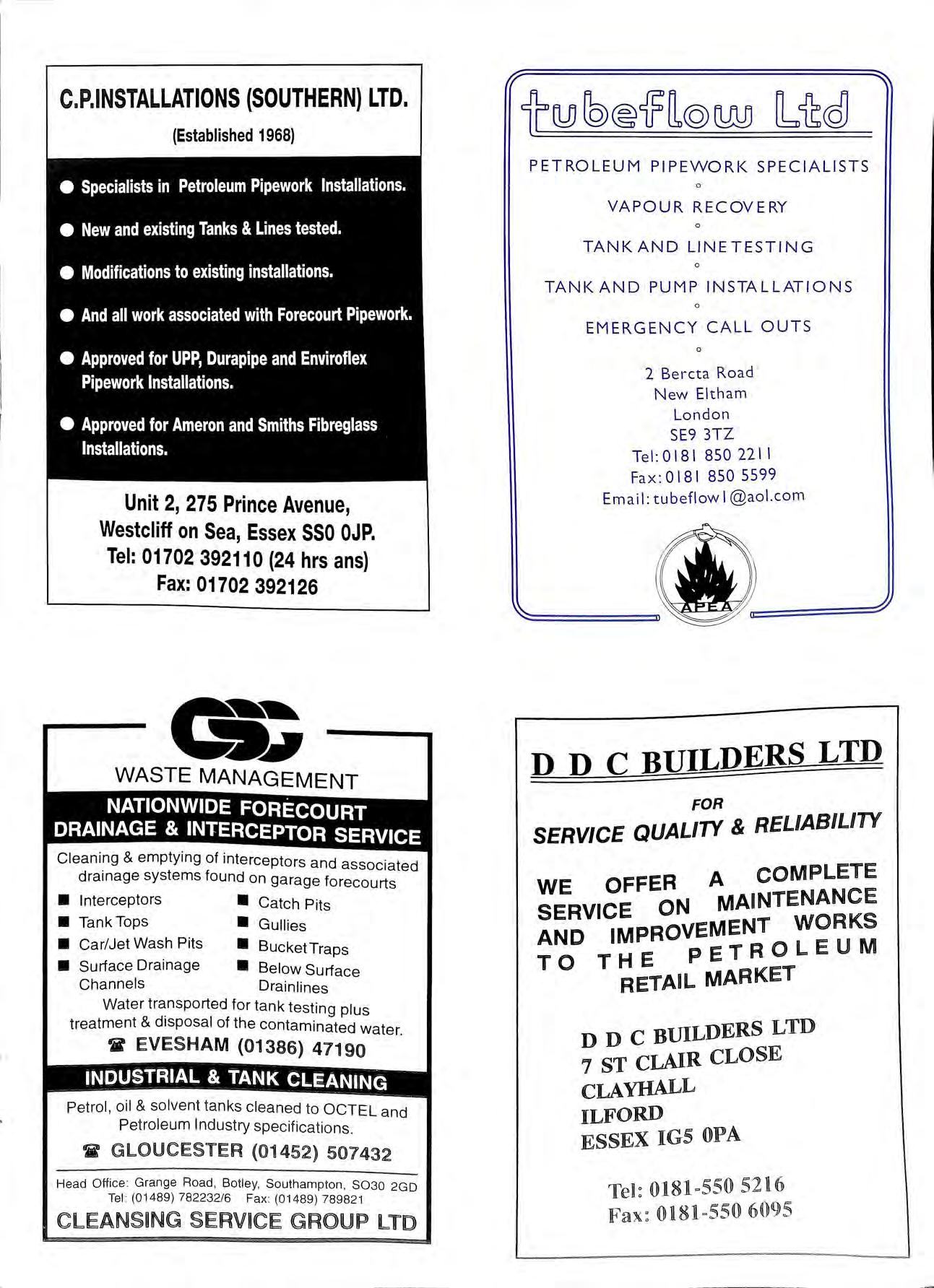
C.P.INSTALLATIONS (SOUTHERN) LTD. (Established 1968) • Specialists in Petroleum Pipework Installations. • New and existing Tanks & Lines tested. • Modifications to existing installations. • And all work associated with Forecourt Pipework. • Approved for UPP, Durapipe and Enviroflex Pipework Installations. • Approved for Ameron and Smiths Fibreglass Installations. Unit 2, 275 Prince Avenue, Westcliff on Sea, Essex SSO OJP. Tel: 01702 392110 (24 hrs ans) Fax: 01702 392126 WASTE MANAGEMENT NATIONWIDE FORECOURT DRAINAGE & INTERCEPTOR SERVICE Cleaning & emptying of interceptors and associated drainage systems found on garage forecourts • Interceptors • Catch Pits • Tank Tops • Gullies • Car/Jet Wash Pits • BucketTraps • Surface Drainage • Below Surface Channels Drainlines Water transported for tank testing plus treatment & disposal of the contaminated water. if EVESHAM (01386) 47190 INDUSTRIAL & TANK CLEANING Petrol, oil & solvent tanks cleaned to OCTEL and Petroleum Industry specifications W GLOUCESTER (CH 452) 507432 Head Office : Grange Road , Batley, Southampton, S030 2GD Tel (01489) 782232/6 Fax (01489) 789821 CLEANSING SERVICE GROUP LTD PETROLEUM PIPEWORK SPECIALISTS VAPOUR RECOVERY TANKAND LINETESTING 0 TANK AND PUMP INSTALLATIONS EMERGENCY CALL OUTS 0 2 Bercta Road New Eltham London SE9 3TZ Tel : 0 1818502211 Fax : Ol81 850 559 9 Email : tu b eflow l @aol.com D DC BUILDERS LTD FOR E Qu1ALl7Y & RELIABILITY SERVIC 1-1 A COMPLETE WE OFFER AINTENANCE SERVICE WORKS AND IMPRO ET R o L E U M TO THE p T RETAIL MARKE D DC BUILDERS LTD 7 ST CLAIR CLOSE cLAYHALL ILFORD ESSEX JG5 OPA TeB: 01 8 1 -55 0 52 Hi Fa x: OHn -55 0 609 5

Forecourt Specialists Electrical Maintenance Design Testing Unit2 Gregorys Bank Trading Est ate Wor ce st e r WR3 8AP TEL: 01905 28402 FAX: 01905 28410 = .,,,_. _, == -=i =i = = = -FOAM SPECIALIS TS RESIN GENERATED FOAM FREEPHONE: 0800-592-573 FAX: 01639-821-651 Fo r safe hand ling and disposa l. CA LL U S FIRST W E H AVE OVER 25 YEAR S EXPERIENCE IN THE PETROLEUM INDUSTRY A ND WORI< H ARD TO GIVE YOU A QUALITY, PERSONA L SERVICE Professional developme nt TRAINING IN-COMPANY SHORT COU RS ES • Electrical Requirements for Petrol Filling Stations • Management overview of HSW Statutory Regulations, including : · Management of Health & Safety at Work Regs (MHSWR) Workplace Hea lth, Safety and Welfare Reg s (WHSWR) Provision & Use of Work Equipment Regs (PUWER) Personal Protective Equipment at Work Regs (PPER) • Essentials of Health & Safety at Work Sites • Introduction to Health & Safety Risk Assessment • ELECTRIC/TY AT WORK REGULATIONS (EWR) • Construction (Design & Management) Regs (CDM) • BS7671 Requirements for Electrical Install atio ns (16th Edition Wiring Regulations) • Inspection and Testing of In-Service Electrical Installations • EARTHING AND BONDING Reviews a wide range of national Cod es of Practice and Statutory Req uirements Prese nter: TERRY HEDGELAND BA. FIEIE. M IQA Member of APEA anJ !OP Phone: 01737 553328 BUILDERS TO THE PETROLEUM INDUSTRY • FORECOURT INSTALLATION INCLUDING STEEL & PLASTIC PIPEWORK • SHOP REFURBISHMENTS • ELECTRICAL INSTALLATION • MAINTENANCE AND REPAIR 01269 831038 FAX (01269) 831201 A cer Court , Cross Hand s Business P ark , Cross Hands ,Carmarthenshire The Assoc iation for Petroleum and Explosives Admin istration SA 14 6RE /.}\·U.,'.' •
The introduction of Petrol-Line Vent Plus and Petrol-Line Plus Offset and Fill pipes provides cost effective Offset Fill and vent systems which comply fully with the IP Specification requirements.
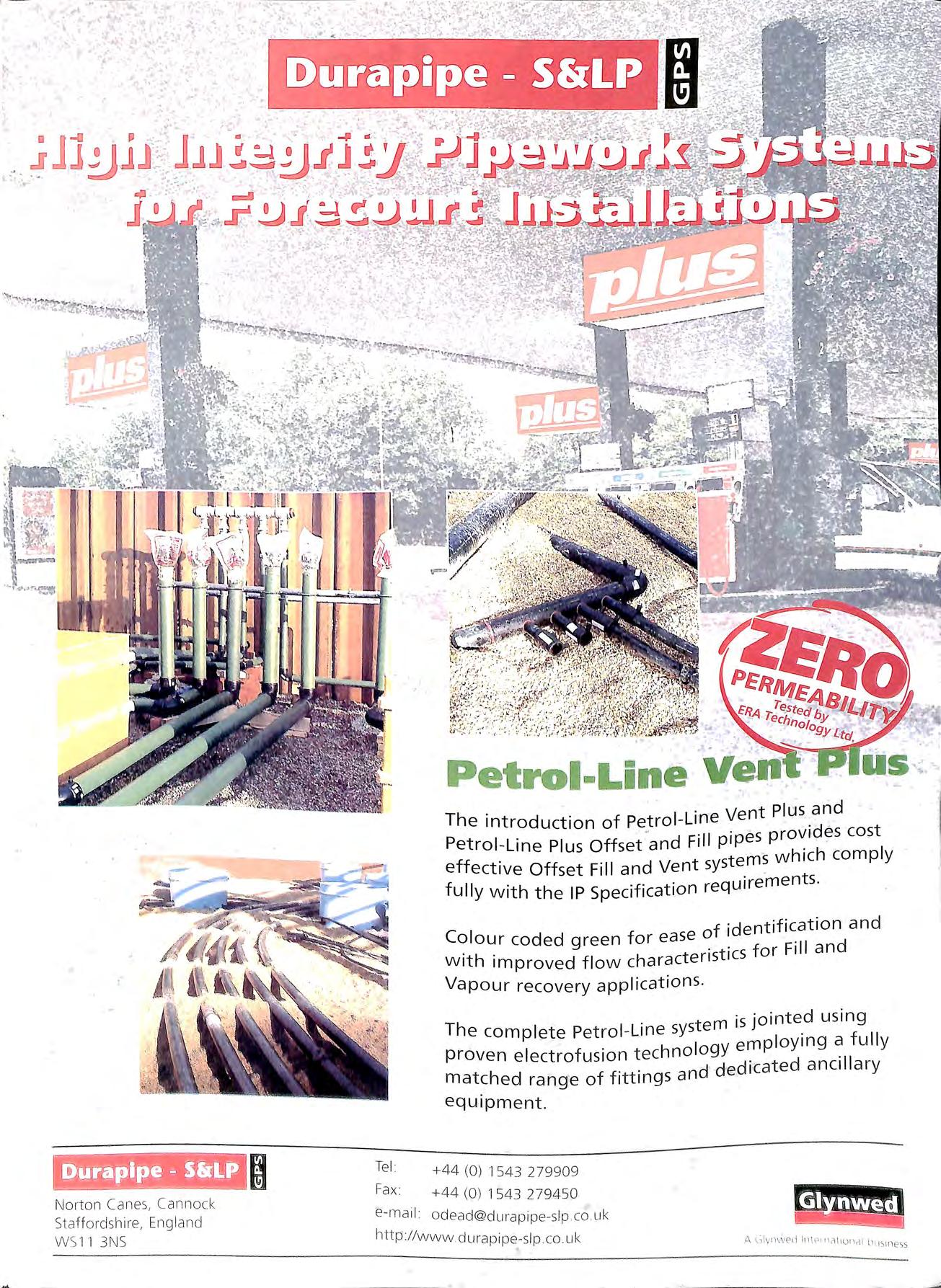
Colour coded green for ease of identification and with improved flow characteristics for Fill and Vapour recovery applications.
The complete Petrol Line system is jointed using proven electrofusion technology employing a fully matched range of fittings and dedicated ancilla ry equipment .
+ 4 4 (0) 1543 279909 +44 (0) 1 543 279450 e-m ail d · 0 ead@durap1pe-slp co uk http// · ww w durapipe-s lp co uk
, ' ..·., Norto n Ca ne s, Cannock Sta ff m dshi1 e, Englan d w s·11 3 NS Te l Fax
.i\ ljly11wed ln\P•11illion 11 l r )U51 n e55
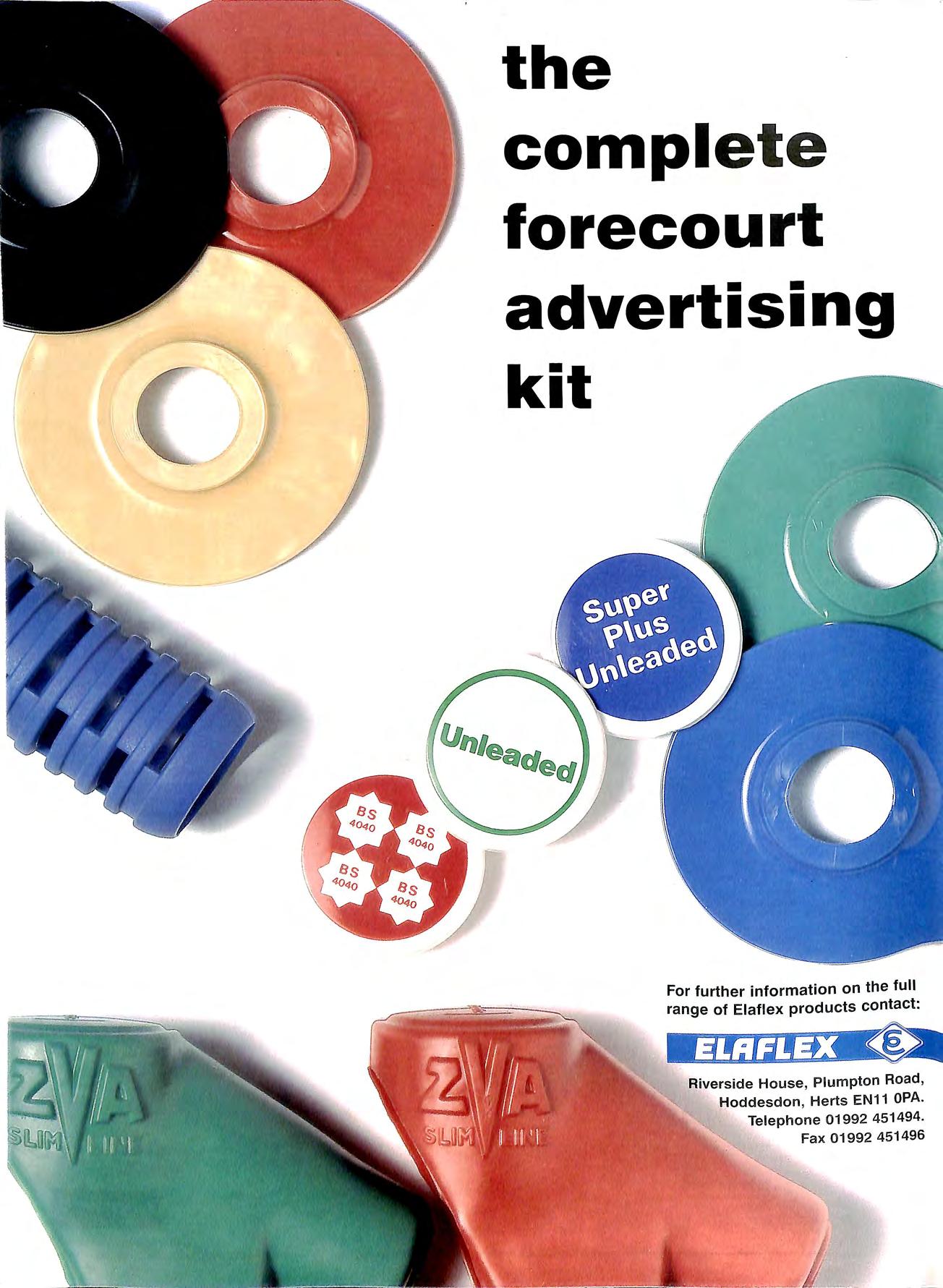
the complete forecourt advertising kit For further information on the full range of Elaflex products contact: Riverside House , Plumpton Road, Hoddesdon, Herts EN11 OPA. Telephone 01992 451494. Fax 01992 451496

I Engineers Petrol, Fuel Oil and Electrical Installations 11/12 HODFAR ROAD, SANDY LANE INDUSTRIAL ESTATE, STOURPORT-ON-SEVERN DY13 9QB TELEPHONE: 01299 824541-2-3 FAX: 01299 827638 SPECIALISING IN ALL ASPECTS OF FORECOURT PETROLEUM INSTALLATIONS, SERVICING AND ELECTRONIC TANK TESTING FULLY ACCREDITED TO BS EN ISO 9002: 1994 Care For The Environment... Make Forecourts A Safer Place To Work And Visit... Provide Quality Solutions To Forecourt Engineering Problems... VAPOUR RECOVERY PRESSURE VACUUM VALVES VAPOUR LOSS REDUCTION SYSTEMS UNDER PUMP/CHECK VALVES DESIGN & DEVELOPMENT INSITE LINE TESTIN G IDS STOP • OVERFJILL PREVENTION DEVICE lUSBRlID GER ll'D . Stychens Lane, BRetclhin8n·ey, Su ney RJHI 1 4LN Tell : ( +44 0188 3 743107 lFax: ( +44 m.88 3 744342
so much better with the Sofita m tou ch
Sofitam Pump Services Ltd

' ' / NASH N a s h & Partners ha ve bee n wo rk ing in partnership w ith th e Re tail Pe tro le um in du s try for a lmos t thirty yea rs, p lannjn g and d eve lopin g re ta il in s ta llat ion s from a s tra ig h tfo r w a rd pump c han ge to Eu rope 's larges t fillin g s tation. Eve ry s te p o f t he w a y, fr o m fe as ibilit y studies and s ur ve y ing, p ro jec t managem e nt a nd co mmi ss io nin g, we take ca1 e o f eve ry d e ta il W h e th e r a m a jor o il co mp a n y o r an indi vidu a l deal e r, o ur cli e nts are ass ur ed o f th e N a sh co mmitment to quality and a dh e re nce to 13S5 750, ba c ke d by up to-th e-minute te chno logy, inn ova ti o n a n d ex p e rti se Fro m a g ree nfi e ld s ite to a fu lly o p e ra t io n a l in s tallation, Nas h & Pa rtn e rs d e live r cre ati ve ye t hi g hl y pra cti cal so luti on s + A RC H JTECTS • SU RVEYO RS • TOWN PLANNERS • PRO JECT MA AGE RS <# PROPERTY CONSU LTANTS NAS H & P A RTNE RS S ta tion S o uth gat e + Ch ic hester+
rts work
projects undertaken including construction and pipework installation
fuel dispensing equipment, tanks
items.
installers
equipment.
effective service
vapour recovery maintenance.
quality refurbished equipment. c
Forecou
Major
- NATIONWIDE. Suppliers of
and all associated
Suppliers and
of LPG
Cost
and maintenance, tailored to individual requirements including
High
Boatyard, Old Shoreham Road, Shoreham
Sea, West Sussex. BN43 STA. ACTION LINE: 01273 454831 Fax 01273 464863 Regional Office: 132 Gulson Road, Coventry CV1 2JF Tel : 01203 633312 Email sales@sofitam.com www.sofitam.com
Adur
by
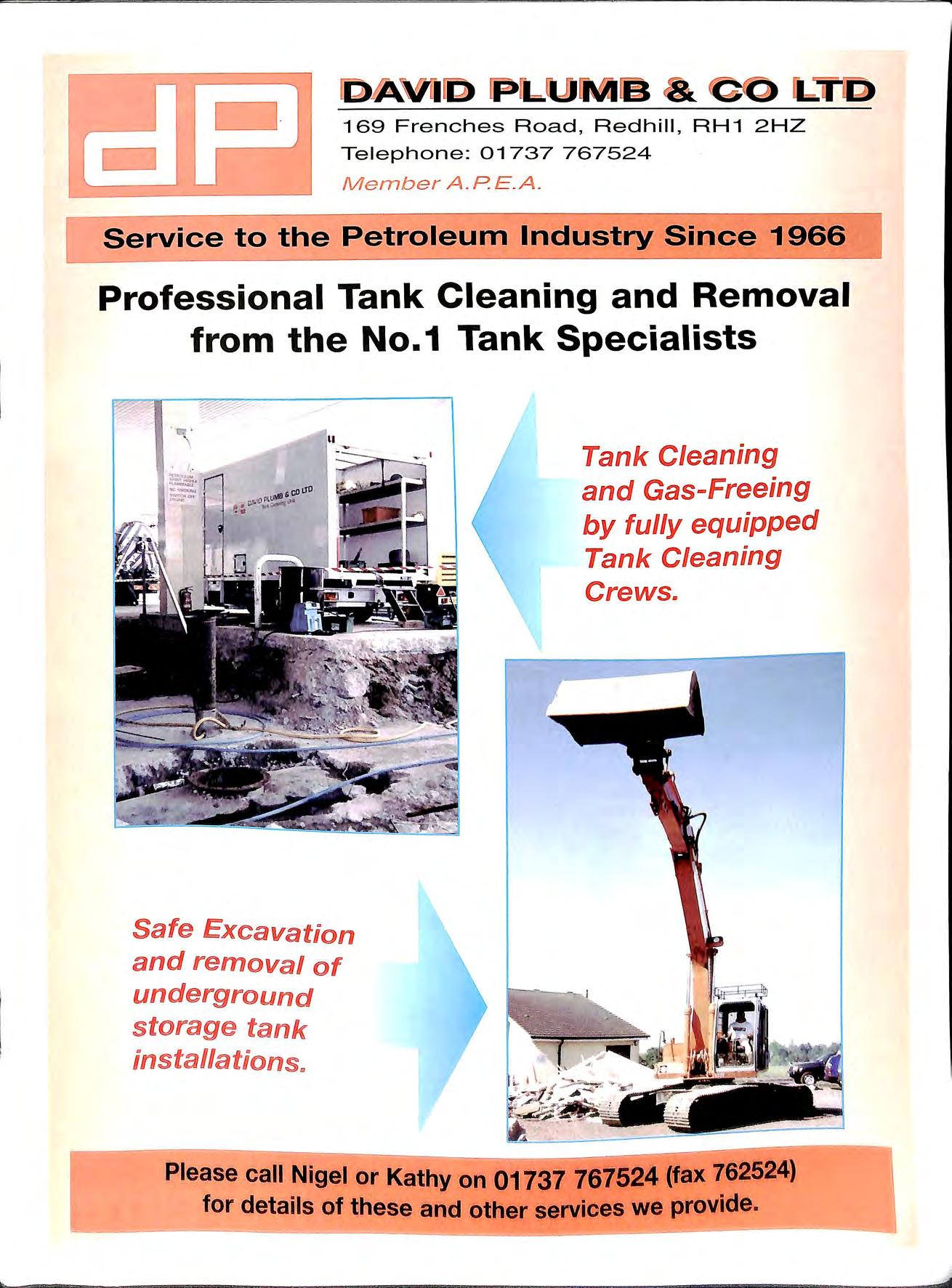
PLUMB &. CO L: D 169 Frenches Road, Redhill, RH1 2HZ Telephone: 01737 767524 Memb e r A . PE . A. Service to the Petroleum Industry Since 196 6 " Professional Tank Cleaning and Removal from the No.1 Tank Specialists afe Excavation and removal of underground storage tank instaliations ,, Tank Cleaning and Gas-Freeing by fully equipped Tank Cleaning Crews. Please call Nigel or Kathy on 01737 767524 (fax 762524} for details of these and other services we provide.
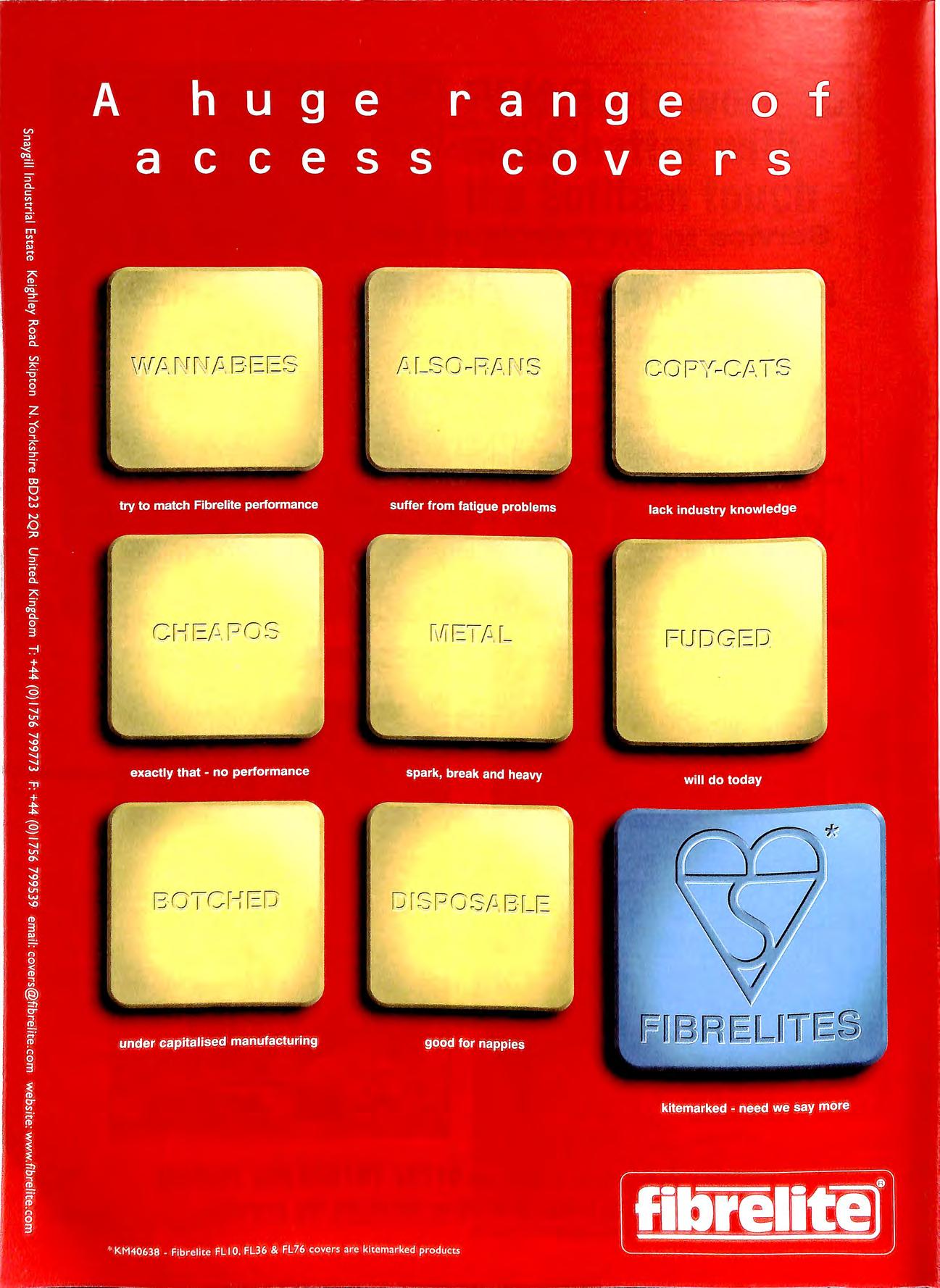
1-U D<G E D
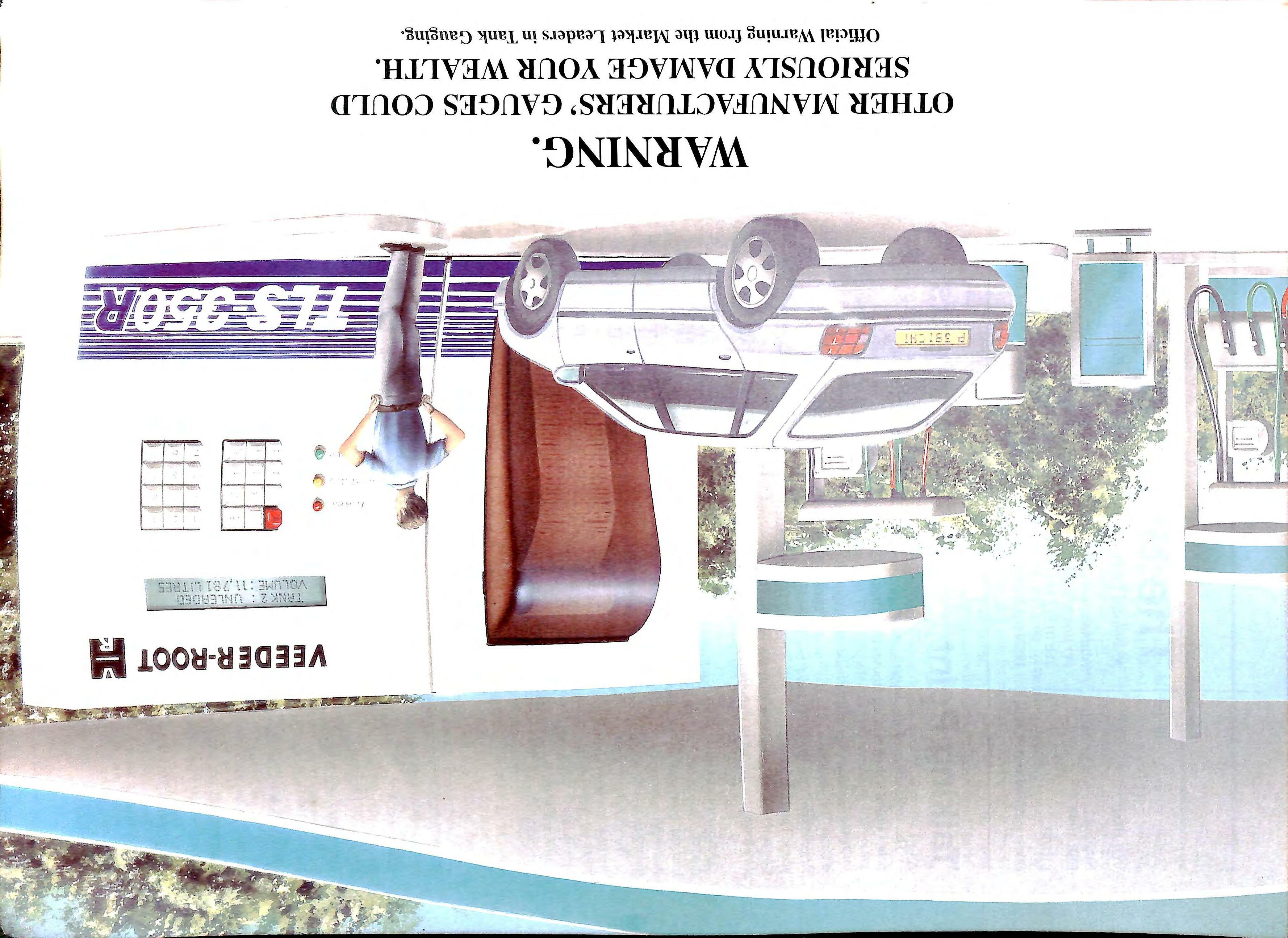
t .WARNING. OTHER MANUFACTURERS' GAUGES COULD SERIOUSLY DAMAGE YOUR WEALTH. Official Warning from the Market Leaders in Tank Gau ging. VEEDER-ROOT tl T s:;t :K-Z : UML\:ftUEU H ;Jf;1. Lrl'Z-1.CS I i.-\----"'.'""'--; _., ( -...
Published by the Association for Petroleum and Explosives Administration
The Bulletin
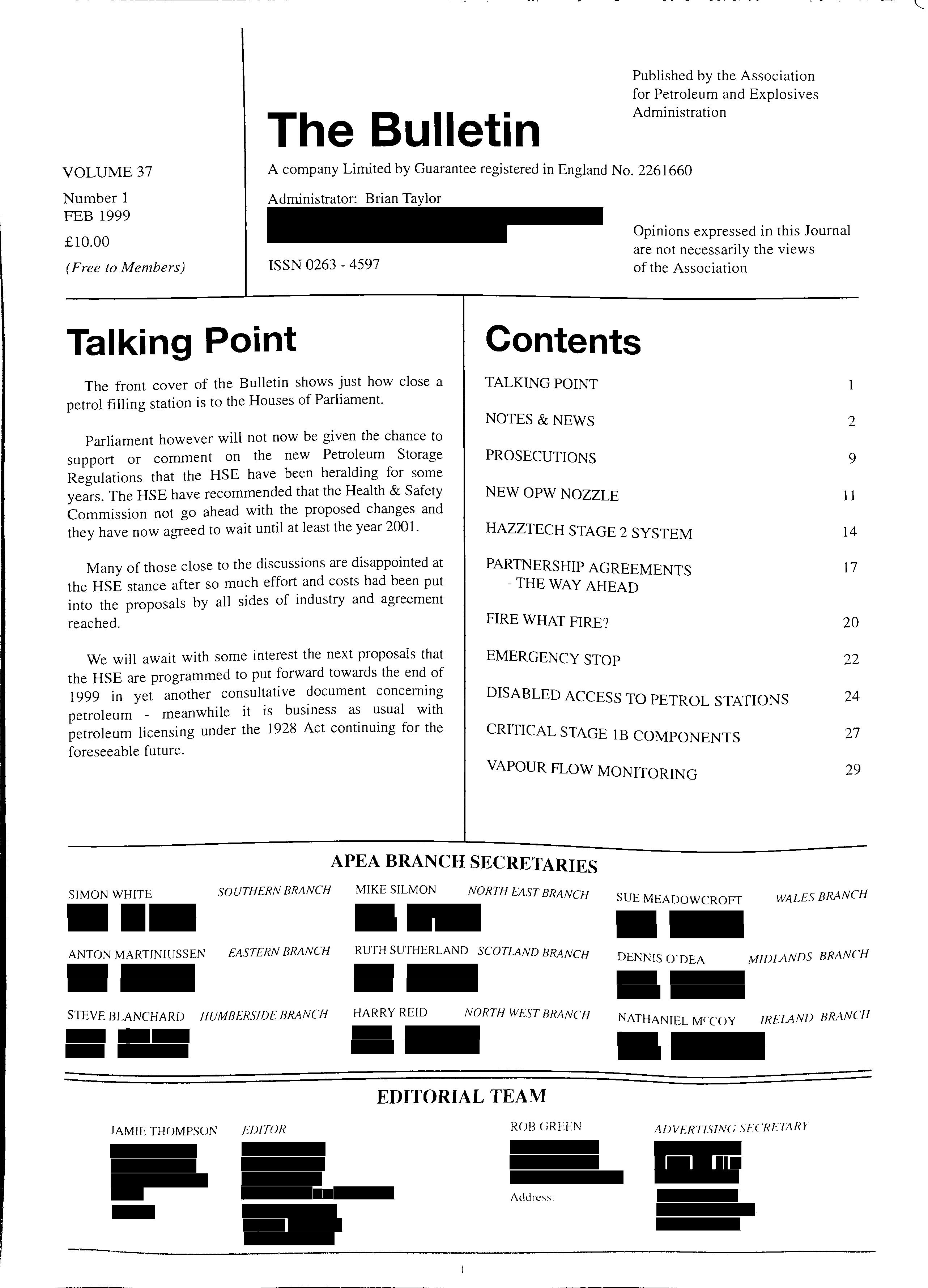
A company Limited by Guarantee registered in England No. 2261660
Administrator: Brian Taylor
Opinions expressed in this Journal are not necessarily the views (Free to Members)
£10.00
ISSN 0263 4597
Talking Point
The front cover of the Bulletin shows just how close a petrol filling station is to the Houses of Parliament.
Parliament however will not now be given the chance to support or comment on the new Storage Regulations that the HSE have been heraldmg for some years. The HSE have recommended that the Health & Safety Commission not go ahead with the proposed changes and they have now agreed to wait until at least the year 2001.
Many of those close to the discussions are disappointed at the HSE stance after so much effort and costs had been put into the proposals by all sides of industry and agreement reached.
We will await with some interest the next proposals that the HSE are programmed to put forward towards the end of 1999 in yet another consultative document concerning petroleum meanwhile it is business with petroleum licensing under the 1928 Act contmumg for the foreseeable future.
TALKING POINT
NOTES&NEWS
PROSECUTIONS
of the Association
VOLUME37
Number 1 FEB 1999
Contents
NEW OPW NOZZLE HAZZTECH STAGE 2 SYSTEM PARTNERSHIP AGREEMENTS -THE WAY AHEAD
APEA BRANCH SECRETARIES 2 9 11 14 17 20 22 24 27 29
WHITE SOUTHERN BRANCH MIKE SILMON NORTH EAST BRANCH SUE MEADOWCROFT WALES BRANCH
MARTINIUSSEN EASTERN BRANCH RUTH SUTHERLAND SCOTLAND BRANCH DENNIS O'DEA MIDLANDS BRANCH
BLANCHARD HUMBERSIDE BRANCH HARRY REID NORTH WEST BRANCH NATHANIEL MC'COY !RELAND BRANCH
FIRE WHAT FIRE? EMERGENCY STOP DISABLED ACCESS TO PETROL STATIONS CRITICAL STAGE 1B COMPONENTS VAPOUR FLOW MONITORING
SIMON
ANTON
STEVE
EDITORIAL TEAM EDITOR ROB CJREEN AOVERT!SIN<i SFCRFTAR}'
JAMIE
THOMPSON
ADMINISTRATORS NOTES
1999 Membership renewals
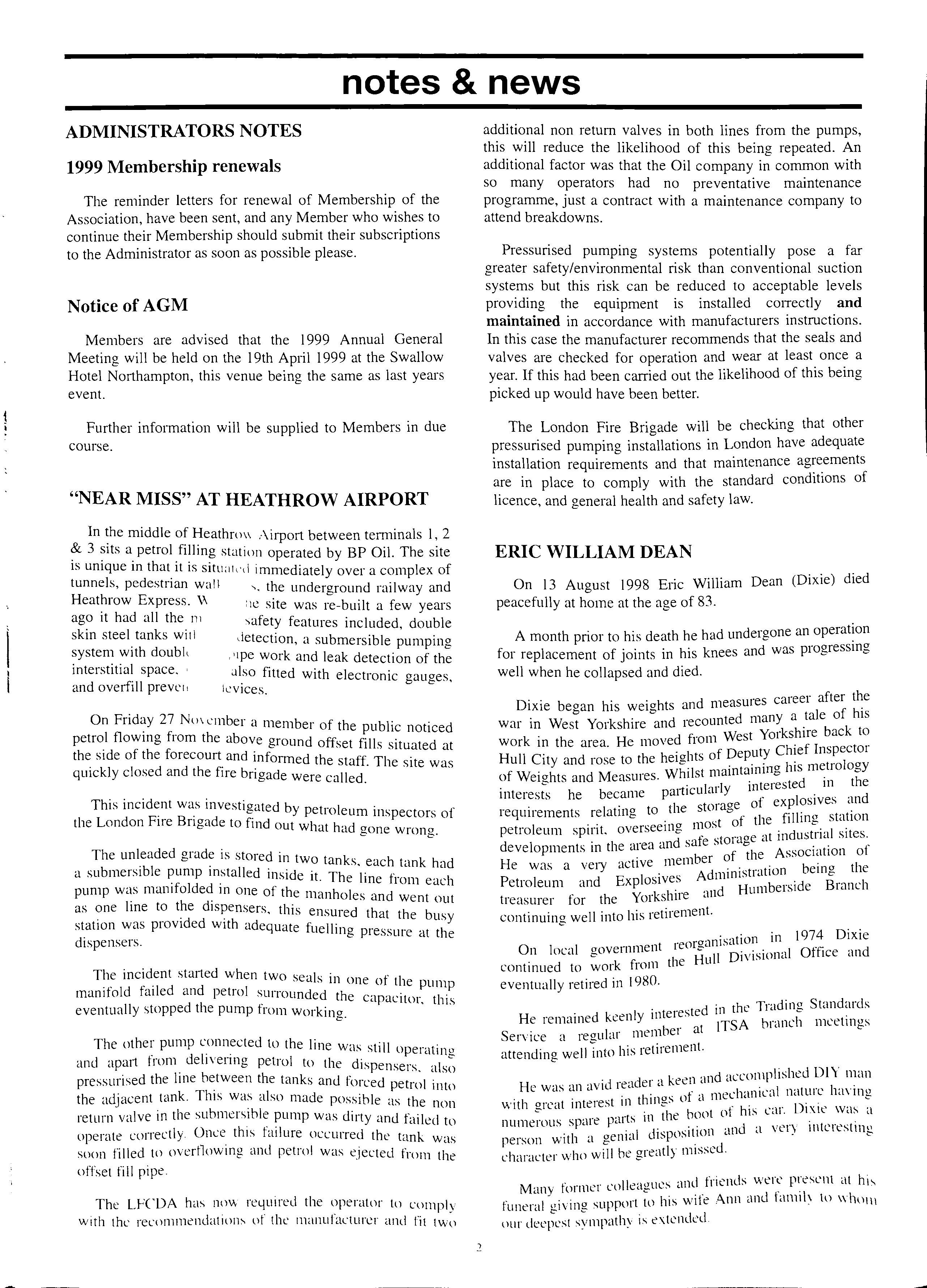
The reminder letters for renewal of Membership of the Association, have been sent, and any Member who wishes to continue their Membership should submit their subscriptions to the Administrator as soon as possible please.
Notice of AGM
Members are advised that the 1999 Annual General Meeting will be held on the l 9th April 1999 at the Swallow Hotel Northampton, this venue being the same as last years event.
Further information will be supplied to Members in due course.
"NEAR MISS" AT HEATHROW AIRPORT
In the middle of Heathrn\\ Airport between terminals 1, 2 & 3 sits a petrol filling station operated by BP Oil. The site is unique in that it is situ;1kd immediately over a complex of tunnels, pedestrian wan '· the underground railway and Heat?row Express. \\ 11e site was re-built a few years ago it had all the Ill safety features included double skin steel tanks witl ,[etection, a submersible ;umping system with double ,11pe work and leak detection of the interstitial space. 1 al.so fitted with electronic gauges, and overfill prevc11 lcv1ces.
On 27 Nm ember a member of the public noticed flowmg from the above ground offset fills situated at the side of the forecourt and informed the staff Th ·t · d . e s1 e was qmckly close and the fire brigade were called.
This incident was investigated by petroletim · f' mspectors o the London Fire Bngade to find out what had gone wrong.
The unleaded grade is stored in two tanks e h t· k h· d 'bi ac an a a submers1 e pump mstalled inside it The 11·n f' h · e rom eac pump was mamfolded 111 one of the manholes d · an went out as one !me to t?e dispensers, this ensured that the bus st.ation was provided with adequate fuelling pressure at dispensers.
The incident started when two seals in one f' th . d d o e pump manifold faile an petrol the capacitor. this eventually stopped the pump from working.
The other pump connected to the line was still 1· · · opeia mg and apart from. dehvenng petrol to the dispensers. also pressurised the !me the tanks and forced petrol into the adjacent tank. This was also made possible as the non return valve in the submersible pump was dirty and failed to operate correctly. Once this failure occurred the tank was soon filled to overflowing and petrol was ejected from the offset fi II pipe.
The LFCDA has now required the operator to comply with the recommendations of the manufal'lurer and fit twn
additional non return valves in both lines from the pumps, this will reduce the likelihood of this being repeated. An additional factor was that the Oil company in common with so many operators had no preventative maintenance programme, just a contract with a maintenance company to attend breakdowns.
Pressurised pumping systems potentially pose a far greater safety/environmental risk than conventional suction systems but this risk can be reduced to acceptable levels providing the equipment is installed correctly and maintained in accordance with manufacturers instructions. In this case the manufacturer recommends that the seals and valves are checked for operation and wear at least once a year. If this had been carried out the likelihood of this being picked up would have been better.
The London Fire Brigade will be checking that other pressurised pumping installations in London have adequate installation requirements and that maintenance agreements are in place to comply with the standard conditions of licence, and general health and safety law.
ERIC WILLIAM DEAN
On 13 August 1998 Eric William Dean (Dixie) died peacefully at home at the age of 83.
A month prior to his death he had undergone an for replacement of joints in his knees and was progressmg well when he collapsed and died.
Dixie began his weights and measures career after war in West Yorkshire and recounted many a .tale of his work in the area. He moved from West Yorks?!fe back Hull City and rose to the heights of Deputy of Weiahts and Measures. Whilst maintaining otghy "' · 1 ly intereste 111 e interests he became particu ar 1 · d he storage of exp os1ves an 1equuements relatmg to . t . f ·h filling station . 1 . . .· seemg most o t e . pet10 eum spmt. over t industrial sites. d 1 . h . and safe stmage a eve opments m t e ruea · f h Association of He was a very active member . tt ·et1'on beina the 1 · es Adm1111s 1a "' Petroleum and Exp osiv . , nd Humberside Branch treasurer for the Yorkshll"e ,l continuina well into his retirement.
"'
·n 1974 Dixie ent reorganisation 1
·
On local govemm h Hull Divisional Office and continued to work from t e eventually retired in I 980.
. t d in the Trading Standards H · d k'enly mteres e e 1emame t: at lTSA branch mcetmgs Service a regular membei attendina well into his retirement. "' . . d keen and accomplished DIY man
He was an avid el " . if ·1 mechanical nature having with great interest m t 1mgs l ' t' h' "11' Dixie w·1s ·1rts in the boot o is L, , '. ' numerous spaie P' · · d 1 ver\' intcrestitl" ··1 dispos1t1on an ' · :=- person with a gema · character who will be greatly nussecl.
Many former colleagues anl.l _friends p1.·esL'nt at t 1 · · 1a ·tiripl11·t Ill 111·s w11e Ann and fa1111 l\ to whom unera g:1v11 :=- s , · · our deepest sympathy is extended.
notes & news
ENVIRONMENTAL PROTECTION ACT 1990,
ADDITIONAL GUIDANCE ISSUED BY THE DEPARTMENT OF THE ENVIRONMENT, TRANSPORT AND THE REGIONS AND THE WELSH OFFICE
PETROL STATIONS WITH OLDER TYPES OF TANK GAUGING
The Departments have become aware of the potential for unsafe working conditions to arise when Stage I systems are fitted to service stations using dip tubes or hydrostatic gauging. After evaluating the evidence and receiving advice from the Health and Safety Executive, the Departments have decided to modify their advice in PGl/14(96) the Unloading and Storage of Petrol at Service Stations. To the extent that this note qualifies Clause 11 of PG 1/14(96), it should be treated as guidance under section 7(11) of the Environmental Protection Act 1990.
In Clause 11 it is stated that all of the petrol vapour displaced by the delivery of petrol must be returned to the mobile tanker. It does not prohibit, however, the venting of petrol vapour otherwise than during petrol deliveries. The Department considers it is permissible to fit the following equipment for safety reasons:
an additional vent rising from the manifold system with a ball stop valve installed allowing it to be opened to relieve pressure on the system prior to tank dipping or gauge reading. The valve should be of the dead man's handle type, with a locking device, to prevent its being left open at any other time.
The valve should be checked to ensure that it is closed before any hose is connected, and should not be opened during delivery.
The Departments expect em1ss1ons from such an arrangement to be kept to a minimum. In any case, the Departments expect that the Stage I systems to operate within the 0.01 % loss by weight criterion stipulated in the EC Directive 94/63/EC. Installations incorporating these arrangements should still be pressure tested before being brought into operation. Nothing in this note absolves operators of the necessity of complying with the Health and Safety at Work etc. Act 1974. and its associated legi sl al ion.
It is not appropriate to permit the installation or operation or this system under any of the following circumstances:
Petrol stations with any gauging type other than hand dipping or hydrostatic gauges not designed to be compatihlc with Stage I equipment:
Any new petrol station: or
Any petrol station subject to redevelopment involving work on underground storage tanks or modifications to tank-related pipework.
ENVIRONMENTAL PROTECTION ACT 1990, PART I
ADDITIONAL GUIDANCE ISSUED BY THE DEPARTMENT OF THE ENVIRONMENT, TRANSPORT AND THE REGIONS AND THE WELSH OFFICE
PROCEDURES FOR TANK CONNECTIONS AT PETROL STATIONS
A query has arisen in relation to clauses 21 and 27 of PG 1/14(96) "Unloading of Petrol into Storage at Service Stations". The clauses detail the order in which hoses should be connected and disconnected during delivery of petrol. One petrol retailer has claimed that the order of connections should be the reverse of that specified in clauses 21and27, for safety reasons.

The Health and Safety Executive has expressed the view that the procedures specified in clauses 21 and 27 of PG 1/14(96) are recommended for safety as well as environmental reasons. The Departments maintain, therefore, that the procedures in clauses 21 and 27 of the note should be adhered to.
NEW BRITISH STANDARD FOR COMPOSITE ACCESS COVERS
BS EN 124/PAS 26 has recently been published to provide specific performance requirements for composite covers on petrol filling stations.
The new Standard incorporates many new technical issues for manufacturers to accomplish in the search for compliance.
The Standard in conjunction with ISO 9000 Quality Systems, offers the opportunity for compliant companies to assure specifiers and regulators that safety and performance have been verified by the British Standards Institute <BSI ).
This is the first independent standard of its type to be published and it is expected to be a world-wide reference point.
PART I
VOLUME EXPANSION OF LIQUID FUELSA PROBLEM?
Volume expansion of liquid fuels The problem of accounting is still with us and provides a continuing set of disputes between retailers and their suppliers. Should we leave the status quo? Should we provide stricter codes of practice? Should we legislate? The questions are clear but what is the best most economic answer to all parties.
All liquids expand and contract with temperature and this presents metering problems for those trading by volume in any liquid whose temperature can vary significantly as it passes along the supply chain. In the case with petrol, the fluid involved is highly volatile, environmentally damaging and sold on with very small profit margins, the issue of temperature expansion losses at the supply point becomes highly contentious.
Apparent stock losses at filling stations can arise from many sources, principally, measurement errors, vapour losses, leakage and thermal contraction. The problem has been addressed over many years but apparently without a satisfactory resolution.
NEL, acting on behalf of National Weights and Measures Laboratory, have been seeking to identify the extent of the thermal contraction problem and then to identify what, if any measures d d ' . · are nee e to overcome the reported unfairness of. As part of the project NEL invite comments, and evidence of constant losses due to temperature shnnkage' of fuels on d 1 fill" e 1very to 1 mg stations or cons1derat1ons of how equ·t bi 11 ,.. 1 a e a owance ior shnnkage can be accounted without ail d b d un ue cost ur en bemg added to the industry.
Any data, opinions or comments are m th 1 · ore an we come but as time 1s short a prompt response is
Technical information or submissions b f · · can e orwarded to:
witnesses. It currently holds the details of more than 3,000 vetted individuals, whose fields of expertise range from accountancy to yacht building, anaesthesia to zoology and acupuncture to zinc the subject index runs to no fewer than 17,OOO entries!
The database is available in three formats: as a book (distributed free of charge to the top 3,000 UK solicitor firms), as Windows-compatible software and now online. Visit our web site at www.jspubs.com to view further information about the Register, browse through our factsheets and newsletter, and try out the on-line Web Registe1:
The UK Register of Expert Witnesses has something to offer both experienced expert witnesses and those seeking their first instruction. Benefits include Your Witness (the quarterly newsletter for expert witnesses); topical factsheets on subjects such as terms of engagement, training and the small claims procedure; preferential PI insurance rates; and the expert witness helpline.

Members of the Association for Petroleum & Explosives Administration who wish to make known their availability as expert witnesses to a wider circle of solicitors, barristers, trading standards officers and insurance companies should contact Debby Dyson at J S Publications, PO Box 505, Newmarket, Suffolk CBS 7TF (tel 01638 561590; fax 01638 560924).
ATTENTION EXPERT WITNESSES
Are you an expert witness wishing to increase · your rate of instruction? You have your details placed in front of all litigation lawyers 111 the top 3.500 practices in the UK b being listed in the longest established register of witnesses.
Now in its eleventh yem·. the UK Register <J( Expert Witnesses is a "live· database of experienced expert
SCHLUMBERGER "EURO H" DISPENSER -LEAKAGE
d Filling Station in Recently a senous leak occmTe on a M 1 1 d · all outflow of around 150 1 ton Keynes which resu te m litres of Four Star on the forecomt.
On investioation it came to light that the housing of the EURO "'H dispenser. supplied f Schlumberoer had cracked due to incorrect tig ltenmg 0 e bracino which have to be torqued to 15 N/m. b . . r was used in a pressure Where this brand new dispense h "bi (Red Jacket) pumps. t e system comprisino submersi e 1 d" . "' d"' 'h oed through t 1e 1spense1 force caused product to be tsl: are · b the oround. Fortunately. grilles which were one metre a ove 0 . . . . f duty staff ensured that the the qmck thmkmo and actton o "' 1 ,"te althouoh one sales assistant leak w·1s cont·uned to t 1e s1 e . . ' '· ' t due to an allergic reactmn had to receive medical treatmen to the vapours that were present.
1 1 d sttpnlier m·e both accredited to ISO Where bot 1 c 1ent an · , I 1 St :lai·ds Oroanisation) 9000 standards. ( nternat1ona am, , "' . . . Q 1 S ·) tll 'Y ·ire re-check mg a.II mstallat tllll!-- ( ua 1ty ystems e ' , using this type of filter throughout the llK and Eurnpc.
Consequently. the site was closed for appro\.imatl'\\ weeks with lost revenue of around £600.000
MINUTES OF APEA WELSH/SOUTH
WESTERN BRANCH MEETING HELD ON THURSDAY
26TH NOVEMBER 1998 AT THE RICHMOND HOTEL, ABERYSTWYTH
The meeting opened at 10.30 a.m with only 19 out of 50 members present.
Apologies were received from Chairman, D Holland, which resulted in S. Meadowcroft taking the chair for the duration of the meeting.
It was noted that only two committee members were present, due to prior engagements, illness and lateness.
No nominations were received for changes to the existing committee, or for new committee members, so all current members/positions were duly re-elected.
No Chairman's report was given.
The Treasurer's report was given, and copies of year end accounts were agreed.
Thanks were extended to GCS who continue to pay for all associated stationery and postage costs. 1999 capitation is to be requested shortly from the Branch Rep. Chairman, Mr. P. Grimshaw.
No Branch Representative ' s report was aiven as B. G . . b , ardne1 was not present at thi s time, but attended later.
Thi s concluded an extremely brief AGM , with S. Meadowcroft asking all members present to submit their views for branch direction and content for 1999 , together w ith s uitable topic s for di sc uss ion and venues. A
questionnaire is to be drafted and forwarded by the branch Chairman to collate opinions.
Mr. G. Price of Denbighshire County Council thanked S. Meadowcroft for her ongoing contribution as Secretary/Treasurer, which was acknowledged by all present, and which promptly made S. Meadowcroft blush big time!!!
The first presentation was given by Mr. M Lugg on the new TCB document; this was extremely informative and well received by all.
The in-house lunch provided was both plentiful and varied; thanks were given to all catering staff.
A wetstock presentation was given immediately after lunch by Steve Foley of Eurotest, who explained current procedures and equipment used, together with technical developments
A handout was made available for all interested parties.

The last presentation was jointly given by Peter Roberts of RMS and Richard Wiafull of John Wigfull & Co. Ltd. on LPG on forecourts; thi; topical subject was explained. in great detail by both speakers, and a mobile demonstrat10n unit was also viewed outside.
The meeting closed at 3.30 p.m. with S. Meadowcroft wishing all present a merry Christmas and prosperous New Year.
The date of the next meeting agreed as Thursday 27th May 1999 at a venue to be advised.
PLUTO WAS HERE
r
One 0! H amb l e Oil Terminal 's hi storic lan dmark s a rest ored va l ve ./i'om the wart ime PLUTO pipeline w hi c h supp li e d Fue l r t / · · · JI o ie 111va s 1o nfo rce s afte r D-D a y became a h tf!,h point of int fi · · e 1e 11 or a v1stttn g partv f rom the southe rn re !5 wn of·· the A · · 1· · · s s oC1atwn or Petroleum and Exp losives A dm 1n 1wra tr; i· i· TI .r . . . · · · 1e pa r ty o1 20 c omp rtstn g tradin g 1· 1undord 1 uFFice n ; · tl · I · · / .r · .1.1 1 11 e au ionty ar;m1111s trators , mem'Jers OJ !he Petrol e um R e w i !e rs Assoc iation and manufact urers of f oreu n1n e c;uipmenl , w e re briefed b v South Wes/ Dis
ge r
\
ur Bruc e
in
f
11
g t
e
(f
n N eg iun u/ C h a imwn A P EA
tri c t l i r111 1port Mono
Mortvn Heathcote Transport
11/ )(' i'l 'i s
G ood w
and PR Ad v ise r Da vid Daw es
1r11111
111
h
J'(l /l 'e
i 0111 left ) al'e Phil Mon ge r ( PRA ), Mun 111 H n1 tl 11 ot e Trev or Muson ( Purflei! I Co mmac ial s) r111 r/ Knrh /-lu/111
*******
FORECOURT CLOSED: LACK OF TRAINED PERSONNEL
Following a pre-arranged inspection of a Milton Keynes Filling Station in accordance with current licensing conditions, it was discovered that a Sales Assistant was in charge of the site who had been employed for just one week!
On questioning the lady concerned, it became apparent that she did not know any of the emergency procedures, how to deal with any leakage or spillage, use and operate any safety feature including isolation switches. Furthermore, no public address speech facility was available to give instructions to customers.
The site was immediately closed by the Petroleum Officer until competent, trained persons were on site who arrived an hour later.
The incident demonstrated that cost cutting and poor management was at fault which is becoming a typical and concerning issue all over the country at present.
VAPOUR INDICATOR AND
RELIEF VALVE
VAPOUR
The new Vapour indicator is a device to show the pressure built up inside a tank when a delivery of fuel is taking place. In many instances where tank dips are taken on a regular basis, inaccuracy is common place because of stage lB Vapour recovery system and because the system is designed to be under no more than 35mb when the tanker drops its load. The 35mb is enough to give the wrong readings on the dip stick and some hydrostatic gauges. In order to recognise that the pressure exists Hytek have devised a monitor to show that the system is functioning correctly. It is connected to the Vapour system by means of a tee. The indicator has a red zone and a green zone, if the pressure exceeds 35mb the needle will move in the red and the pressure vacuum valve will need some attention or replacement. If the needle remains in the green all is well.
The next step is to relieve the accumulated_ safely by means of a Vapour relief valve. Agam this is installed after the indicator by means of a tee.
To relieve the excess pressure simply pull the knob on the valve until the indicator shows the pressure to be at zero. The 2" valve is able to relieve the pressure reasonably quickly because of its size and will dissipate the pressurized Vapour safely up through a British Standard vent cowl and will meet all regulatory authorities gmdehnes.
FIBRELITE ACHIEVE COMPLIANCE WITH THE NEW BRITISH STANDARD FOR COMPOSITE ACCESS COVERS
C.omposites are the first company to claim comphance with the new standard BS EN 124/PAS 26 and have been awarded the Kitemark by BSI l-"or d. 1 h •' 1sp ay on t ree of their products FL 10, FL36 and FL76.
Fibrelite intend to add the Kitemark to their family of products as the months progress.
Range of tests included in the standard:-
Water sealing
Chemical resistance
Surface resistivity
Weathering resistance
Fuel exposure resistance
Aged flexure
Flame resistance
Colour fastness
Impact resistance
Skid resistance
Thermal stability
Creep resistance
Stress relief
Dynamic load
Chairman Trevor Pardoe expressed absolute delioht and stated that they have fought hard and tong l-"01. rec 0 · d • t' ogmse Petformance standards that will brino credi"bi·1,·t 1 o y, not on y to the composites mdustry. but also to the Fibrelite company and its range of products.
It has been necessary to upgrade our products and it has stretched us technically. hut we have always known that we can design cover products to suit most situations.
NVQ STANDARDS FOR FILLING STATION
ELECTRICS
d t National Training
The newly forn1ed us and National Organisation PINTO (successoi h National Training Electrotechnical Training NET ht 1 sector) have h lectrotec 111ca 1 Organisation for t e e . . d 1 pment of Nationa JOIIlt eve o f" commenced discussions on . h competencies o d d to cove1 t e f·11· Occupational Stan ar s . 1 ·k at petrol 1 mg individuals involved with electnca woi stations.
. a submission to the I b repann° · NET and PINTO wil e P 0 • & CuITiculum d Q ialificat10ns · I Government-sponsore l · f the Occupat10na d lopment o Authority (QC A) for eve ., ·enting the interests .. uons iep1l:S . Standards. Relevant orga111sa "' fillino station . . . des I one1 s. I::' of electrical mstallei s. · 0 1 officers. pump petro eum owners/operators. msu1ers. d . port for preparation ·presse sup manufacturers. etc have ex ·· of the Occupational Standards.

1.·ontact Neil
fu1ther information
It you requue , 1, 484 6. Cruickshank at NET on 017 I · ·
NEW FACTORY EQUIPS TANK MANUFACTURER FOR THE MILLENNIUM
After many years at its Rotherwas , Hereford factory, Ledbury Welding & Engineering is returning to its roots in Ledbury. Founded in 1972 by its Chainnan , Malcolm Sutherland , to produce dome stic oil tanks , the company has rapidly evolved into a leading manufacturer of high specification rectangular and cylindrical tanks for die sel, petrol and chemjcals co ntainment.
Whil s t much of the s ubs tantial growth of the past decade is attributable to the s ucce ss of the Totally Enclosed Derv Pack , a pioneering co ncept de veloped by Ledbury Welding to meet in c reas ingly rig o rou s Environmental Agency reco mmendati o ns, this ha s tended to mask the considerable numb e r of cy lindrical tank s s upplied. Now, with the January o penin g of its new £ 1.6 million , purpose- built L edbury fac to ry. th e co mp a ny is reco nfirming its pos ition as a major s uppli e r to the below ground cy lindrical tank market.
T h e 32 64 sq.mtr. factory will ove rco me many of th e co n s traints to growt h w hi c h had become apparent at the c urre nt He refo rd s ite. A 30 percent increase in floor space and uprated c ranage w ill e na bl e tank s up to 35 Tonnes to be handl ed w hil st the geogra phi c factors which have re nd e red .shi pm e nt fr om Roth e r was prob le mati c w ill be e limjnated . S trat eg ic a lI y lo c ated o n th e Le d bury bypa ss. th e new facto ry w ithin fo ur m il es of the U K moto rway net work.

A c o mpre he ns ive ra ng e of standard tan ks wi 11 be a vai lab le. in c lu d ing integ ra ll y bund ecl ta n ks fr o m I OOO to 9 1.000 c apa c it y. s in g le s kinn e d cy lin clr ica ls up Lo
165 ,000 litres and double sLinned cylindricals to 94,000 litres. The latter conforming to European (Pren standards. In addition, design and manufacturing services will remain available for non-standard specialised tanks.
The largest in-house shot blasting facility in Southern England and a controlled atmosphere paint shop enable Ledbury Welding & Engineering to apply special finishes to withstand the most demanding environment, includmg coastal and polluted industrial locations and Polyurethane (Endoprene) for below ground tanks. In addition Corporate colours can be matched and logos applied.
Whilst the Ledbury factory is the cornerstone of Ledbury Welding & Engineering's strategy to meet the challenges of the new mjllennium other actions are in hand to embrace changing technology. Considerable interest was aroused recently when Ledbury Welding & Engineering supplied two 30,000 litre above ground petrol storage tanks to a major UK indu strial complex . Produced in the USA , thes_e tanks are unique , having passed the stringent US multJhazard test, and it is hoped that current negotiations will e nable Ledbury Welding & Engineering to manufacture the se units at Ledbury.
The growth that ha s ne cess itated relocation has been achieved th ro ua h de s ian innovation , close adherence to b b e nvironmental reco mmendations , and a reputation for top quality as befits an ISO 9002 re g is tered co mpany As s uc h. much o f th e co mpany 's business co mpri ses repeat orders fr om an eve r growing li st of transportation. powe r ge neration, wate r was te. c hem ica l. o i I. s up e rmark ets a nd in sta ll at ion co mpani es.
\ I l
7
LEDBURY WELDING & ENGINEERING LTD NEW MILLS LEDBURY Opening January 1999
"RIX UMBRELLA EXTENDS TO RISK ASSESSMENT"
A major initiative by J R Rix & Sons Limited has been the implementation of a programme involving Health & Safety HS(G) 146 Risk Assessments Surveys for our 23 Company owned sites. The required skills were not available within our organisation and after considerable research, we entered into a contract with Colin Brewster of I.B.E. Fire Safety Management to carry out the Risk Assessments on our behalf, initially for our own company owned sites but eventually to roll out a dealer Risk Assessment package to the Rix network, a feature yet to be addressed by any other independent petrol company.

As our programme unfolded and we received the completed Risk Assessment document folders it was clear we had embarked on a very useful and worthwhile project with a very competent Company. Whilst the Risk Assessments did identify some shortfalls in installation standards it was the recommended site specific requirements for Safe Systems of Work that, we feel, has made the greatest contribution in reducing hazard and 1isk leading to the overall improved management of our forecourts. These Systems of work included Delivery procedures, Emergency Plan and Response Manaerement Spi!laere b ' b Management Procedures, Wetstock Management, Daily and Weekly Checking Procedures, Site Registers and Recording Procedures All of wh· h 1 · IC 1as served to sharpen our management awareness in our responsibilities to Duty of Care for staff, forecourt user and neighbour.
The Risk Assessment exe · h rcise as proved all important in 111creas111g the awareness and knowled t"·· h . ge rnoug out the Rix organisation, so much so that our C p . _ ompany ohcy was b1oadened to extend the proiect t . 1 d J o me u e our 140 dealership members. This initiat·ive was launched at meetmgs held at vanous venues th h . . roug out the dealer netwo1k to which dealers were invit d Th e · e purpose of these evenmg semmars was for the Rix · 01ga111sat1on to launch their 1111tiat1ve with an offer of a R. k A IS ssessment to every dealer. This was then followed by t lk f . a a rom Cohn th future development of Risk Assessin t . on e en p1 ocedures and the need to prepare for the manaerement f h 0 o c ange.
To date, we have completed ove. 35 R. · 1 1sk Assess1ne11t surveys for Rix dealers W 1 . e 1ave been able to pr .d extended service which has develo d . ovi e an . C 1 pe mto a Help Desk s1tuat1on via o 111 and his office staff 1 · 1 < w 11 c 1 can be accessed by Rix dealers. Feedback is very pos·t· 1 ive With a se11s f relief that someone cares. e o ·
So what about the future?
We are already taking advantaere of the . . · . . o se1 vices provided by I.B.E. Fire Safety Management in courses . 1 t. • I e a 111 er to Forecourt Operator and Competent Perso11 t '°' · 1am Ill er Ill addition to which the formation of a Preliminary L 0 · earnlllg Package for use m the t1 a1J1mg of new forecourt staff. Thi s bas ic training can be giv e n by managers and will ensure that no new employee comme nce s duty on th e for ecourt without first having be ing gi ve n adequat e in stru c tion and information on th e working s of th e forecourt and th e ir res pon s ibiliti es a nd duti es
We also have plans to provide a library of information for both company owned and independent sites. This will be based on the Risk Assessment document and contain information relating to guidance on a number of subjects with the aim of keeping those responsible abreast with developments in best practice.
The postponement of the new petroleum legislation previously expected in April 1999 has produced uncertainty across the industry, however, one thing is certain , the need for Risk Assessment, Safe Systems of Work and Constructive Development Training is the cornerstone for better management within the forecourt industry for the future. If your cmTent supplier does not possess this vital support then contact RIX ON 01482 224422 and our Retail Management team will show you the way forward.
's IOth Anniversary
CNC Limited celebrate the company t of their Quality . 9 . . ful assessmen Ill I 98 with their success er 09002 accreditation. Management System ach1ev1no IS
. . . Director receiv e s the Claire Papworth , Opeiations Manaerino Director . . f David James, "' o company ' s cert1f1cate rorn < of the certification body B. Y.Q.I. th e ir in-hous e skill ed . · wid e with CNC operatrng nation 0 11 e nt team s we re ff f"tt s and manace1 sta , tramed pipe 1 ei ' . di.tation from laro e I Pe ot acc re < · "° assessed to cov er ti e sco . rnd re pair w ithin to mainte nanc e ' redev e lopme nt contrac ts < th e Petrol e um Indu stry.
1 ·t·ike n by th e n1rnp<1!1\ Curre nt contrac ts be 111g un c e i < -· o for E lf 0 11. re pump s t\11 111clude vapour recove ry p1 og1d !11111 t: M f 0 t :! a De'" lei· G ree n ti e lei sit e 1111 stry o ee ncea nc c o
8
Prosecutions
"COMPETENT" CONTRACTORS PAY £38,000 PENALTY FOR CAUSING PETROL EXPLOSION
An explosion caused while drilling to investigate petrol contamination has landed a major land remediation business with more than £38,000 in fines and costs. The court heard that the drilling technique, which involved flushing with air, might have been responsible.
The contractor, Fugro Environmental, part of ENSR International, was working on behalf of the Environment Agency to investigate groundwater pollution in Bontddu, Gwynedd, and prepare a remediation plan. In September 1996, around 60,000 litres of petrol had leaked from underground tanks at a service station in the village, causing groundwater and river pollution.
Fugro began drilling on the morning of 3 April 1997. It intended to drill a series of monitoring boreholes in a car park about 25 metres from the garage forecourt.
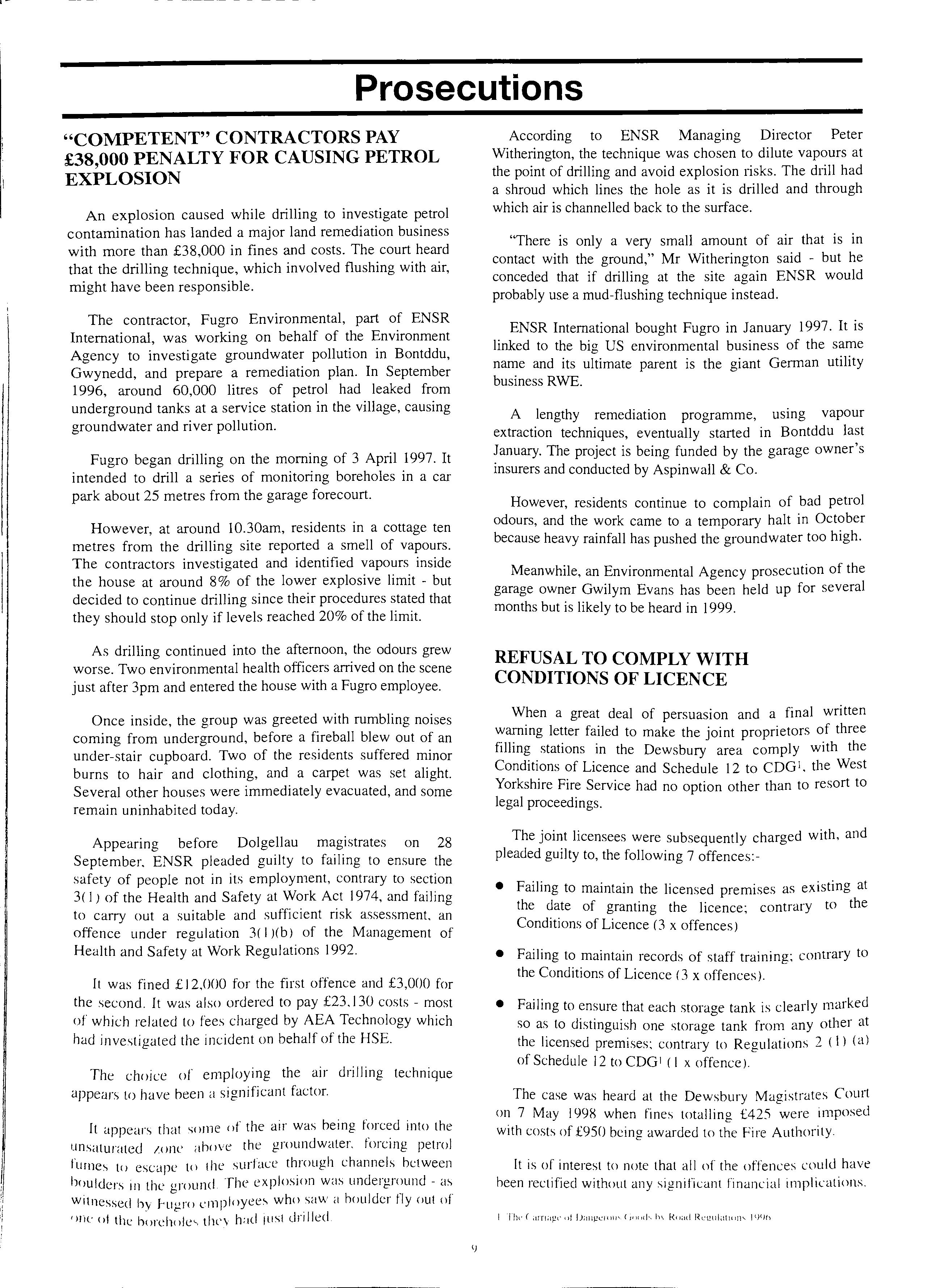
However, at around 10.30am, residents in a cottage ten metres from the drilling site reported a smell of vapours. The contractors investigated and identified vapours inside the house at around 8% of the lower explosive limit but decided to continue drilling since their procedures stated that they should stop only if levels reached 20% of the limit.
As drilling continued into the afternoon, the odours grew worse. Two environmental health officers arrived on the scene just after 3pm and entered the house with a Fugro employee.
Once inside, the group was greeted with rumbling noises coming from underground, before a fireball blew out of an under-stair cupboard. Two of the residents suffered minor bums to hair and clothing, and a carpet was set alight. Several other houses were immediately evacuated, and some remain uninhabited today.
Appearing before Dolgellau magistrates on 28 September. ENSR pleaded guilty to failing to ensure the safety of people not in its employment, contrary to section 3( l) of the Health and Safety at Work Act 1974, and failing to carry out a suitable and sufficient risk assessment, an offence under regulation 3( I J(b) of the Management of Health and Safety at Work Regulations 1992.
It was fined £ 12,000 for the first offence and £3,000 for the second. It was also ordered to pay £23, 130 costs most of which related to fees charged by AEA Technology which had investigated the incident on behalf of the HSE.
The choice of employing the air drilling technique appears to have been a significant factor.
It appears that some of the air was heing forced into the unsaturated ;one above the groundwater. forcing petrol fumes to escape to the surface through channels between boulders in the ground The explosion was unciergrounci as witnessed by Fugro employee.., who saw a boulder fly out of '>n<· 0 1 the horeh<>le'. thn h:1d 1ust dri Iled
According to ENSR Managing Director Peter Witherington, the technique was chosen to dilute vapours at the point of drilling and avoid explosion risks. The drill had a shroud which lines the hole as it is drilled and through which air is channelled back to the surface.
"There is only a very small amount of air that is in contact with the ground," Mr Witherington said but he conceded that if drilling at the site again ENSR would probably use a mud-flushing technique instead.
ENSR International bought Fugro in January 1997. It is linked to the big US environmental business of the same name and its ultimate parent is the giant Gennan utility business RWE.
A lengthy remediation programme, using vapour extraction techniques, eventually started in Bontddu last January. The project is being funded by the aaraae owner's • b b msurers and conducted by Aspinwall & Co.
However, residents continue to complain of bad petrol odours, and the work came to a temporary halt in October because heavy rainfall has pushed the groundwater too high.
Meanwhile, an Environmental Agency prosecution of the garage owner Gwilym Evans has been held up for several months but is likely to be heard in 1999.
REFUSAL TO COMPLY WITH CONDITIONS OF LICENCE
When a great deal of persuasion and a final written letter failed to make the joint proprietors of three . stations in the Dewsbury area comply with the Cond1t10ns of Licence and Schedule 12 to COG 1, the West Yorkshire Fire Service had no option other than to resort to legal proceedings.
The joint licensees were subsequently charged with, and pleaded guilty to, the following 7 offences:-
• Failing to maintain the licensed premises as existing at the elate of granting the licence; contrary to the Conditions of Licence (3 x offences)
• Failing to maintain records of staff training: contrary to the Conditions of Licence ( 3 x offences).
• Failing to ensure that each storage tank is clearly marked so as to distinguish one storage tank from any other at the licensed premises: contrary to Regulations 2 (I) (al of Schedule 12 to COG 1 ( 1 x offence).
The case was heard at the Dewshury Magistrates Court on 7 May 1998 when fines totalling £425 were imposed with costs of £950 being awarded to the Fire Authority.
It is of interest to note that al I of the offences could have been rectified without any significant financial implications.
'J
TANK DISCOVERED IN EXPLOSIVE CONDITION AT SAVE SERVICE STATIONS SITE IN SURREY
Save Service Stations Ltd. have been fined £5000 with £2000 costs for contraventions of petroleum licence conditions and reg 20 of the Carriage of Dangerous Goods by Road Regulations 1996 at their premises in Sunbury-onThames, Surrey
In May 1997, Roy Hammond (a contractor for the company) had applied to Surrey Trading Standards Service for approval of proposed works at the site which included the reinstatement of two disused , 30 year old , 42300 litre underground tanks.

A_ssurances were sought from the company as to the prec1 s1on-test111g of these tanks before their reinstatement and later when operational , as a precondition to any approval.
After a lapse of over a mo tl h · • < n 1 w en nothm g more was heard , su sp1c1ou s that works may 11av t t d · h . e s ar e wit out approval , an mspector visited the si.te and f d tl k < oun rnt wor s had mdeed commenced. He found tllat tl t k h d . 1e wo tan s a been emptied of water, one of which cont · d 1 · ame an exp os1ve atmo sphere without any liquid seal and that the fill caps of the re marnde1 of the tanks at the pre1n 1·ses II 1 k d we1e a un oc e even .though no fuel dehveries were due that day. The s1tuat1on was exacerbated by the cl · ose prox11mty ol nei ghbourin g hou ses and the sole foi·ecou ·t tt d , 1 a en ant s mab1hty to speak Enghsh. Attempts to contact both the site manager and the are a manager were un s uccessful.
Des pite written in struction s to re medy th ·t · 1 e s1 uat1on , t 1e site wa s still 111 ex actly the sam e condition two day s late r but te lephone contac t was at las t made with the are a mana ger for the co mpany.
A further foll ow- up vis it reveal ed eve n more all e aed offences in conn ec ti o n with wetstoc k recon c iliation and record s of trainin g for the for ecourt atte ndants and th e ·competent perso n ' for tak in g tank e r deli ve ri es .
Five in fo rm ati ons we re laid aga in st th e co mpan y but af te r pl ea- bargainin g th e co mpan y pl eaded g uilt y to three. in
respect of the uncapped explosive tank, the failure to keep locked the fill caps of the other tanks on site and the lack of training records for the ' competent person'. The remaining two informations were withdrawn.
At Staines Magistrates' Court in November, the company was convicted of these offences and fined the maximum of £5000 on the first two counts and £3000 on the third, so demonstrating the local Magistrates' concern at the dangerous state in which the site was found and being operated. Costs of £2000 were agreed with the company prior to t1ial.
However, the company appealed against this heavy sentence and on 1O December at Kingston Crown Court the fines were reduced to £4000 for the unlocked fill caps (with the uncapped, explosive tank treated as part of the sa111e offence with no separate fine) and to £ 1OOO for the lack of ' competent person' training records with the £2000 agreed costs standina. A fmther application by the company for their appeal was rejected out of hand by the presiding judge.
In their defence submission, the company had sought to convince the court that they "take these offences seriously" and that "apart from a previous conviction brought by West Yorkshire Fire Brigade in 1997, their record on site safety was otherwise unblemished". ·
HORSEPOWER SERVICE STATION
Ill
-.- J
TANK NO. 2 EMPTY OF PRODUCT. NO LIQUID SEAL AND FULL OF EXPLOSIVE VAPOUR !
Why the AERIDE™ Nozzle developed by OPW is a Breakthrough in Design, Safety, Environment and Ergonomics.
By: Hans van Holst from OPW Fueling Components Europe BV.
In an earlier bulletin beginning last year a remark was made " nozzles look like tools rather than products to be used by everyday consumers" Indeed it is true in terms of nozzle design, aesthetics , user friendlin ess and convenience, that very little has changed over the past decades. Also from an ergonomic viewpoint nozzles can even be considered as a " forgotten " product.
Th e arrival of Stage 2 vapour recovery did not improve the situation , since this made nozzles even bigger and sometimes also harder to ope rate. OPW recognised this and was chall enge d to design a new noz zle , the JERIDE™.
Before new nozzle development began , market research was conducted. The result was a " list of requirement s", a "w ouldn ' t it be nice li st" and a hos t of rule s and regulations in terms of legalisation , standards, requirements for safety , environmental aspects, weights and measures , boot fit etc.

In coming up with a new nozzle design we took a clean s heet of paper a nd addressed the following topic s
•
De sign & Aesthetics
• Ergonomics & User Convenience
• S afe ty
• En v ironment
• Durabilit y & Cost o f O w nership
• Flexibility & Maintenance
Design & Aesthetics
An MOC m a rk eting man ager who co mpl ained about nozzl e looks s u gges ted goin g to a well-known Italian de sign hou se for a new nozzle design. Qu a lifi ed indu s trial de signers were e mpl oyed a nd a test pa ne l was comprised to judge the des ig n a nd fee l of th e nozzle. Th e re s ult is a lightweight, mod e rn-lo oking nozz le that pleases the eye and is very co m fo rta ble to h o ld by bot h wo men and men.
Ergonomics & Use r Convenience
T h e new JERIDETM nozz le is uni q ue in that it meets e rgo no mi c s ta nda rd s for s ize, s h ape, we ig ht , bala nce and o pe rat in g force. Th e use r w ill not ice how eas y it is to open the nozz le to co n tro l the flow acc urate ly, and a lso to kee p the nozz le full y he ld o pe n. Ot he r nozz le s that re ly on a heavy s pring to c lo se the main va lve a re ve ry hard to ho ld o pe n bec a use the s prin g has max imum co mpress io n at the e nd of it s st rok e So me peo p le hav e not ice d that , in c o untri es w he re ho ld -o pen c lip s are not a ll owed , o bje cts s uc h as the c a r fi ll -c ap s a re be in g use d und e r the leve r to ho ld the nozz le o pe n Ce rtainl y thi s is a da nge ro us and hi g hl y und es irabl e s ituat ion T he re is no g uarantee in s uc h c ase s that th e no;,7. Je w ill s hut a utomati ca ll y s hould it h:tl l
out of the car filler neck when a foreign object is blocking the lever in the open position.
Spill s al so play a negative role in pe ople s' fuelling experience , so potential for s pillage s pit back and o verfill was reduced in the following ways
l. As a standard feature (whether di ese l, leaded , unl e aded , conve ntion al or vapour recovery) , a new generation drip le ss valv e was added at the end of the s pout on th e lE RIDET M no zz le. Thi s reduces the s pill po tenti a l with so me no zz les by as mu c h as >I OOcc clown to ju s t a few drops Thi s spillag e can occur when takin g the no zz le out of the ca r ' s fill pipe or when takin g the no zz le out of the di spen se r boot.
11
2. The minimum required flow rate, at which the nozzle will shut off automatically, was reduced dramatic ally to only 1,5 litre/min This will minimise the chance that fuel will pour out of the fill pipe while a person is looking at the meter to top off accurately (an experience that probably sounds familiar to many).
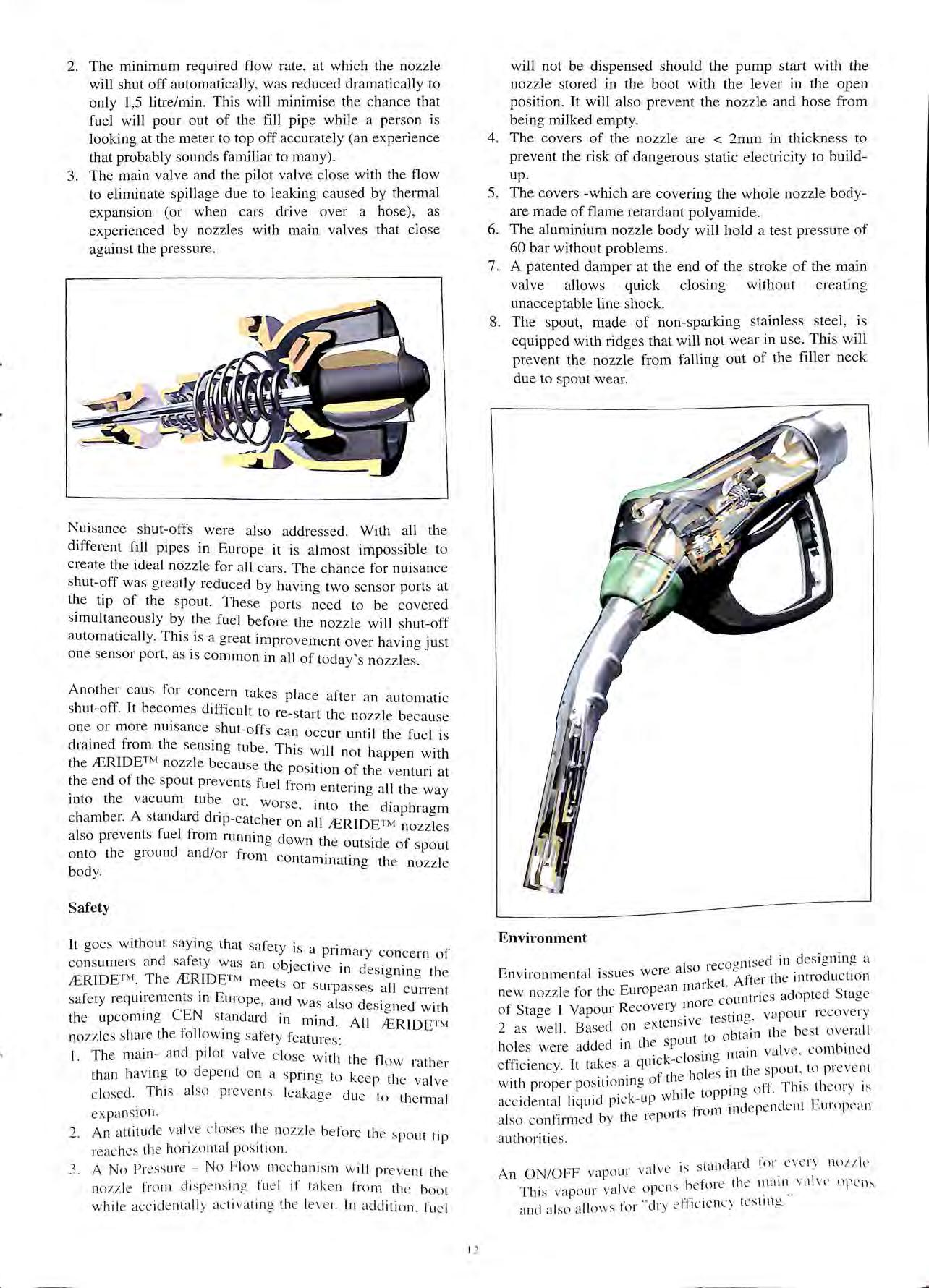
3. The main valve and the pilot valve close with the flow to eliminate spillage due to leaking caused by thermal expansion (or when cars drive over a hose), as experienced by nozzles with main valves that close against the pressure
will not be dispensed should the pump start with the nozzle stored in the boot with the lever in the open position. It will also prevent the nozzle and hose from being milked empty.
4. The covers of the nozzle are < 2mm in thickness to prevent the risk of dangerous static electricity to buildup.
5. The covers -which are covering the whole nozzle boclyare made of flame retardant polyamide.
6 . The aluminium nozzle body will hold a test pressure of 60 bar without problems.
7 A patented damper at the end of the stroke of the main valve allows quick closing without crea ting unacceptable line shock.
8. The spout, made of non-sparking stainless steel, is equipped with 1idges that will not wear in use. This will prevent the nozzle from falling out of the filler neck clue to spout wear.
Nuisance shut-offs were also addressed. With all the different fill pipes in Europe it is almost impossible to create the ideal no z zl e for all c ars. The chance for nui sa nce shut-off was greatly reduced by having two sen sor ports at the tip of the spout. These ports need to be covered simultaneou sly by the fuel before the noz z le will shut-off automatically Thi s .i s a gre at improvement over having just one sensor port, as 1s common in all of today ' s nozzles.
Anoth e r ca us for concern takes place aft e r an a utomatic shut-off. It becomes difficult to re stai·t the I b noz z e ecau se one_ or more nmsance _shut-offs can occur until the fuel is dramed from the sen smg tube TJ11·s w 1 ·11 t h · I · no appen wi t 1 th e JERIDE TM noz z le because the po si·t10 f tl n o 1e ventun at the e nd o f the spout prevents fuel fi·om t · II h en e 11ng a t e way rnto the vacuum tube or wors e 1 · t th d. 1 . ' , n o e iap 1raam c hamber. A standard drip-catcher on all ;cRIDETM "' c = nozzl es a lso preve nts fuel from mnnina dow 11 tl ·d f "' 1e outs1 e o spout onto the g1ound and/or from contan11 11 at· 1 1 b d mg t 1e nozz e 0 y
Safety
It goes without saying that saf e ty is a .· p11maiy c once rn of con sum e rs and safety was an o bi ecti.v e · d · . J In e s1an1n a th e JERlDET M _ Th e JERIDET M me "' "' e ts 01 s urpa sse s a ll cuJTent safety require ments 111 Eu ro pe a nd wa s al d · . ' < so es 1°ned with th e up co mrn g CE N sta nd ard in mind. All ,'.E RID E rM nozz le s shar e the fo ll ow 111 g safe ty fea tures :
1. The main- a nd pil o t va lve c lose w ith th e flow ra the r than ha vmg to depend o n a sprin g to ke e p th e va lve c losed Thi s al so preve nt s leakaae du e to tl 1 · · "' 1e rma ex pan sio n
2 An a ttitud e va lve c loses th e no zz le befo re th e s pout ti re ac he s the hori zo nta l pos iti o n . p
3. A No Press ur e No F low mec ha ni s m w ill preve nt th e noz z le fr o m d ispe ns in g fu e l if ta ke n fro m th e boo t whil e acc id e nta ll y ac tiva ti ng the leve r. In ad di t io n . fue l
Environment
oa ni secl in desig nin g a E 1 • were a lso 1ec "" nv1ronme nta iss ues Ai'ter th e introclu c t1 o n 1 mm·ke t. ne w no zz le fo r th e Euro pem 1tri es ado pte d Stage _ry mme co u1 ot Stage 1 Vapo ur Reco ve t. 10 va po ur recove ry 1 xte ns1ve t.es 11 0
2 as we ll. Basec o n e, . bt" in th e bes t ove rall tl spo ut to o « ho les we re add ed 111 1e . a main valv e co rnb111 ed f+ · I ak a qu1 c k-cl os 1n,,, e 11 c 1e ncy. t tc ' eS < • 1 · th e spo ut. to preve nt . . . . ot the ho es 111 w ith pro pe r pos 1t1 o nm g · a off Thi s th e o ry is c1 k up w hile to pp in cacc id e ntal l!qw pi e _ · de ne ncl e nt Europ e a n a lso co nfirmed by th e re po rt s t ro m 111 a uth o riti es
· t· d·1rd fo r eve ry nu zz le
A n ON/OFF vapo ur va lve is s a n ' 1 o ne ns be fo re the mam va lvt> upen:-. Thi s vapo u1 va ve · , I · tt ·ie nc y te st rn ° an d also a ll ows tor c 1y e ic · · ""
12
The recovery of vapours is only one of many ways to reduce the emission of hydrocarbon vapour into the atmosphere. A study in the USA revealed that 20% off all emissions at service stations are the result of spills by overfills , by spit-backs, as well as by product left in the nozzle that drains on the floor before or after fuelling By adding a drip-less valve to the end of each and every nozzle spout, the spillage potential goes down from as much as cup-full (even up to >100 cc) for traditional nozzles, to just a few drops with the JERIDE™. This feature also prevents liquid still present after the main valve from evaporating freely into the air.
The same is true for a main valve that remains closed and will not open due to thermal expansion creating spillage potential. By having a venturi at the end of the spout, and of a by-pass type, air is not mixed with the fuel until the last moment, and even then, only very little. This will have a positive effect on vapour creation in the car's tank and assures a constant volume of trapped liquid between the main valve and the end valve. It is also possible to easily reduce the maximum flow rate of the nozzle in the field , to prevent spillage due to excessive flow rates.
Durability & Cost of Ownership
The one part of the nozzle that takes most abuse is the spout. The durability of stainless steel was chosen for the ;ERIDETM_ A new manufacturing technique and reduction of the necessary machining, common to traditional aluminium spouts, partly offsets the extra cost for the material. The real gain comes from the life expectancy of the spout , the savings in labour cost , and reduction in downtime. Nozzles will suffer from le ss spout wear by normal usage and dropping on the ground , while spout tips will show le ss damage causing blockage of the sensing port.
The nozzle body is made of preci sion high-pre ssure diecast aluminium c apable of with standing up to 60 bar test press ure without any problem. Polyamide covers-that withstand high impact without breaking or scratchingpro tect the entire no zzle body. Thi s is combined with a
lever and leverguard of material with a long-term proven durability.
The choice of sophisticated moulding techniques, over more classic machining, provides far better dimensional repeatability and stability of manufactwing tolerances
Almost all seats are static and soft seating opposed to hard plastic or metallic seats known to leak even with small scratches. All rubber components in the nozzle are made of fuel resistant elastomers
Flexibility & Maintenance
The features listed above will help nozzle specifyers to make a choice. The JERIDE™ is the only nozzle that has the same body for both conventional and vapour recovery nozzles. The difference is in the spout assembly and the connection and insert at the hose-end of the body. By exchanging those parts, a nozzle can be easily converted from conventional to vapour recovery and vice versa. The guards and other assemblies (like the main valve and the diaphragm mechanism) come as complete sub-assemblies and confirm that the modular build up makes the nozzle a "Plug and Play" product. With just a few parts, maintenance will be easy and quick and requires low stocking levels for spares. The nozzle's message centre can indicate the fuel grade and/or company logo , and is available in different colours. The spout nut is also available in different colours to either comply with the oil company colour scheme or to indicate the fuel grade.
Conclusion
The JERIDPM is a truly revolutionary design, manufactured with the most modern techniques , and is based on years of experience in the service station business. This product succeeds in combining features desired over the years by customers , oil companies, legi slators, environmentalists, pump manufacturers, installing companies and distributors alike.
The JERIDETM "designed with the customer in mind. "

i) }} ') }}
Stage II Vapor Recovery Can Include Control of Fugitive Emissions and Self-Diagnostics
By Robert W. McDowell, P.E.
Hasstech, Inc. of San Diego, California, U.S.A. has been at the forefront of gasoline vapor recovery technology since its inception in the mid-1970's. In fact, Hasstech was the first company to have a Stage II system certified by the CalEPA Air Resources Board (CARB) There are many systems and types available today, but none seem to capture the best of all worlds quite the way the Hasstech system does.
Stage II Systems and Needs
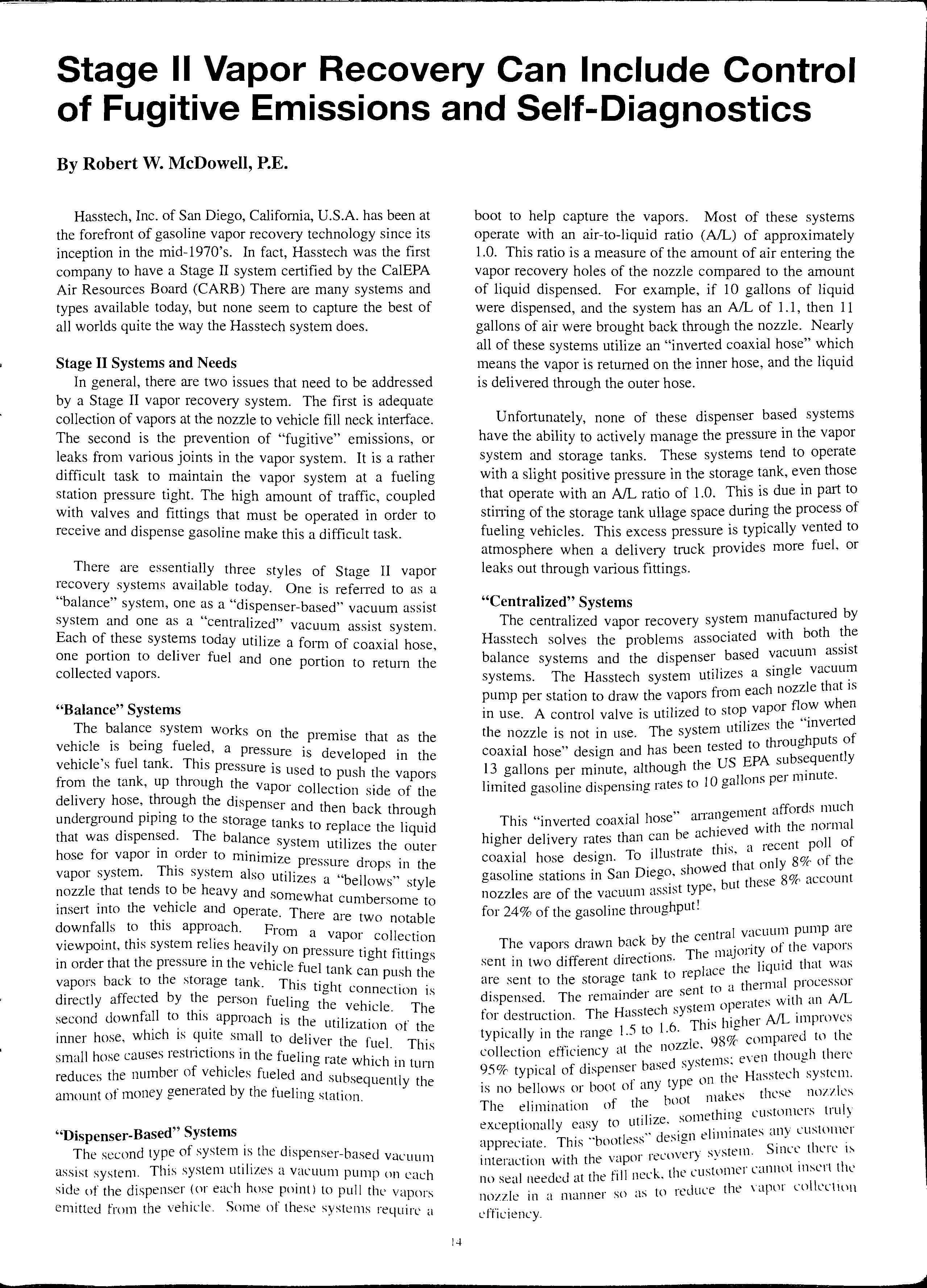
In general, there are two issues that need to be addressed by a Stage II vapor recovery system. The first is adequate collection of vapors at the nozzle to vehicle fill neck interface. The second is the prevention of "fugitive" emissions, or leaks from various joints in the vapor system. It is a rather difficult task to maintain the vapor system at a fueling station pressure tight. The high amount of traffic, coupled with valves and fittings that must be operated in order to receive and dispense gasoline make this a difficult task.
There are three styles of Stage II vapor recovery systems available today. One is referred to as a "balance" system, one as a "dispenser-based" vacuum assist system and one as a "centralized" vacuum assist system. Each of these systems today utilize a form of coaxial hose one portion to deliver fuel and one portion to return collected vapors.
"Balance" Systems
1:1e c_e sy!tem works on the premise that as the vehicle 1s emg iueled, a pressure 1 ·s d 1 d · h . , eve ope m t e vehicle s fuel tank. This pressure is used t h h o pus t e vapors from the tank, up through the vapor coll t. ·d f h ec 10n s1 e o t e delivery hose, through the dispenser and th b k h h en ac t roug p1pmg to the storage tanks to replace the liquid that was dispensed. The balance system t·1· h u 1 1zes t e outer hose for vapor m order to minimize press d · h h" · ure raps 111 t e vapor system. T 1s system also utilizes a "b 11 ,, 1 d b h e ows sty e nozzle that ten s to e eavy and somewh t b · a cum ersome to insert into the vehicle and operate There . t b . · aie wo nota le downfalls to this approach. From a v 11 . apor co ect1on viewpomt, this system relies heavily on pres t. h fi . . . · su1e 1g t 1ttmgs m order that the pressme m the vehicle fuel t k h an can pus the vapors back to the storage tank. This ti·o-ht . · ,,, connection 1s d1rectly affected by the person fuelino- the v h" 1 Th 11 h. "" e 1c e. e second downfa_ t is_ approach is the utilization of the inner hose, which is quite small to deliver the f 1 Th" ue. 1s small hose causes restnct1ons m the fuelino- i·ate h" h. · . "" w 1c 111 tum reduces the number of vehicles fueled and subsequently the amount of money generated by the fueling station.
"Dispenser-Based" Systems
The second type of system is the dispenser-based vacuum assist system. This system utilizes a vacuum pump 011 each side of the dispenser (or each hose point) to pull the vapors emitted from the vehicle. Some of these systems require a
boot to help capture the vapors. Most of these systems operate with an air-to-liquid ratio (AIL) of approximately 1.0. This ratio is a measure of the amount of air entering the vapor recovery holes of the nozzle compared to the amount of liquid dispensed. For example, if 10 gallons of liquid were dispensed, and the system has an AIL of 1.1, then 11 gallons of air were brought back through the nozzle. Nearly all of these systems utilize an "inverted coaxial hose" which means the vapor is returned on the inner hose, and the liquid is delivered through the outer hose.
Unfortunately, none of these dispenser based systems have the ability to actively manage the pressure in the vapor system and storage tanks. These systems tend to operate with a slight positive pressure in the storage tank, even those that operate with an AIL ratio of 1.0. This is due in part to stirring of the storage tank ullage space during the process of fueling vehicles. This excess pressure is typically vented to atmosphere when a delivery truck provides more fuel, or leaks out through various fittings.
"Centralized" Systems
The centralized vapor recovery system manufactured by Hasstech solves the problems associated with both balance systems and the dispenser based vacuum assist systems. The Hasstech system utilizes a single f eh nozzle that 1s pump per station to draw the vapors rom ea ·1· d t stop vapor flow when m use. A control valve 1s ut1 1ze o . d the nozzle is not in use. The system utilizes the "mverte f t d to throughputs o coaxial hose" design and has been tes e tl 13 gallons per minute, although the US EPA y t I0 a-a lions per mmu limited gasoline dispensing rates 0 e •
,, aiTano-ement affords much This "inve1ted coaxial hose . e- d "th the normal higher delivery rates than can be t poll of ·11 , te this a iecen coaxial hose design. To _ 1 ustr,i d 'h t only 8% of the gasoline stations in San sho:e 8% account nozzles are of the vacuum assist typ ' for 24% of the gasoline throughput!
he central vacuum pump are
The vapors drawn back by t . 11.ity of the vapors d. f 1s The maJt sent 111 two different 11ec 101 · · the liquid that was t nk to replace are sent to the storage a , thermal processor d · d · are sent to a 1spensed. The remam ei ' crates with an AIL f d Th H sstech system op or estruct10n. e a · TI h. aher NL improves typically in the range 1.5 to 1.6 · 119 s compared to the II t'f" , at the nozzle. co ect1on e 1c1em:y even thou<>h there 95% typical of dispense1.· based systemtsl. H·1sstcch · t pe on 1e '· · is no bellows or hoot ol any Y . k these nozzles Th I. . . f the boot ma cs . e e 11111nat1on o h. -ustnmcrs truly , , , t utilize. somet mg c except10n<1lly easy 0 1 · tes 'lll\' customer I ·· des10-n e 1111111a · ' · appreciate. This ··boot ess · e s· .. , tl · ")' svstem mu 1c1t: ts interaction with the vapor recnvei · • · · . . . h t 11 , ·k the customer cannot 1nsc1t thl' no seal needed at t e 1 nt:l • ·is t(1 1·educe the \·apnr cnlkL·t1on nozzle in a manner so '. efficiency.
14
Tank Pressure Management Controls Fugitive Emissions
The Hasstech system has a second mode of operation, referred to as tank pressure management. Whenever there is no vehicle fueling activity, but pressure exists in the storage tanks , the system will activate and take suction on the tank in order to bring the pressure to a slight vacuum. This operation usually takes about 1-2 minutes to accomplish. (Note: The storage tanks naturally tend to build pressure in periods of inact1v1ty. This pressure most frequently occurs at night when many stations are closed.) With other systems, this same pressure build up occurs, but the excess vapor is lost to the environment through leaks or venting. The Hasstech system utilizes its thermal processor to destroy these excess vapors, rendering them harmless to the environment.
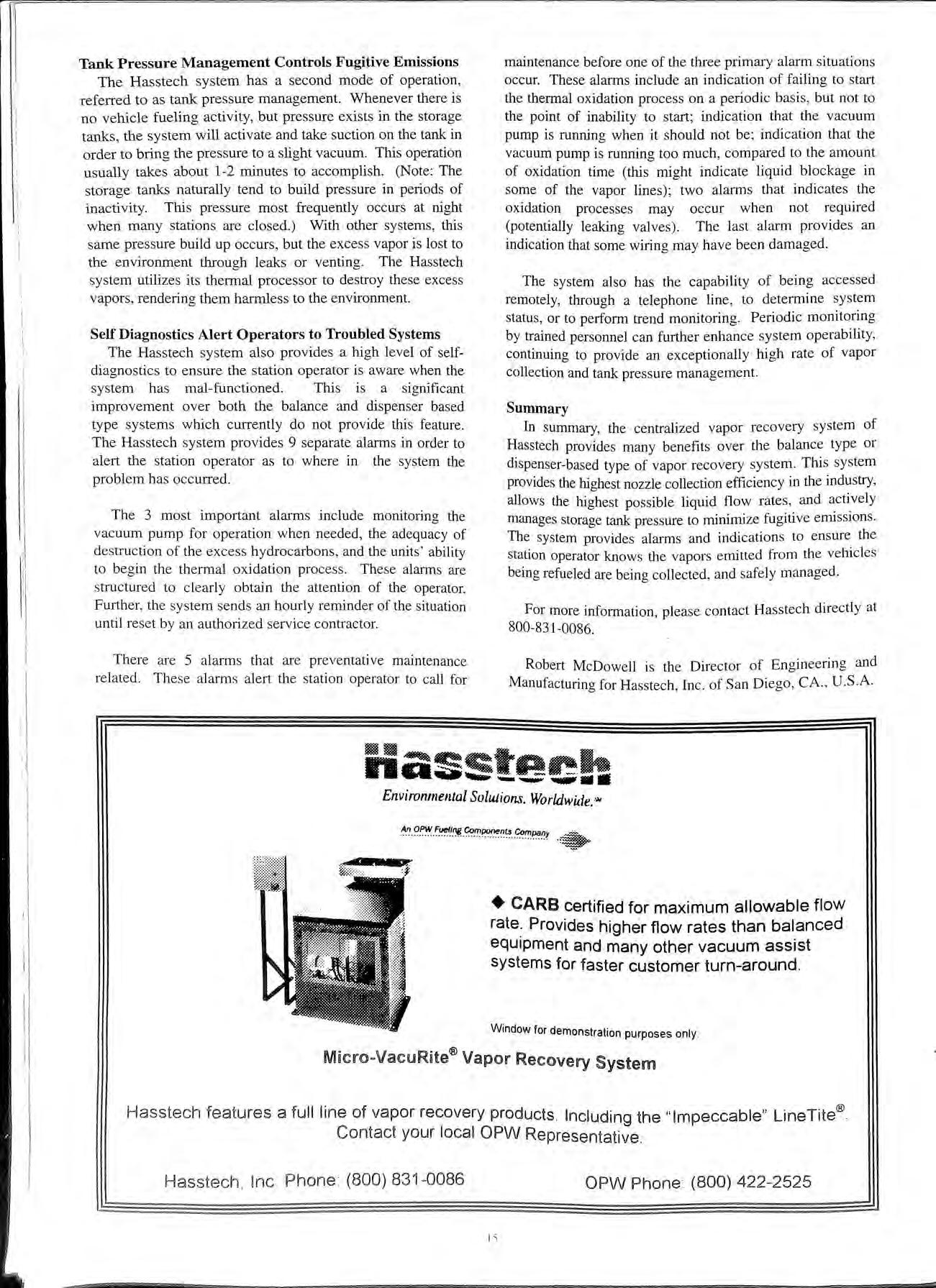
Self Diagnostics Alert Operators to Troubled Systems
The Hasstech system also provides a high level of selfdiagnostics to ensure the station operator is aware when the system has mal-functioned. This is a significant improvement over both the balance and dispenser based type systems which currently do not provide this feature. The Hasstech system provides 9 separate alarms in order to ale1t the station operator as to where in the system the problem has occurred.
The 3 most important alarms include monitoring the vacuum pump for operation when needed, the adequacy of destruction of the excess hydrocarbons, and the units' ability to begin the thermal oxidation process These alarms are structured to clearly obtain the attention of the operator. Further, the system sends an hourly reminder of the situation until reset by an authorized service contractor.
There are 5 alarms that are preventative maintenance related These alanns alert the station operator to call for
maintenance before one of the three primary alarm situations occur. These alarms include an indication of failing to start the thermal oxidation process on a periodic basis, but not to the point of inability to start; indication that the vacuum pump is running when it should not be; indication that the vacuum pump is running too much, compared to the amount of oxidation time (this might indicate liquid blockage in some of the vapor lines); two alarms that indicates the oxidation processes may occur when not required (potentially leaking valves). The last alarm provides an indication that some wiring may have been damaged.
The system also has the capability of being accessed remotely, through a telephone line, to determine system status, or to perform trend monitoring. Periodic monitoring by trained personnel can further enhance system operability, continuing to provide an exceptionally high rate of vapor collection and tank pressure management.
Summary
In summary, the centralized vapor recovery system of Hasstech provides many benefits over the balance type or dispenser-based type of vapor recovery system. This system provides the highest nozzle collection efficiency in the industry, allows the highest possible liquid flow rates, and actively manages storage tank pressure to minimize fugitive emissions. The system provides alarms and indications to ensure the station operator knows the vapors emitted from the vehicles being refueled are being collected, and safely managed.
For more information, please contact Hasstech directly at 800-831-0086.
h• ...... ___ .,..... Environmental SolUJions.
.., An OPW Fuellng ComPonento Com -"' + CARB certified for maximum allowable flow rate. Provides higher flow rates than balanced equipment and many other vacuum assist systems for faster customer turn-around. Window for demonstration purposes only. Mocrn-VacuRite® Vapor Recovery System Has ste ch feat ure s a full line of vapor recovery products Including the "Impeccable" LineTite® Contact your local OPW Representative Hasstech , Inc . Phon e (800) 83 1 0086 OPW Phone (800) 422-252 5
Robert McDowell is the Director of Engineering and Manufacturing for Hasstech, Inc. of San Diego, CA. , U.S.A.
Worldwuie .

STATION WITH HAZTECH SYSTEM
IN CALIFORNIA
BUSY
INSTALLED
GAUGE SHOWING PRESSURE IN TANKS THERMAL PROCESSOR
PARTNERSHIP AGREEMENTS - THE WAY AHEAD FOR FUTURE DEVELOPMENT
Peter Richmond, Operations Manager Petroleum Division, David McLean Contractors Limited.
I think it is true to say that a large proportion of the UK population uses the services of a petrol filling station on a reasonably regular basis. This may be as a driver, passenger or pedestrian calling in for fuel, to use the rest room facilities or to buy the odd packet of sweets or that bottle of milk that always runs out when the shops are shut.
In many ways, filling stations have become more than just a fuel halt. Many now provide convenience store facilities that, in many communities, have replaced the comer shop that have all but disappeared from urban locations. On motorways and in rural areas too, the filling station provides welcome respite and refreshment for many a weary traveller, often late into the night or even on a 24hour basis.
I wonder though, how many of those callers even think about the effort that has gone into providing these facilities. Or even what is required to maintain and refurbish them to the most modem standards that the customers expect and take for granted.
The logos of multi-national companies, such as Shell, are familiar sights at filling stations throughout the country and they spend enormous sums and expend a lot of resources to supply all that their customers want, when they want it.
Right up to the mid- l 990s Shell managed such projects on a stand-alone basis. Each new or refurbishment contract had a company engineer assigned as project manager. This carried with it the responsibility to make all enquiries about the site. evaluate and recruit local contractors and procure the requisite equipment through the "European Agreement" Shell has with its suppliers for repeat orders throughout Europe.
Once the job started, the engineer was also responsible for project monitoring, trouble shooting and ensuring schedules were maintained. This tied up resources on a full time basis and had to be repeated for each individual project. Shell realised there had to be a better and more cost effective way.
The ideal would be for a nationally operating contractor to take over this side of the business as a natural progression to the widely accepted principle of outsourcing services as a cost cutting measure. This would enable the filling station programme Lo become managed on a global basis with much improved co-ordination of effort. However. Shell also recognised the not insubstantial that might arise from the need for two large orga111sat10ns to work closely together in this way. Not the least consideration was the problem of how iwo established company cultures could adapt to such an arrangement·
As a first step, Shell decided on an intermediate stage of asking for proposals for a "serial tender" involving work at 11 filling stations over a wide area of the country. David McLean Contractors was successful in securing this contract and it was put in place as a "feasibility tester" to see if and how a large construction company could work in harmony with Shell or not!
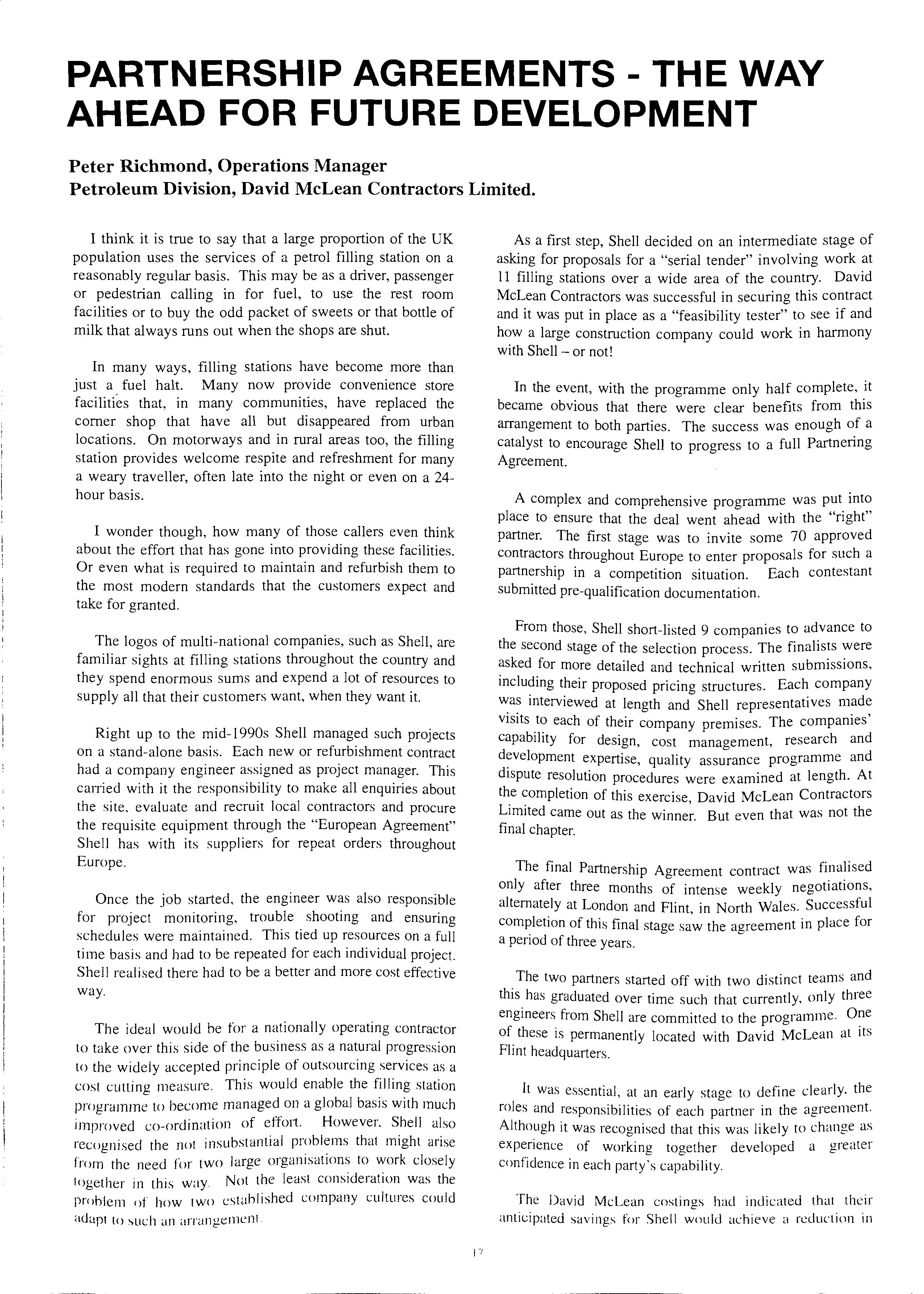
In the event, with the programme only half complete, it became obvious that there were clear benefits from this arrangement to both parties. The success was enough of a catalyst to encourage Shell to progress to a full Partnering Agreement.
A complex and comprehensive programme was put into place to ensure that the deal went ahead with the "right" partner. The first stage was to invite some 70 approved contractors throughout Europe to enter proposals for such a partnership in a competition situation. Each contestant submitted pre-qualification documentation.
From those, Shell short-listed 9 companies to advance to the second stage of the selection process. The finalists were asked for more detailed and technical written submissions, including their proposed pricing structures. Each company was interviewed at length and Shell representatives made visits to each of their company premises. The companies' capability for design, cost management, research and development expertise, quality assurance programme and dispute resolution procedures were examined at length. At the completion of this exercise, David McLean Contractors Limited came out as the winner. But even that was not the final chapter.
The final Partnership Agreement contract was finalised only after three months of intense weekly negotiations, alternately at London and Flint, in North Wales. Successful completion of this final stage saw the agreement in place for a period of three years.
The two partners started off with two distinct teams and this has graduated over time such that currently, only three engineers from Shell are committed to the programme. of these is permanently located with David McLean at its Flint headquarters.
It was essential, at an early stage to define clearly. the roles and responsibilities of each partner in the agreement. Although it was recognised that this was likely to change as experience of working together developed a greater confidence in each party's capability.
The David McLean costings had indicated that their anticipated savings for Shell would achieve a reduction in
17
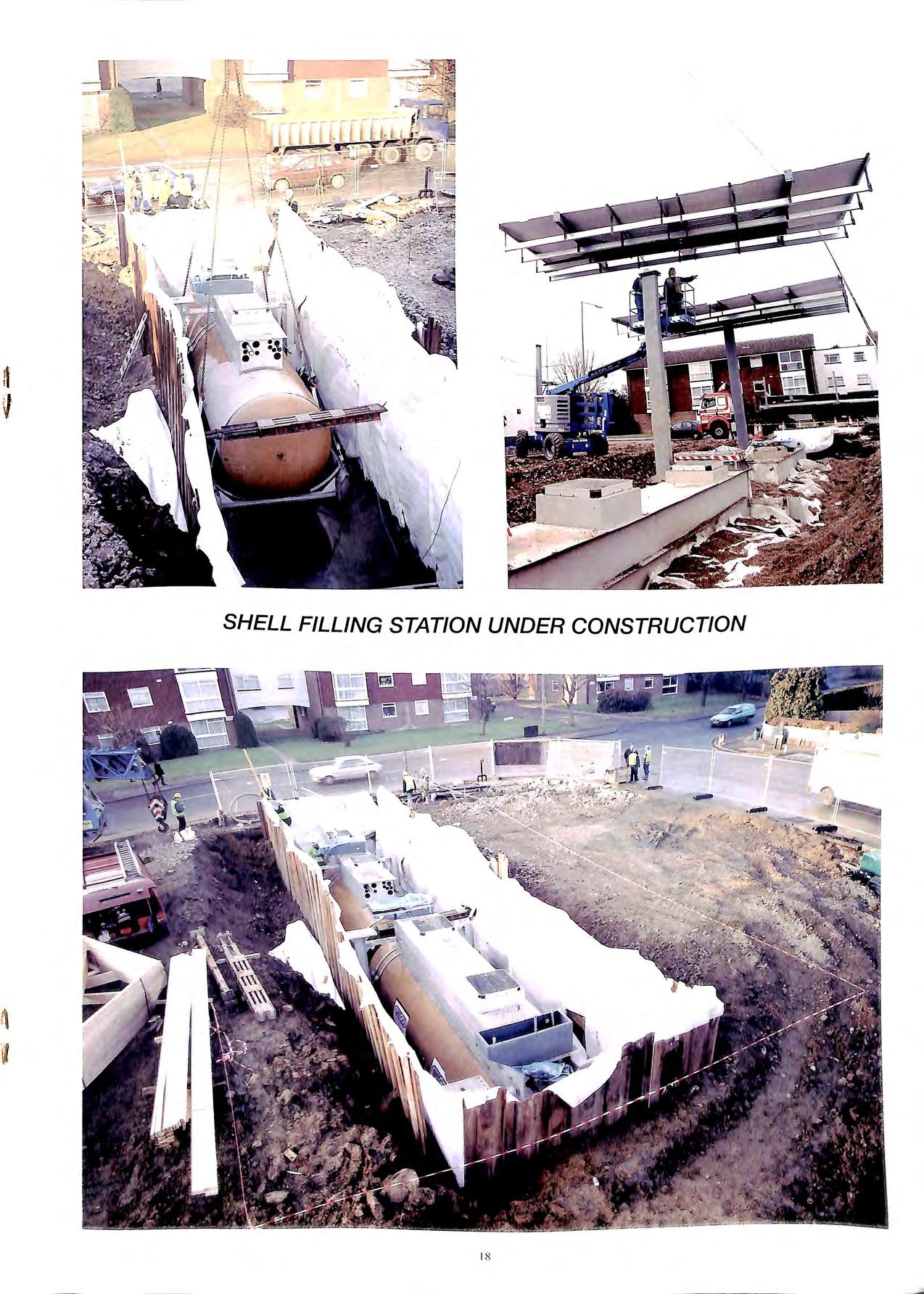
FILLING STATION
CONSTRUCT/ON 18
SHELL
UNDER
SOME OF THE 490 SHELL PETROL STATIONS BUILT OVER THE PAST TWO YEARS BY DAVID McLEAN PETROLEUM UNDER THE PARTNERSHIP AGREEMENT
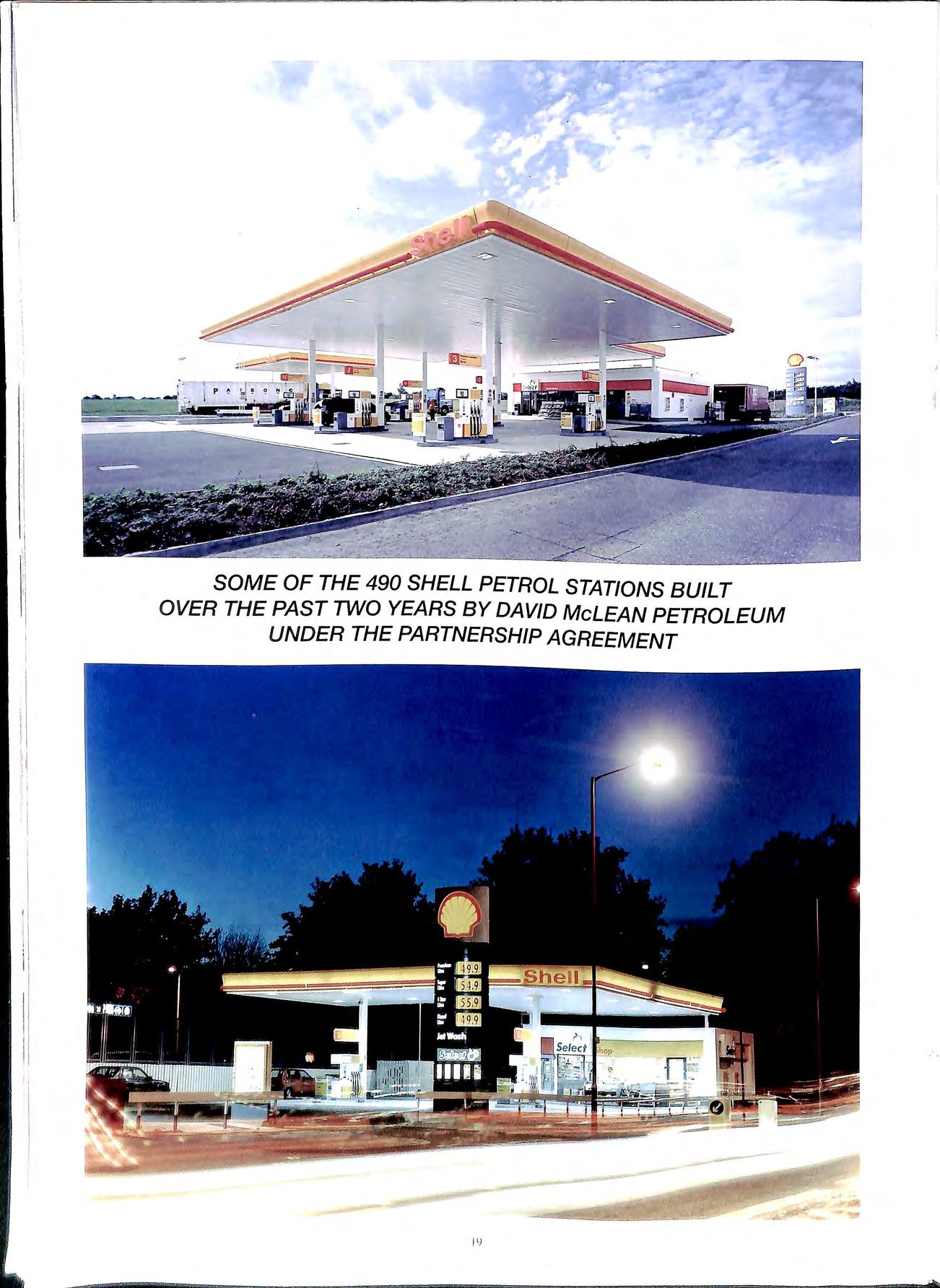
.( \, \ \i r· Ii I
Jl)
the benchmark price of developments of some 13%. David McLean was also committed to achieving cumulative savings on construction costs of fully 15% over three years. Within the first 12 months, David McLean, operating from two regional centres, North and South, had completed in excess of 200 projects and secured cumulative savings over the first twelve months of no less than 7%.
Under the terms of the agreement, Shell secures planning consent for all new developments and sets out the engineering scope of each project. These are handed over to David McLean were they are turned into finalised plans and the jobs completed on a design and build process. The evolutionary nature of the agreement means that David McLean will take over all design responsibilities as from January 1999.
Each year sees the production of a forward work programme covering the whole of the UK. There are weekly review meetings to monitor the progress of the overall programme and to confirm or reschedule individual jobs as circumstance changes. The works at the filling stations range from simple upgrading of the "Retail Visual Image", ie signage, colour schemes and re-pumping etc., through strip-out and refitting of on-site facilities and building of additional features, to the construction of entire new service centres.
From the outset, David McLean confirmed its commitment to the partnership with the setting up of a new company, Petroleum Division, specifically to resource the agreement. Right _from the start in January 1997, the new company had an mvestment by David McLean of some £250,000, 70 personnel and a major input by Senior Staff. wanted the arrangement to be a long te1m s1tuat1on and was prepared to commit the resources to make it a success.

There were difficulties at the beginning!
The annual programme compiised hund . d f · 1e s o projects that presented a problem of logistics Th · . e arrangement depended upon a system that developed confidence in both partners to do what they were required to d Th o. ere were culture changes that had to take place in both 01gamsat1ons to serve practices that had to accommod t . h ·d a e reqmrements from bot s1 es.
There was a programme of building on trust bet h ween t e two compames. a recogmtion of mutual obi t. building. Jee 1ves and team
Very quickly. the two teams developed an bi , accepta e procedure tor p10blem solvmg to such an extent that they no w work together as one. Confidence on both .·d . s1 es 1s now so high that project d1ff1cult1es are solved. Th ·b·i· e two companies share respons1 I it1es on a day-to-day basis. enabling a quicker response to problems.
One of the greatest benefits of the partnering HJTangement is the flexibility to respond to changes in the forecast programme. This was eminently demonstrated when Shell took over responsibilit) for all of the llK's filling stations
formerly owned by Gulf Oil. Suddenly, some 200 stations were added to the programme. This not only raised the production schedule considerably, but the budget also rose from £19M to more than £30M.
This was, almost immediately, followed by a market situation whereby commercial constraints at Shell caused cut backs throughout the company that resulted in the budget being relegated to the original level of approaching £20M, whilst also being required to include the additional work. Despite this, David McLean will have reflagged all of the former Gulf stations that required Shell identification by the end of March 1999.
At the same time, the remit has expanded and not only to accommodate former Gulf filling stations. David McLean has also taken on other projects such as construction of a completely new service area on the MS6 in Cheshire, the only one on the gateway to North Wales, and the first stand alone Shell "Select" convenience store on the Strand, London.
An analysis of the accomplishments resulting from the innovative agreement between Shell and David McLean shows that it will have performed as least as good as was predicted from the outset. The targets will have been achieved before the end of the stipulated three year period.
The benefits from the arrangement have resulted from the efforts of a dedicated team from both companies. Because of the crlobal view it has ensured that there are no repeat despite variety of projects. It has Health & Safety and quality perf01mance. It has resulted m innovation by introducing a new vantage point and, . . h b t way of ach1evmg some lateral thmkmg, about t e es . 11 d the partners to success. Above all, 1t has a owe Shell to produce and concentrate on their core busmesses. . . D ·d McLean to design, retail fuels and other services: Health & Safety build, project manage and ensme . . f construct10n projects. compliance at all of the fillmg sta 10n
t appl·oaches the end of its A h P t hip Acrreemen s t e m ners "' · · ten1plate for the · · 1 ar that 1t 1s a ' second successful year, it is c e The strencrth of the way ahead for other such mrnngementsf. "t parts. h the sum o Is Partnership is greater t an h ccess of these two 11 ulate t e su · Others would do we to em companies working together.
Limited is a Division of the David McLean Contractors G. p cme of the larcrest .d McLean JOU • e North West based Davi and development companies in privately owned constructwn the UK.
For further information contact: Peter Richmond. David McLean Petroleum.
20
FIRE, WHAT FIRE?
By Dennis O'Dea International Sales Manager, Forecourt Systems
Durapipe S&LP appreciate the opportunity afforded us by the Editor of the Bulletin to reply to articles in previous issues referring to a Petrol-Line Plus Electrofusion fitting that had allegedly caught fire. We would like to set the record straight and detail our findings as reported to the LFCDA.

The incident occurred earlier this year, when we were advised that a problem had been experienced with a PetrolLine Plus 63mm Electrofusion Tee during modifications to a 'live main' that had not been isolated from the underground tank.
Following the incident the fitting was removed and submitted to Stanger Science & Environment by the LFCDA for independent examination. After this inconclusive report the fitting was returned to DurapipeS&LP for comment.
Our own and immediate visual examination showed that although there was obvious 'pooling' of molten material in the bore, it was clear the claim that the fitting had 'caught fire' was a gross exaggeration. There was no charring, carbonisation or distortion of the fitting and pipe material and the resistance of the heating element showed it was in specification and had not short circuited during the fusion period.
Durapipe-S&LP products are designed and manufactured under a BS EN IS09001 Quality Management System to meet the exacting requirements imposed by the National and International Gas Industry. These include Transco, Gas de France, DVGW etc. For many years DuraFuse fittings have been the 'bench mark' of other manufacturers and annual sales exceed a million components in sizes ranging from 16mm to 400mm diameter for application in services subjected to more demanding pressures than experienced in forecourt applications.
The key to the overwhelming success of DuraFuse is their design to operate at a safe working voltage of 39.5 Volts and the use of the Patented moulded preform method of construction ensures that the heating wires are as close to the joint surl'aces as possible and that the wire position is accurately controlled during manufacture and the subsequent fusion process.
DuraFuse fittings have clearly defined ·hot' and ·cold' zones. The hot zones being the heating area, and the cold 1.ones being of sufficient length !with fully inserted pipe) to restrict the lateral flow of molten material and contain the fusion process. Electrofusion fittings designed to operate at 240 Voit are considered unsafe hy the major Gas utilities and due to their generally shorter socket depths and fusion I.ones. produce weaker ,ioints.
IJuring visits to our factory many of you will have seen
the DuraFuse method of manufacture which allow the heating element to be securely encapsulated in close proximity to the fittings surface. This ensures the heat generated during the fusion process is immediately, directly and consistently applied to the pipe and fitting interface. An optimum balance is achieved between the rate of energy, the temperature attained sufficient to form a 'melt and the pressure generated by the expanding material to cause the fitting and pipe surfaces to homogeneously blend/bond together. The importance of this aspect of the design cannot be overstressed. If the heat is applied too slowly, or is too remote from the interface, the 'melt', expanding from behind the heating element will not reach its optimum temperature and a joint thus formed will display poor fracture toughness.
Other methods are used to manufacture electrofusion fittings, for example, plastic pre-coated wire and post moulding techniques. However these methods restrict the pitch of the element and the position of the wire at the pipe fitting interface.
Examination
The electrofusion joint to the branch spigot of the tee had been well made but the pipes at the in line sockets were not fully inserted up to the pipe stops. The ends of the pipes, as sectioned, were coincident with the perimeter of the hot and cold zone towards the bottom of the sockets. The ends of the Petrol-Line Plus pipes had been adequately prepared with sufficient scraped area to achieve full penetration into sockets. A pool of polyethylene had formed on the inside surface of the fitting coincident with the invert of the pipework. Additionally, the heating elements had bunched and had part displaced over the pipe ends into the bore of the fitting.
Th b · f · es not ese o servat1ons are wholly symptomatic o P1P · being fully inserted or of being able to move during fusion cycle. No information had been given whether the fittings had heen clamped during the fusion process.
Together with advice that the fusion time had not been achieved, the consequence of incmTect insertion and possible movement was that the temperature and pressure generated during the fusion process was not contamed within the hot zone and molten material had spilled into the fitting. This flow of material and further possible movement of the joint components had caused the wires to be displaced.
While we would not condone the practice, additional tests and the superior DuraFuse design showed correctly prepared, assembled and damped, Pius electrofusion fittings are able to withstanding fuswn times of double the recommended period.
21
Needless to say in these circumstances we would not vouch for the integrity of the joint.
Conclusion of Examination
Our conclu sion is clear. There was no ev ide nce to sugges t th at the fittin g was in any way faulty and testing showed th at the pro bl e ms experie nced o n s ite were caused b y a co mbin ati o n of the pipe not being full y inserted/or clamped during the fu sion process, (all ow in g th e pipe e nd s to m ove). The sudd e n co ll apse of the bridge caused by th e ' co ld ' zone releas in g the melt press ure would have caused a n 'expl osiv e' effec t but as there is no e vidence th at the fittin g had actuall y ca ught foe , the reported ' fla sh/fire ' was pro babl y ca used by res idu al petro l vapo ur in the li ve main.

Whil e we cu·e s ure thi s in cide nt mu st have given e ve ryo ne t a t·i iaht mak ing elec trofu sio n connect ions onto li ve prese n o , · 1101 so methm g we would reco mme nd a nd in the rnam s 1s absenc e of e nforced ·Codes of Practice ' o r ' Permit to Work· we wou ld ex pec t com mo n-se nse to prevail. The conn ectio n to the tank sho uld have been disconnected and the pipe purged w ith an in e rt gas. Reso urce pe rmitting we wo uld ?.e pl eased to offer comment or mstall at1o n adv ice on spec 1h c proj ec ts. how ever. we ca nn ot ac t as a C le rk of Wo rk s o n
co ntractor mu st accept so me every project. The mam 1 d and the level of C · ctors emp oye respons ibility to the onu a projec t m anagement they e mpl oy.
. policy to ' excl ude' , · been o ui · · I M o reo ver, it has ne' ei. ort and advice m t 1e ff · t ·am1n a, supp 't ' · f contrac tors but to o ei 1 · 0 · e is offered 1ee o ' This serv1c co ITect use of our p1 oducts. . D ·aners, In stall e1s and S c1f1ers, es10 I c harae' to Contracto1s, pe 5 req uire me nts e tt 1e1 o to custo rne1 Ins pec tors and undertaken o n site o r at o ur offices.
se rvice please cont ac t · o n th1 s For furth e r inforn1atio n 9 01543 27990
Durap1pe S&LP o n
1 ur track reco rd and cl ao es t t 1at o To close we wo ul Sll oo If We wo uld re rn111 cl s eaks fo1 itse . co mmitm ent to qualtty · p ti e r has a co mbm ecl plastic s ·c1e1 · whi ch supp (: 80 ye" 1·s reade rs to co ns1 · · .· in excess o " · f ·in o expel 1encc des ig n and manu actu1 "' . 0 900 l. \Va s th e hrst UK BS EN l S . _.. 1s acc recl1ted to h · 11rea rit y pip e and l1tt111 gs J 1 a h1 g I "' m anu fact u1 e1 to supp ) ·k 1 tlnt 1ntrocl uced th e m tu : urt mai e ' . sys te m to th e toiec o . e ncl pre parat io n Bar c ode d I 1tro lled pipe Mec ha ni ca l anc cot. El ·trofu sion Co nt ro l ll n ib a nd fittin os. Data logg mg ec shaped fitti ngs.
--
EMERGENCY! STOP!
A review by Terry Hedgeland
There are two common misconceptions which require clarification:
(1) The 'PETROL PUMPS SWITCH OFF HERE' switch is frequently referred to as a 'FIREMAN's SWITCH'.
IT IS NOT A 'FIREMAN'S SWITCH', IT IS AN EMERGENCY SWITCH:
(2) The emergency 'button' for use of an operator in charge of dispensing fuel is just for the purpose of stopping the dispensing of fuel in an emergency.
IT IS NOT IT'S PURPOSE IS TO CUT OFF THE ELECTRICAL SUPPLY TO ALL CIRCUITS, INCLUDING THOSE OF PUMPS, WHICH COULD PRODUCE IGNITIVE ELECTRICAL SPARKS IN THE HAZARDOUS AREA(S).
EMERGENCY SWITCHING
The 'Petrol pumps Switch off here' switch is for the use of anybody at a petrol filling station who recognises the need to cut off the supply of electricity in an emergency.
It is anticipated that in an emergency, the switch would be used immediately by a customer, a filling station employee or a member of the public before the mTival of the fire brigade.
Regrettably there are many filling stations where 'Fireman's Switches' have been installed for the emergency switching of 'pumps'. The use of 'Fireman's Switches' for this purpose is misleading and confusing to the extent that it was once reported that in one area the Fire Brigade had padlocked the switches 'on' so that they could be operated only by Brigade personnel thus totally defeating the prime purpose of the switches as a first line of defence!
'Fireman's Switches' should not be installed for the purpose of switching off the electricity supply to the ·pumps'.
The emergency switching requirements of HS(G) 41 have been more clearly spelt out in preparation of the forthcoming APEA/IP technical Guidance document.

Emergency switches. huttons or other means of operation should he arranged electrically so that they control an emergency switching device such as a circuit-breaker or contactor incorporating a 'no-volt coil'. which will cut off the electricity supply it any one of the operating means is uo.ed.
The emergem·y switching device should cut off the of electricity to all metering pumps/dispensers
and associated equipment, other than certified intrinsically safe equipment, in the hazardous area(s). This includes card readers, loudspeakers circuits, etc., in dispensers, unless they are certified as intrinsically safe Loudspeakers for emergency warning purposes should be installed separately from dispensing equipment, preferably out of (i.e. above) the hazardous area(s).
Means of operating the emergency switching device should be provided:
(a) at each console operator position at a self-service filling station; and
(b) in the forecourt area, but outside the hazardous area(s), visible from all dispensing positions and readily accessible (and unobstructed) for rapid operation in an emergency. It should not be positioned more than 2 metres above the ground.
If an integral 'STOP' button on a console only stops a dispenser dispensing fuel and does not cut off the electricity supply to all non-intrinsically safe circuits in the hazardous area(s), a separate emergency switch/button will be required adjacent to the console in order to satisfy the requirement of (a) above. At large sites where there may be two or three operators working alongside each other at consoles/tills, a single emergency switch may suffice if it is readily accessible to each of the operators at that 'console operator position'.
The operation of any one of a number of emergency switches connected electrically in series in the 'no-volt coil' circuit of a contactor or circuit-breaker should result in the necessary disconnection of supply. The emergency switches must not be capable of resetting the contactor or circuit-breaker to restore the supply. A separate single manual means of resetting the supply should he located within the building, accessible only to authorised competent persons (i.e. staff operating dispensers).
The British Standard colour identification for an emergency switch requires the operating means (e.g. handle, lever or push-button) to be coloured red against a yellow background (such switches are typically used for emergency switching with escalators. conveyors. etc.) Switches installed externally should be of weather-proof construction.
A conspicuous. legible and durahle n()tiL·e hearing the words 'PETROL PUMPS SWITCH OFF HERE' must he fitted adjacent to each emergency switch.
On large sites. a single emergency switch ()11 a wall of the building could he inadequate and a nu111her of opcratine! means may he required to ensure reas()nahk aLcessihilitv for rapid operation of the emcrgcnn SVI 1khing
•
Emergency switches (e.g. mushroom headed buttons) could be installed on canopy stanchions , above the hazardous zones , to provide requisite coverage of a large forecourt/service area.
CENTRAL CONTROL POINT
For use by site operational staff only.
In order to satisfy the requirements of the statutory Electricity at Work Regulations , all electrical switches , including the main electrical switchgear must be readily accessible whenever access is required to switch off the supply of electricity to electrical equipment on site.
Such switchgear should therefore not, for example, be installed in a manager's office which will be locked during the manager's absence. It may be installed in a cupboard or location inaccessible to the public but it must be readily accessible to the on-duty attendants at all times. Electrical cupboards should not be used as stores for cleaning equipment and materials, merchandise for sale, etc.
Where the main switchgear/distribution board is installed such that it is not readily accessible at all times to the onduty attendants controlling sales operations from a central loc ation or locations, in addition to the emergency switching arrangements required for hazardous area circuits as described previously, a means should be provided at each central location for controlling the electricity supply to all forecourt circuits (in hazardous and no n-hazardous Thi s could be achieved by employmg a switch or switche s controlling a circuit-breaker or contactor.
Such means should not nonnally be ·d d f . . p10v1 e or 111tnns1cally safe circu1ts, emergency Ji oJ1t1'no I d k o o or ou spea er warnmg circmts.
FIREMAN'S SWITCH
This is for switching off the electricity supply to a high voltage illuminated sign (e.g. neon sign).
An isolating switch should be provided in a conspicuous position, outside the hazardous area(s), to disconnect all live conductors (phase and neutral) of the supply to such a sign and its associated control equipment. A conspicuous , legible and durable notice bearing the words 'HIGH VOLTAGE SIGN FIREMAN ' S SWITCH' should be fixed adjacent to it.
Unless agreed othe1wise with the local fire authority, the switch should be installed at not more than 2.75 metres above the ground or standing beneath the switch The 'Fireman's Switch is generally positioned out of reach of the general public but must be accessible to a fireman using a 'hook pole' or similar aid to operate the switch, without having to fetch a ladder.

The switch must be of a 'weatherproof' type and be suitable for use by a fireman i.e. it should have a ring on the end of the operating lever or handle for use with a ' hook pole ' or similar aid. The ' ON ' and ' OFF' positions should be clearly legible to a person standing beneath the switch , with the 'OFF' position at the top.
The handle or lever of the switch should be coloured red against a yellow background and have the c.e g. spring loaded rod) for latching or restraining it 111 the OFF position
Author's Profile TeITy Hedgeland , Training d · th draftin o of the Consultant, was deeply involve 111 e . 0 . G) 4 1 d Jrns s11111larly been electncal requirements of HS( an h f tl1comino APEA/IP mvolved in the creation of t e 01 ° b . both of the APEA Technical Guidance. TeITy 1s a mem et 1 and the electrical committee of the Institute. of eum. APEA tramma cowses He has been a regular presenter at 0
THIS IS NOT CORRECT BUT IS OFTEN INSTALLED 24
DISABLED ACCESS TO PETROL FILLING STATIONS
By Brian Baker (Petroleum Officer) and Sean Walsh (Access Group) Milton Keynes Council
On 1st October 1999 Part III of the Disability Discrimination Act 1995 comes into force which requires service providers to ensure all goods, facilities and services are available to disabled persons and that all reasonable steps to change policies, practices or procedures are implemented to ensure disabled persons are not discriminated against.

To coincide with these regulations, the Disabled Persons Transport Advisory Committee (DPTAC) have re-launched a leaflet entitled Code of Practice on "Facilities for Disabled Motorists at Filling Stations" which advises operators on simple measures that go some way to comply with the new regulations.
Already certain provision has been made for some years now under Part M of the Building Regulations 1991 which requires reasonable access, WC provision and plentiful space within a building including that for wheelchair users.
We therefore must now consider seriously the fact that over 250,000 drivers and passengers in the UK will visit a Petrol Filling Station ( PFS) on a regular basis, especially where the scope of goods beyond fuel are now offered with the emergency of convenience stores of a substantial size.
Jn the summer of 1998, J decided to carry out a survey on filling stations to estahlish how effective they are when dealing with disabled persons and what sort of impact their presence has on the general operation. bearing in mind that as a young city, Milton Keynes has a higher than average disabled population due to its round network system and low rise modern buildings.
I opproached my colleague Sean Walsh for his assistance 1vho works in my Authority '.1' Access Group which is attached to the Bui/din[!. Control department.
Sean i.1 27 and since the af?e of 6 has suffered from .!11\'enile Chronic Arthritis which precludes him the growth and use o/ 111ost limhs 1vhich leads to permanent disahility req11i rinf.!. wheelchair use.
Part n/ his role is to ossess proposols for plans submitted frJr H11ildinJ.!, Regulations approl'({I in respect of' Part M he i.1 therejrJre well ploced to comment on the practirnlities of fillinf.!. 1·ttlfio111 so here is his stor\'
Disabled Drivers at Petrol Filling Stations
In the course of my duties in the Access Group of Milton Keynes a maim part of the work is to provide advice to the Building ( ontrol Depa11ment of Milton Keynes Council with regard 1" building developments. Those without <lisahililit:s trying to interpret the legislation on access either
as a designer or enforcer, can find it an arduous task. Fortunately, our colleagues in Building Control are most welcoming of our advice and seek it regularly. Trying to convince Architects and other designers and service providers of our goal is some what more difficult as they can be bloody minded or constrained by tough sites or slender margins, reducing the number of available personnel.
Several months ago, Brian Baker, the Petroleum Officer, asked me to assist him in looking at petrol filling stations, (PFS). We decided to look at the PFS in a two fold way, physically and on the grounds of the management. Where physical barriers exist, they can be overcome by physical alteration which is an area that is not usually addressed until a general refurbishment is undertaken. Until then, and this is the case with any facility, the adoption and understanding of management procedures may mean the difference between a PFS being useable or not.
Why do Disabled Drivers visit a PFS?
Why do I visit a PFS? (I am disabled). The question has an obvious answer but one that is steeped in ignorance. I drive, so of course I visit the PFS, but you would be amazed at the number of people that look at me in sheer disbelief when I mention driving in conversation. Actually I am a qualified advanced motorist but I don't have the heart to mention this to people who are just coming to terms with the fact that the disabled do drive. And so again, I ask the question on why I visit a PFS'l
Petrol, but also everything else that they have to offer. have spent evenings driving round PFS's in Milton Keynes before now, trying to pick up the last copy of a newspaper that has that vital token, that I need. Due to the length of time that it takes to get in and out of my car. my visit rate may be only two per hour! A service call fitted to each PFS could increase this ten fold. And this is what 1 have been looking for at PFS initially. Brian drafted a visitation form/sheet, not the form of spiritual visitation wrapped in a white bed sheet that you may be thinking. but a sheet of paper with several questions on. Few PFS had service call receivers and the very few that did, had not bothered to instruct their staff as to their use. One poor chap thought he was going insane when he heard beeping within the kiosk but then put two and two together and realised that I was awaiting, and awaiting and awaiting his assistance on the forecourt. And that's just it -I was awaiting his assistance because. unbeknown to me. he was single handedly runnina the show. , c
Staffing Issues at the PFS
This is nothing new, I know now in that sneral PFS's that 1 have visited have been stalled by only one person. However. when I am located on the forecoun I 111 y preseill'e
there assisted by a good wind behind due to running on vapours), I cannot tell if the member of staff is alone or otherwise because their colleagues are often in a back office. If there is no service call, I have to reso1t to law breaking [technically]. I sound my horn in a stationary vehicle! I normally try to establish it's existence or absence while rolling onto the forecourt and so I'm still moving but therein lies another set of circumstances, not least the question of removing my hands from the steering wheel or attention from the forecourt itself! While moving, 1 sound the horn. Kiosk operators generally look at the rolling vehicles when a horn is sounded.
However, if there is a long queue, I will wait for the queue to shorten or disappear before sounding the horn but now I'm stationary and getting filthy looks from other patrons.
The kiosk operator response has varied from embarrassed sign language, asking the problem or trying to tell me that they are alone or completely ignoring me when I am the 'nutter' in the car waving frantically for all they know, that there is a man with a match on the forecourt. I have contemplated waving my mobile phone around as though I am about to use it. Would this work?
As I say, the solution quite often is to use the horn embarrassingly and you may well say that we will grow a thick skin to this but how many problems do you wish me to have? I am purposely not mentioning the cost of these installations because you may well be inclined toward finding out if I don't. A gamble I know, but no less than driving using vapours to the forecourt.
Some Solutions?
solution for me is simple horn or service call. The solution for you should be a choice betwee 11 . no customers or a service call. Remember the layout of M"l K 1 ton eynes means that a car is a necessity ·md , . 2°' · · • • • < ove1 1c ot Milton Keynes population 1s registered disabled 1 TI b k . · · 1c pay ac · tune on a service call could thus be short eve , 1,. , non d p10 1t marom of 0.7p/1Itre. 0
Don't forget to train the staff on recoonis1'ng th 1 o · e a arm call and tf you subsequently refurbisl1 i·eta1'11 tl . . · · 1e 1ece1ver unlike one PFS that I v1s1ted just south of C t 1 M"l ' en td 1 ton Keynes, did.
Incidentally. when B1ian circulated a memo to all Licensees that we were undertaking a survey. the service that I received got much better. Maybe tlley i·e . d , cogntse my Car h ut bewaie because 1 have volunteers to call · • · on 111 many cars! One day. I amved _at a PFS and used the service call. Within 30 seconds I received a response. 1 checked their feet for sparks but I would have seen the flames by then I imagine.
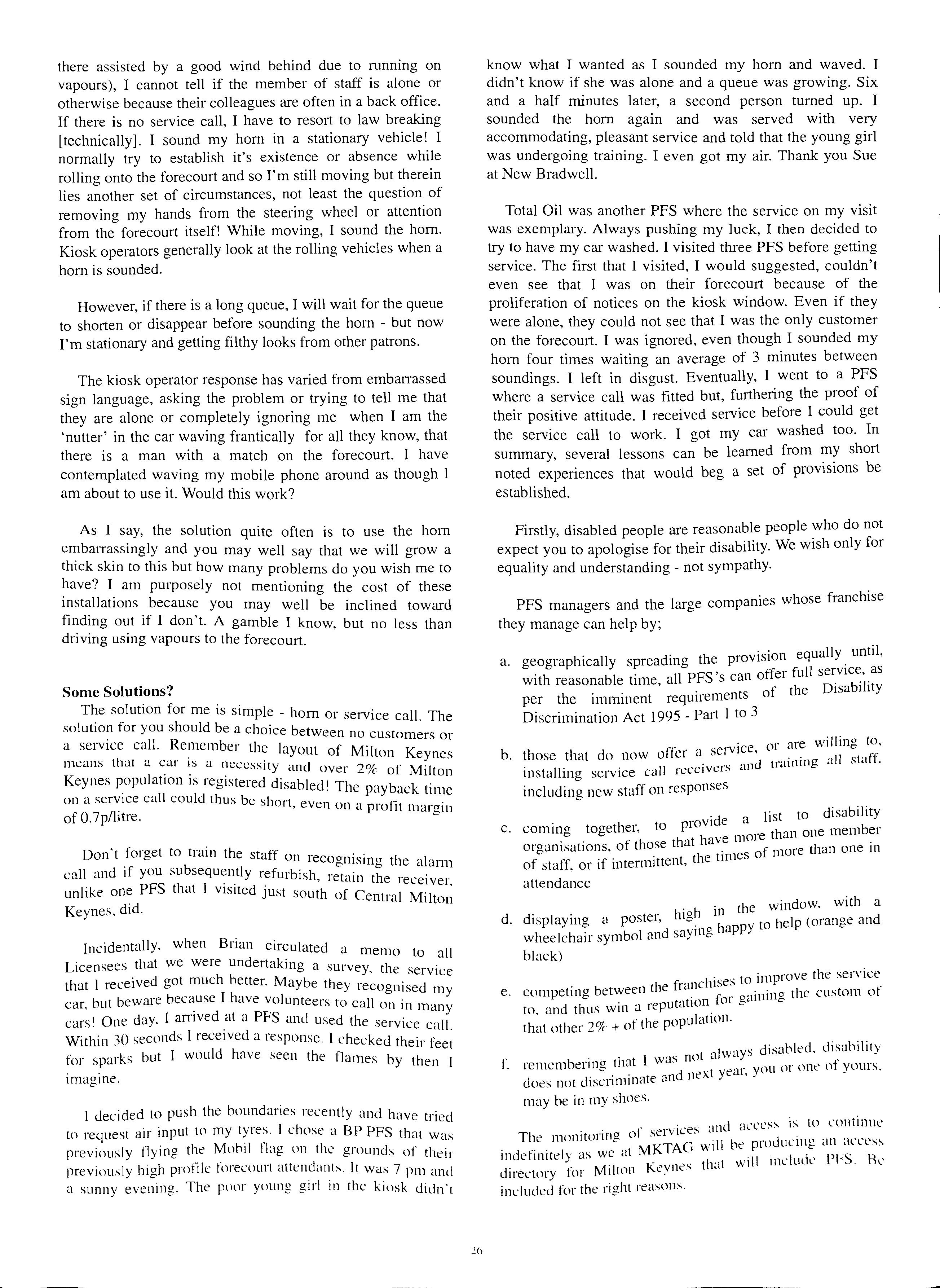
1 decided to push the boundaries recently and have tried to request air input to my tyres. I chose a BP PFS that was previously flying the Mobil flag on the grounds of their previously high profile forecourt attendants. It was 7 pm ancl a sunny evening. The poor young girl in the kiosk didn't
know what I wanted as I sounded my horn and waved. I didn't know if she was alone and a queue was growing. Six and a half minutes later, a second person turned up. I sounded the horn again and was served with very accommodating, pleasant service and told that the young girl was undergoing training. I even got my air. Thank you Sue at New Bradwell.
Total Oil was another PFS where the service on my visit was exemplary. Always pushing my luck, I then decided to try to have my car washed. I visited three PFS before getting service. The first that I visited, I would suggested, couldn't even see that I was on their forecourt because of the proliferation of notices on the kiosk window. Even if they were alone, they could not see that I was the only customer on the forecourt. I was ignored, even though I sounded my horn four times waiting an average of 3 minutes between soundings. I left in disgust. Eventually, I went to a PFS where a service call was fitted but, furthering the proof of their positive attitude. I received service before I could get the service call to work. I got my car washed too. In summary, several lessons can be learned from my short noted experiences that would beg a set of provisions be established.
Firstly, disabled people are reasonable people who do not expect you to apologise for their disability. We wish only for equality and understanding not sympathy.
PFS managers and the large companies whose franchise they manage can help by;
a. geographically spreading the provision equally. until, with reasonable time, all PFS 's can offer full _as . . . f the D1sab1hty per the unmment reqmrements o Discrimination Act 1995 Part I to 3
b. those that do now offer a service, or will111·ngt·tf0 1: and training a s .i • installing service call receivers including new staff on responses
. .d a list to disability c. coming together. to piovi e . than one member . . f h that have m01 e orga111sat1ons, o t ose . f more than one in of staff, or if intermittent, the wnes 0 attendance
the window, with a d. displaying a poster, hig? !11 to help (orange and wheelchair symbol and saymg happy black)
I s to improve the service . b the franc 11se. , e. cornpetmo etween , · · o the custom ot "' t· r· on tor ga111111,,, to, and thus wm a repu '1 1 that other 2o/c + of the populatwn.
t l\v·iys disabled. disability t·. I t I w·1s no a ' . remembering t rn '· . a. \'Oll or one of vours. . t ·111d next ye t, does not dtscrumna e ' may be in my shoes.
• • • 1 • ·es and is to L·ontinut' The mo111tonng of seI \ tL · · . MKTAG \vill producing an aL· 111det1111tely as we di 'll · ·I i, l°)l<'S 0 l' K, , l °'S that w1 lllL lll t , n directory tor Milton t) 1c included for the right reasons.
Conclusion
Clearly Sean's visits have established another area of concern where staffing levels play an important part which directly relates to the amount of time a disabled driver has to wait to receive service.
It al so bears out the need that provision for disabled drivers must be realised on approach to a Filling Station as well as entering a forecourt. By far the most effective method would be to display a recognised disabled notice on
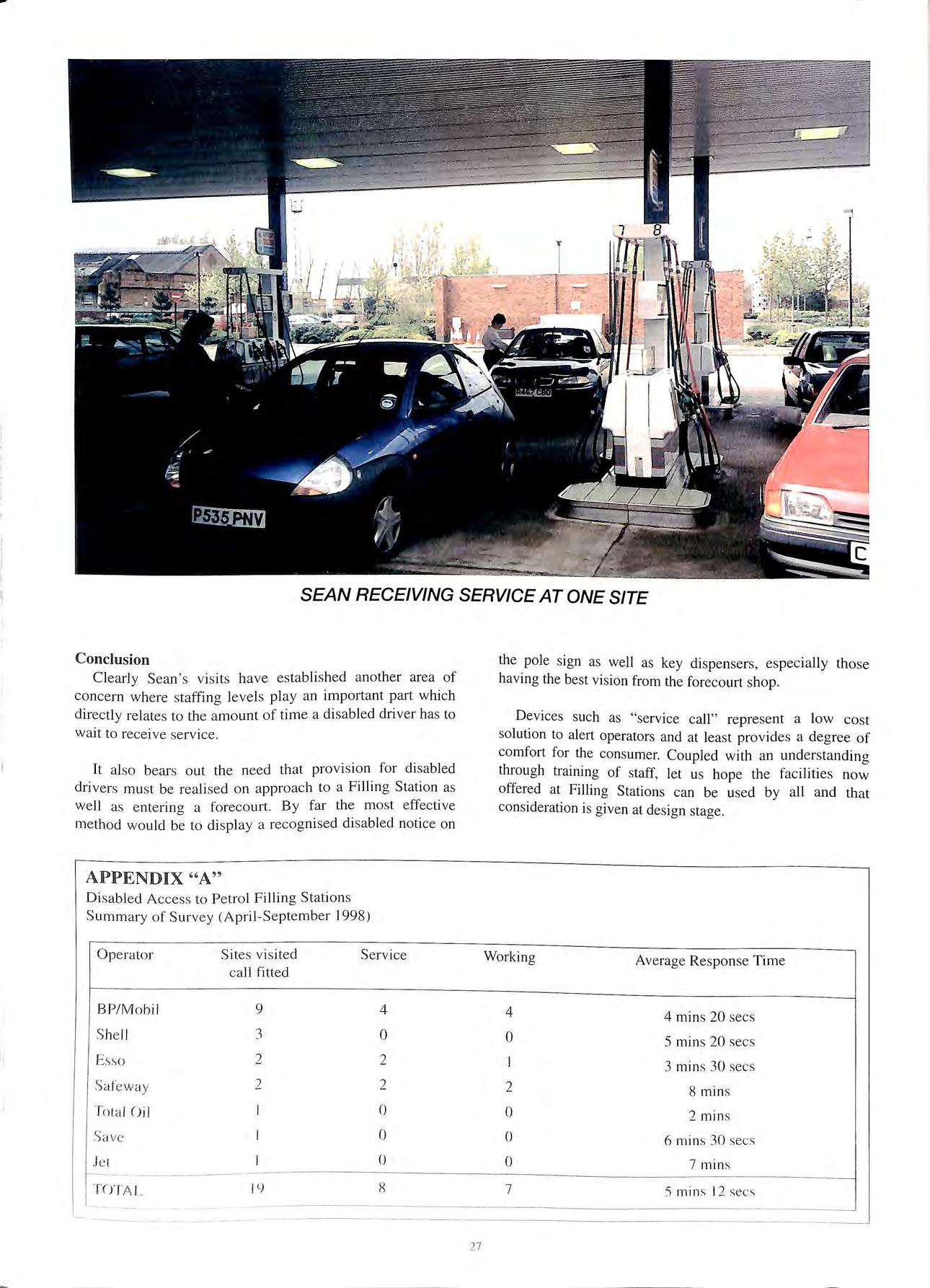
the pole sign as well as key dispensers, especially those having the best vision from the forecourt shop.
Devices such as "service call" represent a low cost solution to alert operators and at least provides a degree of comfort for the consumer. Coupled with an understanding through training of staff, let us hope the facilities now offered at Filling Stations can be used by all and that consideration is given at design stage.
SEAN RECEIVING
SERVICE AT ONE SITE
Di sabled Access to Petrol Filling Stations Summary of Survey (April-September l 998) Operator Sites visited c all fitted Service BP/Mobil S he ll Es so S afew ay To tal O il S a ve J e t TOTA L 9 3 2 2 19 4 0 2 2 0 0 0 8
APPENDIX "A"
Working Average Response Time 4 4 mins 20 sees 0 5 mins 20 sees 1 3
30 see s 2 8 mins 0 2 min s 0 6 min s 30 see s 0 7 min s 7 5 min s 12 sees 27
min s
CRITICAL ON SITE STAGE 1 b VAPOUR RECOVERY COMPONENTS
By Graham Stewart, Risbridger Ltd
Unless every element of a forecourt vapour recovery system is correctly integrated installed and maintained potentially serious incidents will continue to occur. As a manufacturer of forecourt products we draw the industry's attention to the design basis of some of our forecourt componenets that address these problems.
RIS Stop Overfill prevention device (OPD)
North American developed drop tube mounted OPD's have been available and used in the UK for over a decade. However many older sites remain without any form of overfill prevention despite the serious implications of this type of accident. The main problem has been the cost of on site modifications to existing tanks in order to fit the drop tube mounted OPD.
The RIS Stop approaches the retro-fit problem with a completely new design designed to minimise retrofit installation difficulties and reduce the total conversion cost. In addition the RIS Stop design incorporates on site test functions, vapour tightness and flow compensation, features not currently available with many drop tube mounted designs. These RIS Stop design features pre-empt tougher post year 2000 C.E.N. standards that will probably apply to the UK.
In most cases the RIS Stop valve and sensor cartridge screw into existing tank lid fittings without any disruption to existing pipework arrangements. As the valve is fitted externally to the tank future access, testing and maintenance is easy.
An OPD is of unknown benefit if it's operating function cannot be tested at regular intervals. The RIS Stop test feature is therefore an important advantage considering that a single ove1fill could cause thousands of pounds worth of environmental damage.
How long will an OPD remain in top working order? Most existing designs incorporate a rubber diaphragm of limited life to operate a flap valve. The RIS Stop has no dynamic seals at all in order to promote maximum long term reliability. The pressure activated automatic reset facility of the RIS Stop has also received special design attention to achieve a repeatable and dependable resetting peit·ormance preventing costly call-outs.

Further developments of the RIS Stop include versions specifically for new sites. direct fill points and an
electrically operated version for use in conjunction with electronic gauging.
For those interested in the long term benefits of high quality safety equipment we recommend you investigate the RIS Stop. There is much more to be considered about an OPD than the lowest unit price.
RIS Vent Pressure vacuum vent valve (PVV)
The PVV is a critical component of the modern forecourt. It's main function as part of a vapour recovery system is to prevent the unnecessary atmospheric discharge of petroleum vapour while allowing the tanks and pipework systems to operate within a safe pressure range.
Failure of the PVV can result in a range of serious problems including the cross contamination of_ tanks especially those with low level manifolded vent Imes or . l 1. b th dan<>erous and back flow spillage through fil mes, o e Al h <>h mostly ne<>lected potentially expensive problems. t OUe e h PVV requires penod1c m site mamtenance programmes t e ffi and reliability. The attention to mamtam full e 1ciency 1 recent H.S.E. 12 month service initiative we be ieve ids 1 d to fewer PVV relate beneficial to the industry and will ea incidents.
b automatically used as Conversely the PVV should not ef 11 vapour recovery h t cause o a ' a scape goat for t e roo 1 ·lm· symptoms can I y cases s1111 operational problems. n man : qui·pment. pipework ' "bl craugmg e be caused by mcompatl e 0 • oorly maintained road d . d . II t. on weaknesses, p esign an msta a' ' . d ··vers depmting from tanke1 '' tanker valve systems. 01 correct procedures. . f PVV Risbridger Ltd has · w design o In developmg a ne . , "th this type of product · penem:e WI drawn on extensive ex t)t- valves offers even . Th new senes ' c over a long penod. e 1 the existing successful • 1 f e1fonnance t rnn higher leve s o P .d to the followmg areas. · 1 · attention pai range with parucu aI
t trend towards manifolding •ty The crnTen Flow capac1 PVV to control the total system and the use of a smgle "tl fl 1w ntes of over 4000 l/min th PVV to cope w1 1 t reqmres e . . , le x tu ·1t10ns Fm e xamp 111 extreme 51 · ·. ·h 1 the t·mker operator fails tu , t ·nt delt venes v. eI ' . compa1 me 1 , 0 the vacuum side a e ·t the vapour return 1ost:. n conn c ·1 " , hi lit)·· is required as a nm1b111ed rehtively small I ow cap.i · ' f 100 IJmin is unlikely to bt' l'XL'el'lkd. chspenser flow i.ite o ' ..... , . , , . d f · 'af···t' th·1t two Pv V s ,11 e used p1.: 1 We recommen OJ s, .r ' maniti..llded system.
28
Relief Setting Due to the wide flow range capability required by the pressure side of a PVV the dead weight principal produces the most accurate relief pressure characteristics with minimal pressure-override. Spring loaded poppet designs are inherently less accurate.
Industry standard 35 mbar pressure relief -3 mbar vacuum relief
Noise Another important environmental concern is the operational noise of the PVV. Spring loaded designs with low inertia plastic poppets can often produce a high frequency scream at different flow rates due to harmonic effects. Other designs suffer from metal to metal contact noise producing a rattle characteristic.
Maintenance PVV's accumulate a wax like build up from petrol additives over time if not cleaned periodically. This can eventually clog the flame arrestor gauze and possibly lead to jamming of the valve components. Due to the exposed high level mounting position PVV's are also particularly vulnerable to corrosion damage. RIS Vents are protected with an anodised finish and the bore of the valve is PTFE coated. For these reasons routine maintenance is recommended. The latest developments of the RIS Vent PVV are quick release versions to suit 2" & 3" vent pipes. Installers can rapidly swap an installed valve by releasing it from the permanently fitted adaptor and refitting a new or recently serviced unit. This allows quicker and easier servicing, less danger to the maintenance personnel and an unprotected vent for minimal time.
meeting this standard should not be used in the UK. An important aspect of the flame arrestor is flow capacity. By nature the arrestor mesh is restrictive so to compensate for this it should be large in area to handle maximum flow rates, lack of sufficient capacity was a weakness seen in several designs investigated.
We suggest that when specifying or selecting a PVV the above factors are considered carefully along with the implications of a PVV failure. Initial minor cost differences may then pale into insignificance?

RIS Fit - Precision manufactured fittings
A constant difficulty facing the installer of modern forecourt products is the standard use of tapered thread rough machined maleable iron or seam welded steel fittings in the manhole area. These fittings were never designed to be compatible with theoretically vapour tight drop tubes or precision machined safety or gauging products. Low level vapour leakage associated with Stage lb systems is unfortunately common and potentially very dangerous. To assist installers Risbridger is developing a range of specialised fittings. Those currently available are:
RIS Fit barrel nipple - 4"
Incorporates a precision sealing surface to allow vapour tight fitting of a drop tube when used in conjunction with a 'Viton' 'O' ring. Overall dimensions are the same as a standard nipple and is suitable for retrofitting in some cases.
Under controlled conditions with new valves it is not difficult to achieve "bubble tight" sealing. However, in the working environment the PVV must maintain good sealing characteristics over a long period. Experience has shown that to achieve this high quality compatible seal materials, dirt tolerance and high standards of alignment are required. Consistent operation is the key.
Sealing
Cold weather Water pockets and freezing temperatures can easily lead to total seizure of a PVV. To combat this dangerous condition the PVV design needs to incorporate good draining characteristics and low friction working surfaces. Expansion I contraction rates between close fitting surfaces is also an important factor.
Flame arrestor A PVV is classed as an end of line arrestor subject to testing under BS7244: 1990. PVV's not
RIS Fit Weld nipple 4"
Similar to above but suitable for new tanks only.
RIS Fit Vent adaptor
2"
The lack of man lid access holes is another constant problem with older tank installations and has resulted in the now common lid boring modification work. To avoid this substantial cost Risbridger has developed a conversion for vent connection that allows an additional tank entry pomt for a level gauging probe or similar. whilst not restricting the vent flow significantly. Overall dimensions are the same as a standard 2" M & F elbow.
1111
2()
WYATT ENGINEERING FUEL SERVICES
By Roger Wyatt
Vapour Flow Monitoring An Accurate and Simple Solution
Stage I B vapour recovery systems have been in use in the U.K. for many years now and despite criteria for their efficiency having been set, and despite the requirement for regular system testing , it has not been possible to accurately gauge the efficiency of any of these systems.
There have, of course, been the crude methods of listening for the pressure vacuum valve opening and of placing a bag over the end of the vent. Both of these method s are highly questionable You can't hear a valve opening if it is already jammed open or its internals have collapsed and fallen down the vent ri ser. As for the ' bagmethod ' even if you have a known leak-proof bag , and seal it to the vent pipe this would only tell you if vapour was, or was not , escaping, it would give no indication of efficiency Surely the industry can't seriou sly advocate such method s in these pollution conscious days?
There is now a reliable and acc urate method of testing vapour flow which can be used to verify and certificate new and existing systems, and can also be used to monitor sen s itive s ites on a permanent bas is.
VAPOUR FLOW METER ON MANIFOLD
B ks Metal-tube
Vapour Flow Monitoring via 1 00 Flowmeter

· 1 · b · aturina a 111 ete1 u e Ill
This variable area flowrnetei e · 1 accurate ,, , 1 ble as a strai g 1 ' · 1 16 sta111l ess stee l. is av c1 1 a '· flow nte It is a lso . . . . d . la y of vapo u1 ' unit g1v111g an in stant 1sp hi ch ca n provid e It ·native fo1 rn s w avallable lll vario us a ei ' vo lum e. and a larm _. fl w rate vapo u1 e lectrom c feedba c k o f 0 · d a ll owable limit s. Th e I I Id I flow rat e excee ' s1g na s s 10u ti e 1 test in strum e nt. and d venf- 1ca t1on anc mete1 can be use as a 1 , fitt e d in th e vapo ur . . Id be pe rman e nt ) ce rt a111 vers ion s cou e rm a ne nt reco rd of recovery manifold on s ites w he ie a p em ission s is re quired
1 t 1 · 1 fhna e d or threa de d fmmats crl te s a re avai a 1 e 11 ' b 1e me 1 . the vent co nn ec tton DI th e and are normall y mstall ed at . . . , . ·r lei The test rn e te 1 uirnmencc:s lll vapo ur recove ry 111an1 o · _. · _ 1 sure in the vapo ur mantlold 11..·ad1v;, ehs pla y once ne p1 es 35mb and th e re for e exact ly rn11111 cs th e nik u l t\w pressure/vacuum va lve in the syste m
VAPOUR FLOW RATE TESTING
ANALOGUE & ELECTRONIC VAPOUR FLOW METERS
Approvals:
Cenlec li sted , intrins ically safe EEX ia 11CT4 IP67 .
Certified to EN 50014 and E N 50020 for all e nclosure o pt ion s
C e11ified CE m ark; EMC directi ve.
Flow Rate M easurement Capability

A ll fl ow rates a pplicable to both umestri cted vent s yste m s and to those fitted w ith Stage 1B Vapo ur Recovery equipmen t.
Typical A pplications:
It is now po ss ibl e to gauge vap o ur fl ow rates under co nditi o n s of vapo ur-balancin g failure and to then set all owa bl e fl ow -rate para mete rs (e.g. 5 % or 10% of full rate), w hi c h can the n be measured w hen the vapo ur-recovery s yste m is co nnec te d du rin g ta nke r off-l oading.
T hese m eas ureme nts c an be used to specify the number of tank s th at c a n be fi ll ed s imul ta neo usly witho ut exceedin g per m iss ibl e va p o ur e m iss io n rates on indi v idu al sites , and a ls o fo r th e o ri gi na l an d pe ri od ic testin g a nd certi fica ti on of a ll S tage I B S ys te m s.
!Furt her C apabilities
T he m e te r ca n be fi tted w ith elec tro ni c eq uipment to pro v ide tra n s mi tte r, al a rm a nd p ul se o utp uts
T he a la r m fa c il ity ca n be set to g ive a s ignal when perm1ss ib le va pou r re lease leve ls are exceede d ; this co ul d be a fe ature o f a pe rm a ne ntl y fitt ed instrum e nt and co uld dri ve a n a uclib le a larm a ncl a lso be co nnec ted to a dri ve r co nt ro lled cle live ry sys te m
T he p u lse o ut pu t c a n he use cl to qu a nt ify th e vo lu me o f vapo ur d isp laced and ;:ill me a c. ure me nt in fo rm ati o n ca n be
tra nsmitted to appropri ate destina ti o ns, or c an be downloaded to a hand held co ntroller as a totali se r functi o n .
The meter can al so be fitted in the va po ur return line in order to meas ure the fl ow rate and/ or qu a ntity o f vapour returned to the tanker.
Vapour Flow Rate Examples
(Taken fr om tests carried out on site during tanke r offloading):-
Unrestricted Vent Pipes. (No Vapou r R ecov e ry Sy ste m use) :-
Tanker connected to one tank , direc t 4 " fill pip e fitt ed with overfill preventi on valve , fu el deli ve red into ta nk a t ra te of 1000 litres per min fl ow me ter readin g : 60 M 3!Hr. Therefore , if connected to a Stage I B Va pour Reco ve ry Sys tem, and ass umin g an allow abl e 5 % va po ur re leas e, the meter reading mu st not exceed 3M 3/Hr x numbe r of tanks being fill ed simultaneously.
Meter Development and Sales
T he appli cation of the Broo ks Fl ow me te r for Pe tro leum Forecourt Vapo ur Recovery mo ni to rin g has been deve lo ped by Wyatt E ngin eerin g Fue l Se rvices in li a ison with F lotec h So luti ons Ltd, Th e Brooks In stru me nt U. K. Di stributo rs
The meters fo r all fo rec ourt ap pli cati o ns w ill be m ar ke ted e xcl usive ly via Purfl ee t Fo reco urt Se rv ices Ltd . Wya tt Engineerin g Fuel Se rvice s w ill a lso be offe rin g a co mprehensive Vapo ur Recov e ry Sys te m tes ti ng. mo nitorin g and certifi cation service (in clu d ing pe rmi ss ibl e tanke r off loadin g conditions) fo r both ex istin g a nd ne w v ap o ur recovery in stall at ions, and it is a ntic ip ated tha t these se rv ices will also be prov id ed by othe r co ntrac tors now tha t the Bro oks mete r is co mm e rc ia ll y ava ila b le
I
l
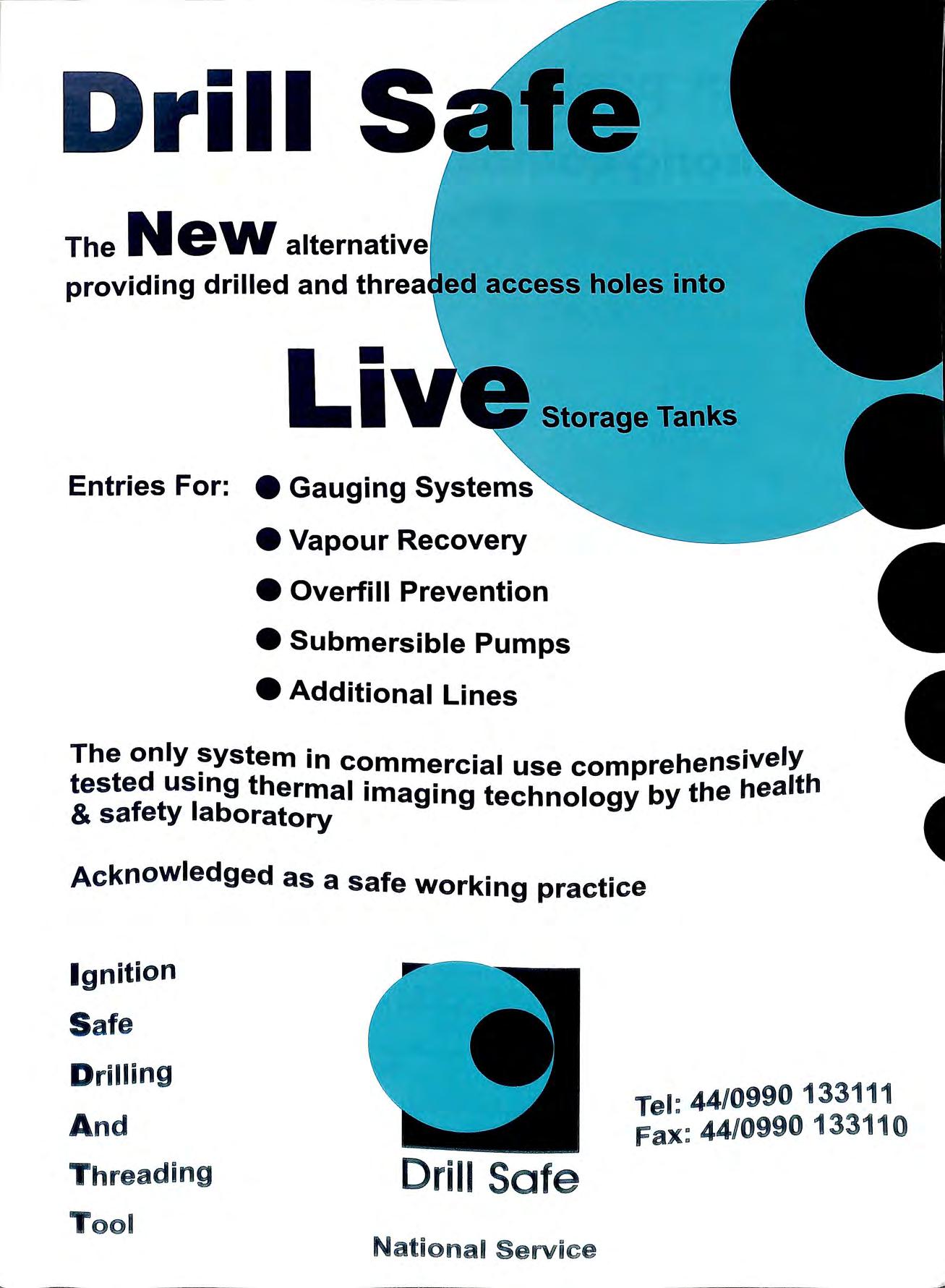
Entries For: 9 Gauging Systems 9 Vapour Recovery • Overfill Prevention • Submersible Pumps •Additional Lines The only in commercial use comprehensively tested using thermal imaging technology by the health & safety laboratory
A c knowledged as a safe working practice I gn iti o n Safe Drilling And Threading Tool Drill Safe National Service Tel: 44/0990 133111 Fax: 44/0990 133110 _;J
,

ELGEF® Petrolockthe strong combination Th e e con o mic a l sys t e m • H ig hl y fl ex ibl e pip ing syste m for e ffi c ient in sta lla t io n • Fully d ev e lop ed mo dular sys tem and integ ra te d p ipe fix ing up to d63 mm for minim u m a ss em bl y ti me • Appl icati on- spe c ific intern a l c o ati ng o f the p ipes for high e nv iro n me nta l com p ati b ili ty And all without hav i ng to mak e any comprom uses on safety ELGE F Petro lock is the p owe rfu l c o mbina tion of ELGEF Plus electro fus ion fitti ng s from Geo rg Fi sche r an d HA LOCK lam ina ted p ipes from Ha llingpla st AS. Geo rg Fisch er Piping Systems Ltd , CH-8201 Sc hoffhou sen /Swi tze rlo nd Phone +4 l 10152-63 l l l l 1, Fox + 4 1 10152 631 28 00 e rnrJil inforey piping geo rgfischer.com, Internet: http:! /www.pip ing.georgfische r.com GEO RG FISCHER +G + Integrated safety M ode rn fu sion equ ipm e nt and reco rded res ults prov id e th e b as is for integra
to compr
he nsive
-s ite doc u menta t io n Excellence i n piping systems
ted qua li ty a ssuran ce fro m th e ma nufact urer th roug h
e
o n
DRIP STOP diesel nozzle
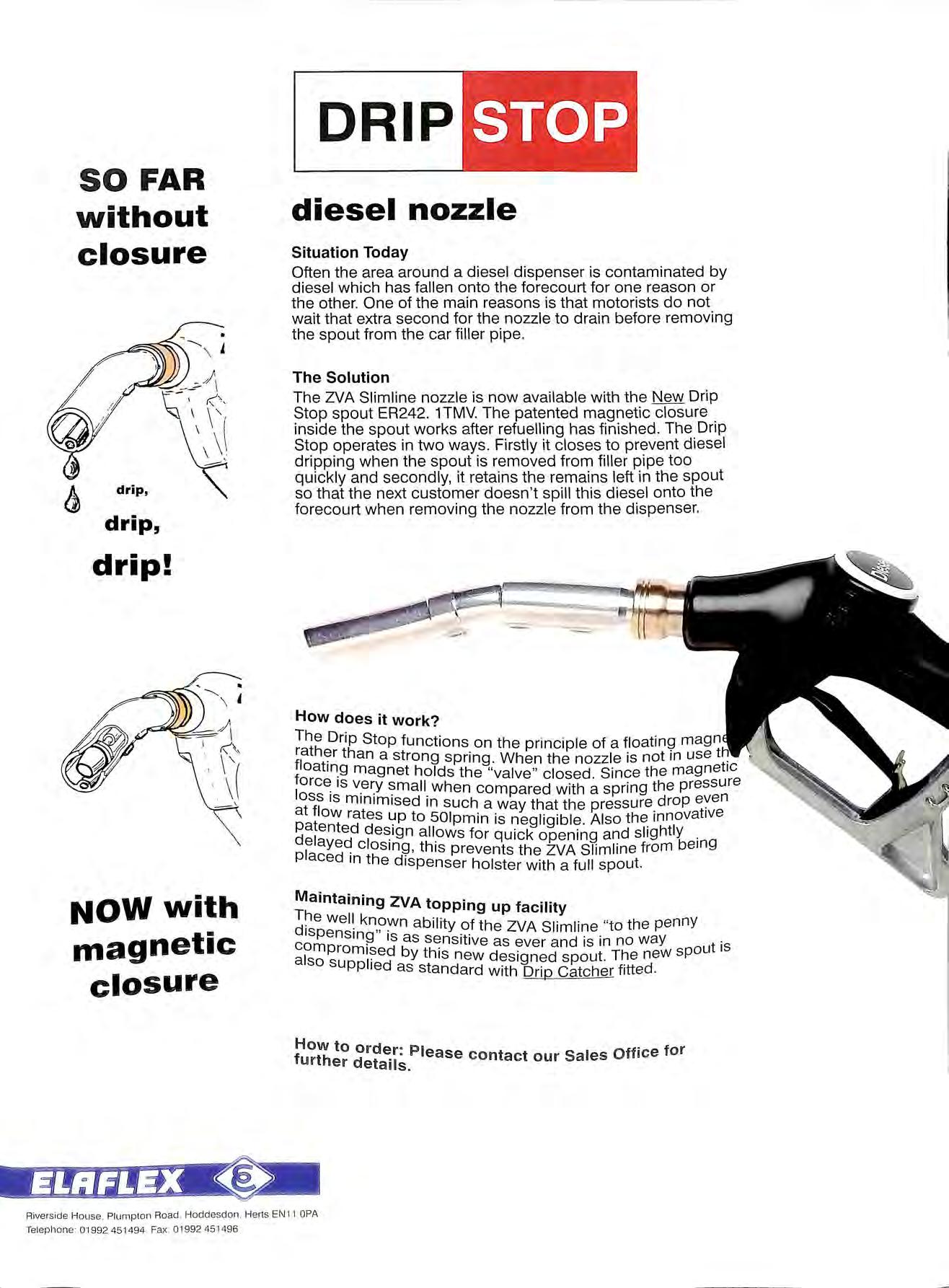
Situation Today
Often the area around a diesel dispenser is contaminated by diesel which has fallen onto the forecourt for one reason or the other. One of the main reasons is that motorists do not wait that extra second for the nozzle to drain before removing the spout from the car filler pipe.
The Solution
The NA Slimline nozzle is now available with the New Drip Stop spout ER242. 1TMV. The patented magnetic closure inside the spout works after refuelling has finished. The Drip Stop operates in two ways. Firstly it closes to prevent diesel dripping when the spout is removed from filler pipe too quickly and secondly, it retains the remains left in the spout so that the next customer doesn't spill this diesel onto the forecourt when removing the nozzle from the dispenser.
How does it work?
Drip Stop functions on the principle of a magn than a strong spring. When the nozzle is not 1n use f magnet holds the "valve" closed Since the magnetic is small when compared with a spring the pressure ss is m1n1mised in such a way that the pressure drop rates to 501pmin is negligible. Also the_ innovative nted allows for quick opening and slightly closing, this prevents the ZVA Slimline from being p aced in the dispenser holster with a full spout.
ZVA
topping
up facility
ability _o_f the NA Slimline "to the penny ro 8 is as sE'.ns1t1ve as ever and is in no way t is also m\sed by this new designed spout. The new spou PP ied as standard with Drip Catcher fitted.
dordc;:r: Please cont a ct our Sales Office for r eta 1is
SO FAR without closure drip, drip! NOW with magnetic closure
Riverside House , Plumpton Road Hoddesdon Herts EN11 OPA Telepl1one : 01992 451494 Fax : 01992 451496
PIPELINE
The product range consists of a range of pipe, fittings and tooling in the size range 50mm, 63mm, 90mm, I IOmm The pipe outside diameters are based upon BS 5556 and ISO 161 /I. All of the pipe and fittings are black pigmented Black has been carefully selected as it affords the best and most cost effective solution against environmental UV degradation, that can occur with polymers.The polymer has also been carefully selected to provide the 30 year design life requ ired by the specifications of the industry.
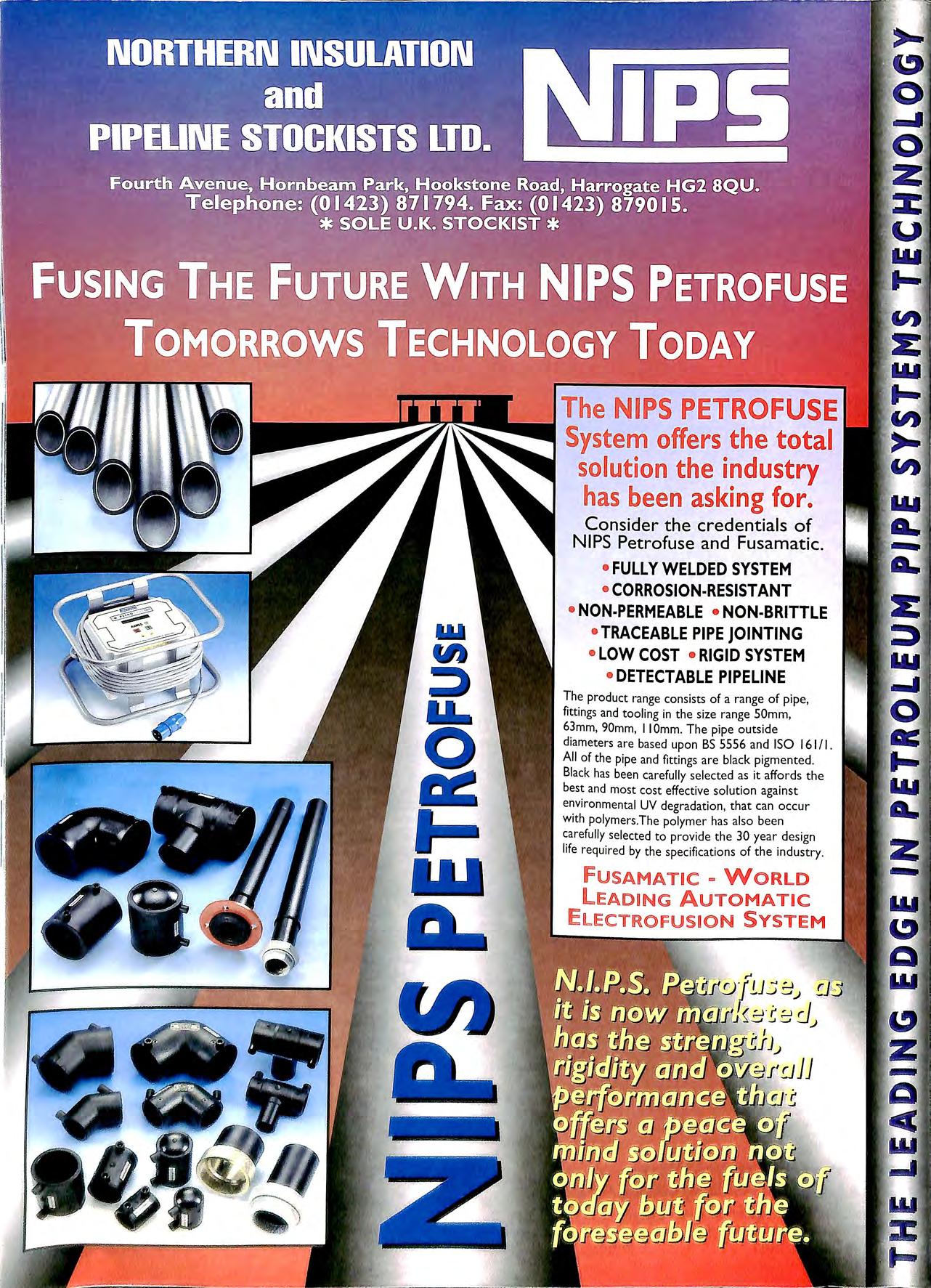
NIPS PETROFUSE System offers the total solution the industry
• FULLY
•
• NON-PERMEABLE •
• TRACEABLE
• LOW COST •
•
The
has been asking for. Consider the credentials of NIPS Petrofuse and Fusamatic.
WELDED SYSTEM
CORROSION-RESISTANT
NON-BRITTLE
PIPE JOINTING
RIGID SYSTEM
DETECTABLE
fUSAMATIC = WORLD AUTOMATIC SYSTEM

Tank Gauging and Leak Detection LIQUID FILLED AND DRY AIR PRESSURE LEAK DETECTION SYSTEMS FOR STEEL OR GRP DOUBLE SKIN TANKS I I I ' 40 60 / ' 20 soI cf G site 7Cea ,,,,.... I LEAK DETECTION SYSTEMS FOR DOUBLE CONTAINMENT PIPES, ACCESS CHAMBERS AND PUMP ISLAND SUMPS. " PROLEVEL " TANK GAUGING SYSTEM FOR UP TO 16 TANKS PC AND MODEM COMPATIBLE FOR LOCAL AND REMOTE MONITORING. " TANKGUARD' ' LOW COST ELECTRONIC TANK GAUGING SYSTEM " TANKMATE 160" SELF POWERED TANK GAUGE FOR DIESEL AND GAS OIL. INTERCEPTOR AND OIL SEPARATOR LEVEL ALARM SYSTEMS. BS EN ISO 9001 QUALITY ASSURANCE. ALL SYSTEMS MEET RELEVANT SAFETY STANDARDS. EEx ia /IC FOR ZONE 0 AND EEx ib /IC FOR ZONES 1 AND 2 . .... .... ... ... .. .... .... ..... .... ..... .. ...... ..... Why not talk to the specia/ists:EUROGAUGE COMPANY LIMITED IMBERHORNE LANE , EAST GRINSTEAD , WEST SUSSEX RH 19 1RF Tel: 01342 323641 Fax: 01342 315513 Qu ality services for tod a y's forecourt HIGH QUALITY RE-IMAGING OF PUMPS, CANOPIES, SHOPS POLE SIGN ERECTION & MODIFICATION PLANNED IMAGE MAINTENANCE PROGRAMMES PUMPS & EQUIPMENT - HAULAGE, STORAGE & DISTRIBUTION Valley Road, Cinderford, Gloucester G 14 2NY Telephone : 0594 826364 Fax: 0594 822807

You deserve h the best, wysettle for less ... THE LEADER IN PETROLEUM TANK MANUFACTURE Including: • SUCTION PIPES e FILL PIPES • OVERFLOW PREVENTION • CHAMBERS • GROUND COVERS, and much more ... --- - -----
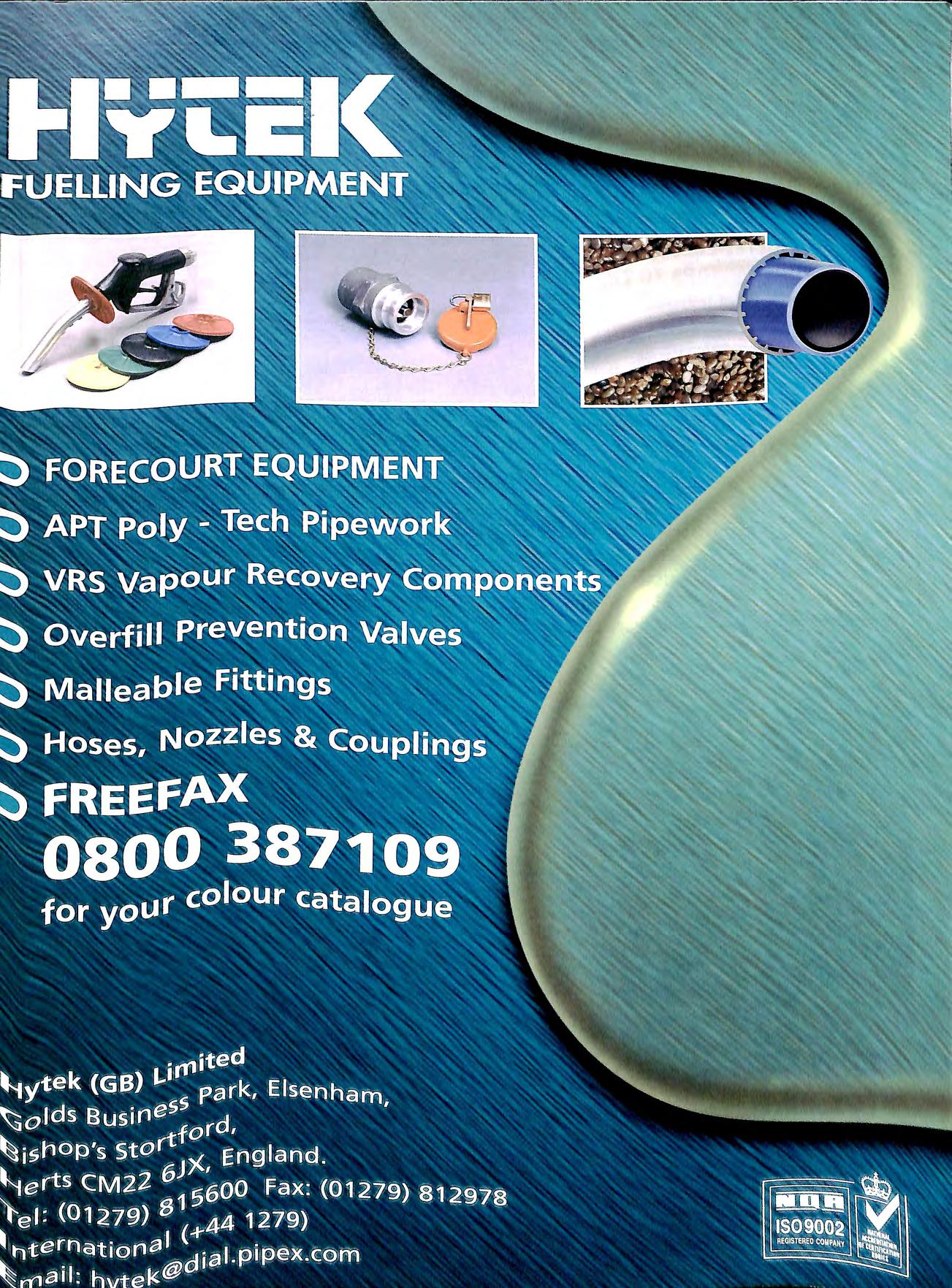
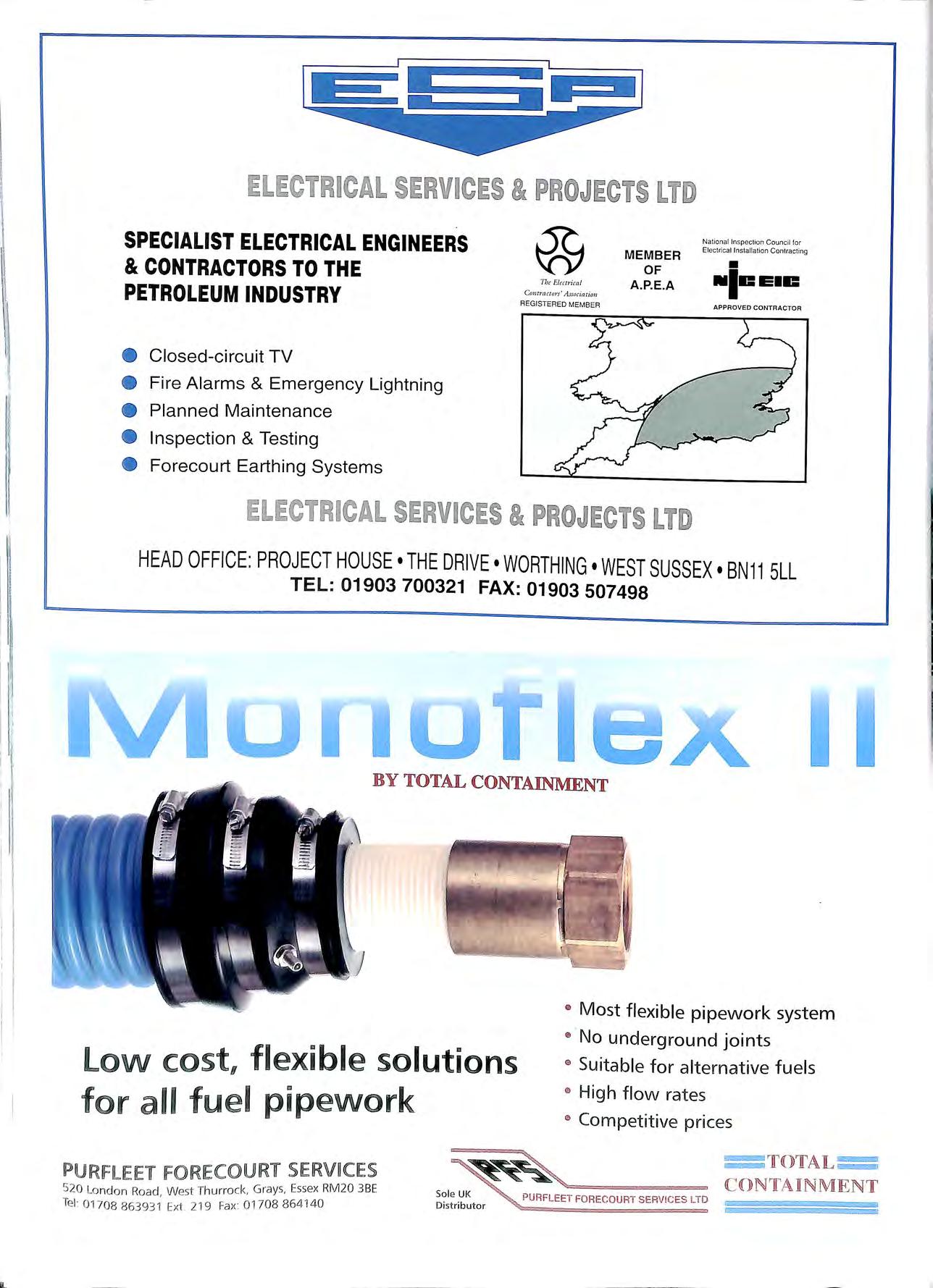
\ \ I II "Die Eftetritnf MEMBER OF A.P E.A National lnspeclion Council lor Electrica lnstal!alion Contracting SPECIALIST ELECTRICAL ENGINEERS & CONTRACTORS TO THE PETROLEUM INDUSTRY Co 111rnct111"1 'AJJor iario11 • •11:E11: REGISTERED MEMBER APPROVED CONTRACTOR • Closed-circuit TV • Fire Alarms & Emergency Lightning • Planned Maintenance • Inspection & Testing • Forecourt Earthing Systems HEAD OFFICE: PROJECT HOUSE• THE DRIVE• WORTHING• WEST SUSSEX• BN11 5LL TEL : 01903 700321 FAX: 01903 507498 BY TOTAL CONTAINMENT Low cost, flexi bl e so lution s for all fuel pipework PURflfEiET fOIRIECOUIRT 520 Lo ndon Road , w est Thurro ck, Grays, Essex RM20 3BE Tel : 01708 86393 1 Ext 219 Fax 01708 864140 e Most flexible pipework system e No underground jo i nts a Suitable for alte rn ati ve fuels "' Hi g h flow rates (9 Co mpetit ive prices PURFLEET FORECOURT SERVICES LTD -= TOTAL CON1f/HN1V!IJE N 'f
Since pioneering the concept of the pre-engineered canopy back in the early 60's, continuous development has seen this simple form of weather protection evolve into the bright, sophisticated image projecting structure that it is today.
Over the years Conder has applied this same philosophy to other forecourt elements with the objective of improving quality whilst reducing construction time. These now include shop and car wash enclosures, factory prepared for rapid site assembly, pump island surrounds with integral cradles and sumps and baniers to guard vulnerable fuel dispensing equipment
In protecting the environment, Conder's resolve has never faltered and is demonstrated by the most advanced range of light liquid separators, complete with coalescing fitters, automatic closures and pollutant level alarms. Add to this the GRP access chambers, sitt traps and a first class repair and refurbishment service the forecourt cou ldn't be better protected.

CONDER FORECOURTS ABBOTIS BARTO N HOUSE WORTHY Rl>AD W IN CHE STER HAMPSH IRE S02J 'SH nB.: @H62 863£ 77 FAX Ol 0 o 2 841

. --------------. . --------------- ·
IN OLD TANKS? NEUTRATANK RG22
tank abandonment RG15
RG8
•
tanks
INSTALLING NEW TANKS? 'fHERMO'fANK RG30 for backfilling tanks Absorbs hydrocarbons High rigidity and cohesion Insulates tanks -USE BACEL HARDFOAM Don't slurry in a hurry - call now for a free estimate
FILLING
for permanent
for tank mothballing
for safer tank excavation
Lightweight and high loadbearing • No need to remove lids or de-gas
• Fast clean application
Line
tanks with double
GRP and save money +
the expense
replacement +
+
+
+
+
+
+
+
+
+
LIVE E R JE TANK CLEANING using fibre optic camera/pump system Safe precision remova l of water and sedime nt No lid remova l, minium disru ption National coverage, version for large storage tanks Also sui table for Derv gas and chemica l tanks Guaranteed to remove water Competitive prices 4/5 Gough Square, London EC4A 3DE Tel: 0171 583 2007 Fax: 0171 583 2008
PETRO TANKLINE
your
skin
Effectively provides new tanks without
and di sruption of total tank
No requirement for expensive Civil Works
Much less disruption to site
Less costly than total tank replacement
Fast installation Usuall y less than one week No need for site closure
Continuous vacuum tank monitoring mean s no more periodic tank te sting
Can be used to make pe1forated tanks (within reason) as good as new
Tank modifications possible
No need to survey tank prior to Jjning as if tank is damaged it can be repai red
30 year li fe expectancy
S year war ranty on labour and material s

J & NJ WlllLILllAMS LID WILLJIAMS SOUTHERN 1LTD Building & Civil Engineering Contra ctors Main Contractors to the Petroleum Industry fo r ove r 2 5 y ears Desig n & Build/ Tendered/ Negotiated Management Car & Je t Wa sh Install t a ions Tank Removal & Disposal Fuel Ta nk Insta llations Commitment to Quality 0 BS EN ISO 9002 : 199 4 Area of Opera tion Safe ty Proce dures D Client Drive n RJ & NJ Willia m s Limi ted Tel: 0 1 752 2 0 13 0 0 Fax : 017 52 201 2 Williams Sou th ern Li m ' t d 99 Te l: 01635 87 1 828 F t e ax: 0 16 3 5 8 717 84 Lincoln Partners Limited 1 Crossways House Enderby Road Blaby Leicester England LES 400 Tel: 0116 277 2700 Fax: 0116 277 2900 THE FASTEST WAY T O :• Put 2" ,3" & 4" threaded entries into tank lids • Remove drop tubes II Install & supply OPD's (including 4" steel tubes) • Remove any e x isting sockets Iii Safe accepted by HSE & a ll a p propr iate safety aut hor it ies • Q ui ck Ill Cost effect ive IT MAKES GOOD SENSE TO USE..... i, tell H udson Hi ll H edinghani Road,W eth er-sfr eld , Braintree, Ess ex C M? 4EH Tel: (013 7 1) 850921 Fa x (0 I 37 1) 8507 19


" +' Environmental Engineering & Applied Science Extensive experience in undertaking specialist contaminated land remediation in the UK and Europe provides clients tried and tes'.ed methods, applied by specialist staff, for dealing with polluted land and groundwater. • Site assessment on petroleum retail sites and industrial premises • Fully costed remedial design proposals • Execution of remedial works with minimum disruption • confidential prompt and professional service SPECIALISTS IN CONTAMINATED LAND CONTRACTING Telluric Ltd , Meandros House, 54A Bute Street Cardiff Bay, CF1 6AF ' Tel: 01222 303010 Fax: 01222 303011 Toureen (Plant) Ltd. CIVIL ENGINEER ING & DEMOLITION CONTRACTORS SPECIALISTS IN DEMOLITION AND DECOMMISSIONING OF PETROL STATIONS e Tank De-gassing an d Remova l e Tank Installation e Tank C leanin g· e Gas Free Certification e Forecourt Breakout and Reinstatement 24 7 Chapter Road , Wille sden , London NW2 5LU Tel: 018 I 45 I 2002 Fax 0181 459 2 146 Mobi le: 083 1 355 655 0777 5993030 0374 269736 WE CAN SUPPLY THE FOLLOWING CARD READERS DISP ENSERS (ALL OPTIONS A\AILABLE) TANKS ELECTRONIC LOCKS ELECTRICAL INSTALLATlONS CIVIL ENGINEERING PIPE INSTA LLATIONS CONSULTANCY SERVICE TO COMPLETE LPG INSTALLATIO NS TEL: 01905 729662 SPECIALIST IN ALL TYPES OF PETROLEUM INSTALLATION CONTRACTING & MAINTENANCE. INDUSTRIAL I COMMERCIAL I AIR CONDITIONING. WITH OVER 20 YEARS EXPERIENCE 24 HR. 7 DAY SERVICE ALL YEAR CALL-OUT FAC ILITY. .. liiiil
TANIK
TANK
TANK UN!NG
Installation of retro fit Double or Single Skin lining systems using the well proven "ADISA "
systems used over a 20 y ear period by major oil companies throughout Europe .

One Albion Street Failsworth Manchester M35 OEG
TEL: 0161 684 8534 FAX: 01616884101
TANK
All equipment has been d e signed and constru cted to be grante d UK and TUV European Petroleum Re gul ation approval for product uplift and transfer in conjun ction with inflammable liquids belonging to all dangerous c at e gories.
TANK
All wor ks und ert aken in stri ct co mpli anc e with HSE and Petrol eum Regul ati o ns in c l ud i ng " OCTEL " Leaded Gaso li ne Tank Cle an ing sta n da rd an d Tu V approva l
Ne w tan ka g e install e d to suit c li e n t a nd Petroleum Offi ce r lo ca l l ocat io n c onstru ction req ui re m e nts /
Dependab le se r v ice na tion w id e w ith fu ll y ap p ro v ed a n d documented proced ur es inc l ud i ng co l d cutti ng, s l u rry o r foam inf ill ing and remova l o f so li d fil l ed tanksTANKUNI G SYSTE M S I /( I I J',/\I( I r' /{[('fr/',['" I/ I J 11'} I/ ff I I/< ;.: !IH-1 A(J/ I

National Inspection Council fer E ectrical nstallation Contracting E•C APPROVED CONTRACTOR UNIT 10 MERTHYR TYDFIL INDUSTRIAL PARK PENTREBACH MEMDER OF MERTHYR TYDFIL • BR<nSH SH>TY COU N C<C MID GLAMORGAN CF48 4DR ,l,f: \'? ,, y L'"\'ESTOR 11\ PEOPLE Telephone: (01443) 692008 Fax:(01443)692159 E.Mail: gcs.ltd@btinternet.com Fuel tank, pipework & pump installations. Stage 1 B vapour recovery installations. Fuel monitoring & metering equipment. t:t' 'JJt:t1 1 !JjfF' 'J]Ef 1 'JJEf 1 'JJtf' 'JJttB 'Jia&i 'j) J YJ a a 45 Fuelling planes, trains or automobiles? (or anything else for that matter) range approved and derv or lu Range of speeds from 45LPM to 140LPM All latest standards, 1s m anufac tured out of stainl ess steel and bu il t to las · For more infor m ation p lease contac t PUMPTRONICS at Fo lgate Road, North Wa lsha m , Norfolk, NR28 OAJ . Tel: 01692 500640, Fax: 01692 406710.


Fuel Storage Tanks oO YOU HAVE coRROSION WORRIES? CATHODIC PROTECTION NEED? _HEAVY LIFT PROBLEMS? FIBRE REINFORCED PRODUCTS LIMITED Separators and Interceptors DO YOU WANT TOTAL CORROSION RESISTANCE? ZERO TANK MAINTENANCE? LIGHT WEIGHT/ EASE OF INSTALLATION? DOUBLE WALL TANK INSTALLATI IF YOU NEED DOUBLE WALL TANKS WE NOW HAVE THE ANSWER e Full 360 ° interstiti al space monitored by air press ure or liquid head. Me ets EN976 , HS(G)4 1 and MOD/DMG14 speci fi cat ions Easy to in sta ll in granular material pea gravel OR c rushed stone No corrosion , no cat hodi c protection and no protective coati ngs to damage • 30 year Warranty plus m1n1mum 50 year Design Life (EN976 requirement) Compet itively Priced · For furth er det ails contact : FIBRE RE IN FORC ED PRODU CTS LIMITED 2 WHITEH OUSE WAY, SOUTH WEST INDUSTRIAL ESTATE PE TE RLE E. CO DURHAM SR8 2HZ Comprehensive Eco-Cep tion range Eco-Cepto r Class I and C lass 11 Full Retenti on Interc ep tors Eco-Pass C lass I and Class 11 By-pass Interceptors Independ ently tested to prE N858 and PPG3 pe1-form ance Approved by LF C DA fo r Fo reco urt use TEL FAX 0191 58653 11 01 9 1 5861 274 @If/· ! E Mail· frp@octacon co ul<

Durapipe - S&LP EMCD WHEATON • environ A\n1ea11on «>PW FUELING COMPONENTS EUROPE B V. A DOVER RESOURCES COMPANY AND MANY MORE The Worlds Major Forecourt Products from the UK 1 s Major Distributor D Berry & Co (P ipe Fitti ng Suppli es) Ltd , Unit 130, Middlemore Industria l Estate, l<entish Road, B' ham 821 OAY. Te l: 0121 55844 11 Fax : 0121 555 5546. H J )?\ )

WHEN Y OU REQUIRE QUALITY a Petroleum I Speciality hoses Roadtankers I Pipe fittings Hose fittings 00 E LAFLE X LlD Rive rs ide Hou se Plu mpton Road . Hodd esd on Herts EN 11 OPA Te lep hone 0992 451494 Fax 0992 451496 Telex 2529 7 PER M EX G I
inside story..
100% lnf G fili er for zero permeability. \l \
UPP 16 years experience with over 5000 installations in SO 1 ' countries worldwide. •
Extra - lined pipe in a range of four sizes, giving zero •• permeability for zero expansion in fuel, suction and pressure lines. Optional unlined pipe for vent and vapour recovery lines. _____,,
Pressure rated to P 10, easily exceeding pressure generated by submersible pumps. ______
Wide choice of diameters and lengths, including straight lengths and coils. '
lline number, shift number, week and year of manufacture for full traceability and
markings for ease of on-site measurement and quality during '{Y'1 ufacture.

,. I , the o ti tside tells
ii
Metre
J Approva Secondary c ta0 nedl UPP fulfils every requirement for , mo ring and recovery. Engineered for use with most leak detection systems
PEI 'ROq':ECHNIK




































































